Quanta Computer AR5B95 802.11 N 1X1 PCIe Minicard Transceiver User Manual S10 3 UserGuide V1 0 EN 1470027
Quanta Computer Inc 802.11 N 1X1 PCIe Minicard Transceiver S10 3 UserGuide V1 0 EN 1470027
Contents
- 1. users manual
- 2. User Manual 1
- 3. User Manual 2
User Manual 1
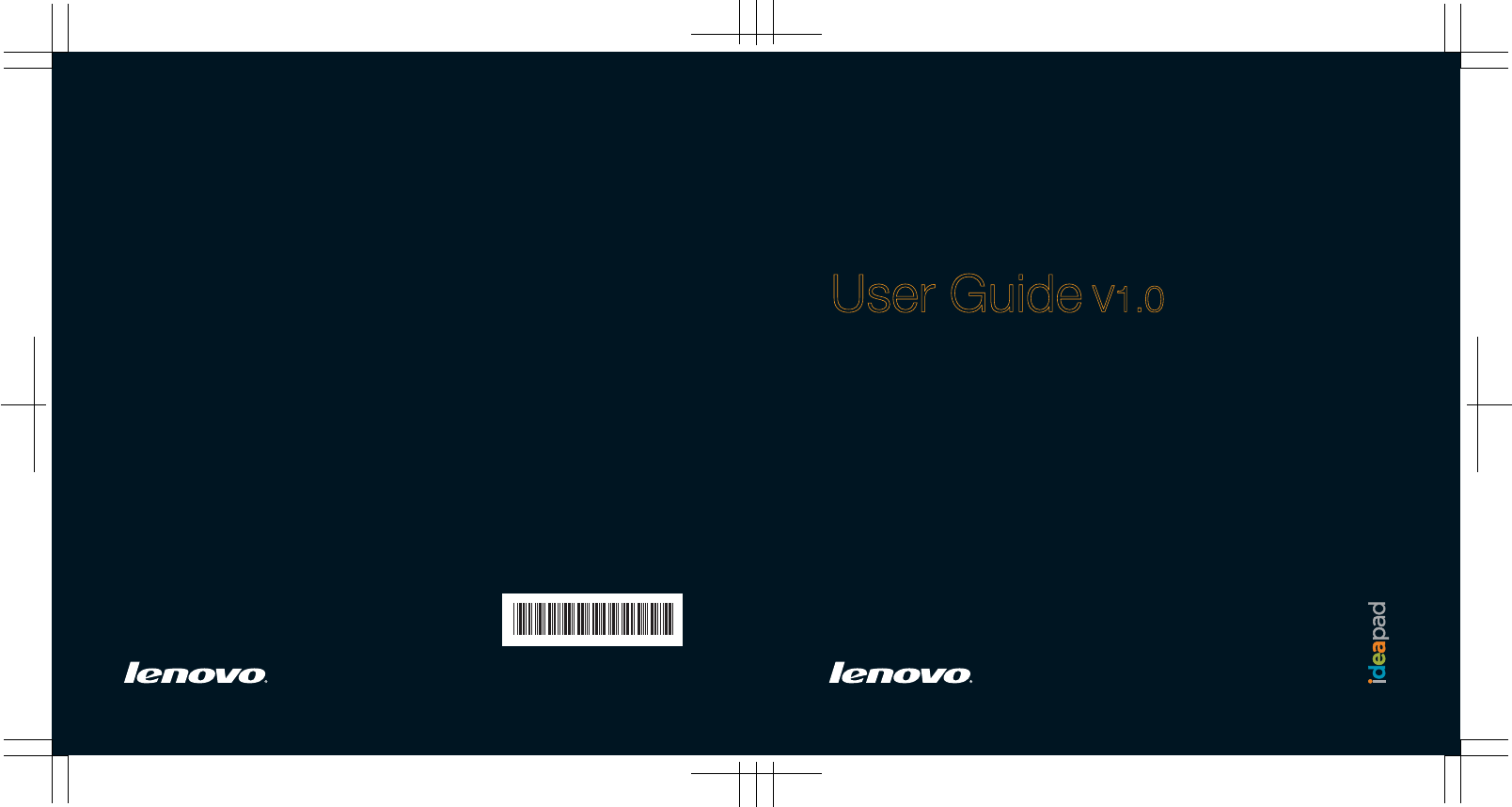
New World. New Thinking.TM
www.lenovo.com
©Lenovo China 2009
P/N: 147002750
Printed in China
S10-3 UserGuide V1.0 cover_1-4
Lenovo
IdeaPad S10-3
User Guide V1.0
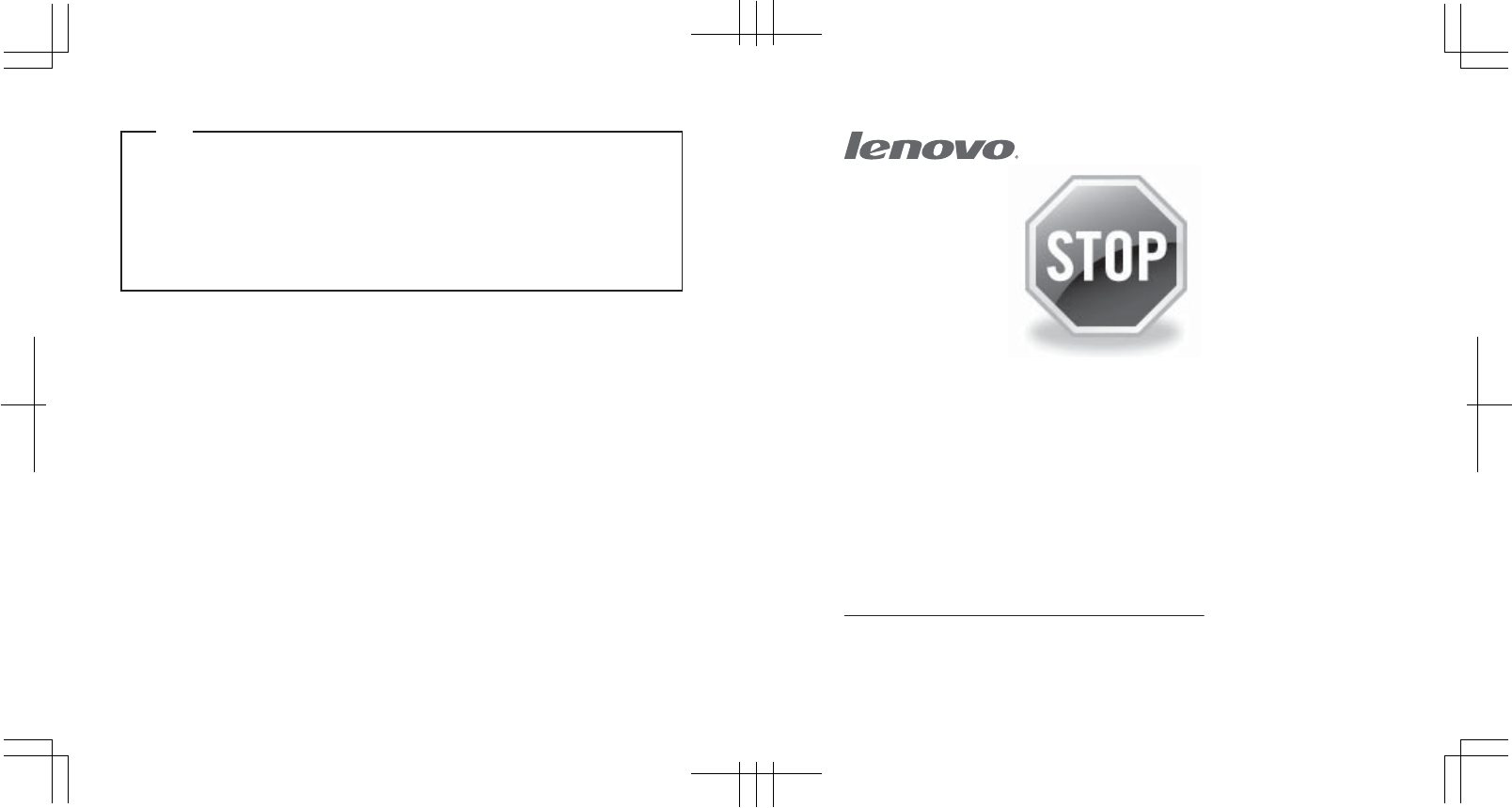
First Edition (November 2009)
•
Notes
© Copyright Lenovo 2009.
S10-3 UserGuide V1.0 cover_2-3
If your product is not working correctly,
DO NOT RETURN IT TO THE STORE.
For technical assistance, contact a Lenovo support
specialist 24 hours a day by calling toll free 1-877-4
LENOVO (1-877-453-6686).
Additionally, you can find support information and updates
on the Lenovo Web site located at
http://consumersupport.lenovo.com.
* Only for the users from the United States.
Before using this information and the product it supports, be sure to read Important safety
information on page iii and Notices in Appendix E first.
•Some instructions in this guide may assume that you are using Windows® 7. If you are using
other Windows operating system, some operations may be slightly different. If you are using
other operating systems, some operations may not apply to you, but it won’t substantially affect
your use of this computer.
•The features described in this guide are common to most models. Some features may not be
available on your computer and/or your computer may include features that are not described in
this user guide.
LENOVO products, data, computer software, and services have been developed exclusively at private expense
and are sold to governmental entities as commercial items as defined by 48 C.F.R. 2.101 with limited and
restricted rights to use, reproduction and disclosure. LIMITED AND RESTRICTED RIGHTS NOTICE: If
products, data, computer software, or services are delivered pursuant a General Services Administration “GSA”
contract, use, reproduction, or disclosure is subject to restrictions set forth in Contract No. GS-35F-05925.
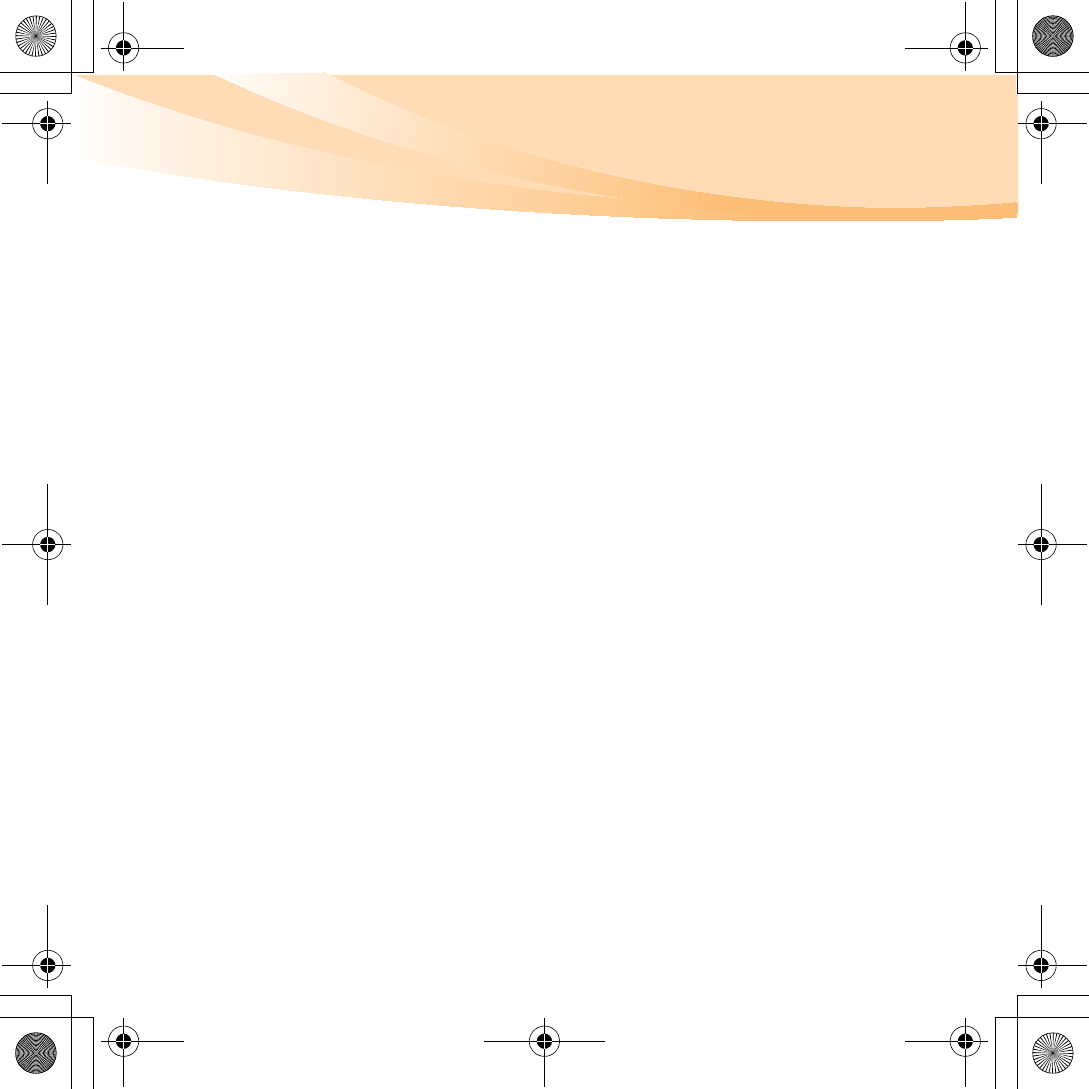
Dear user,
Thank you for purchasing your new Lenovo notebook computer!
Before using this product, make sure to read this user guide carefully.
We are pleased that you have chosen Lenovo for your mobile computing
needs. To help you master the usage of your new computer quickly, we
have prepared this user guide. In this manual you will find information on
the system configuration, basic operating instructions, and important
notices. We have done our best to avoid any errors in making sure that the
information provided in this manual is accurate and reliable. However, due
to the short length of the user guide it is impossible to cover all topics in
great depth. For this reason, we apologize for any omissions you might
find.
Lenovo is always trying to improve the performance and reliability of its
products. For that reason, the hardware and software components shown
within the user guide might not perfectly match those of your system.
However, any inconsistencies between what is described in the user guide
and the operations of your computer should not substantially affect your
use.
Thank you for your cooperation.
S10-3 UserGuide V1.0_en.book Page 1 Tuesday, November 10, 2009 11:04 AM
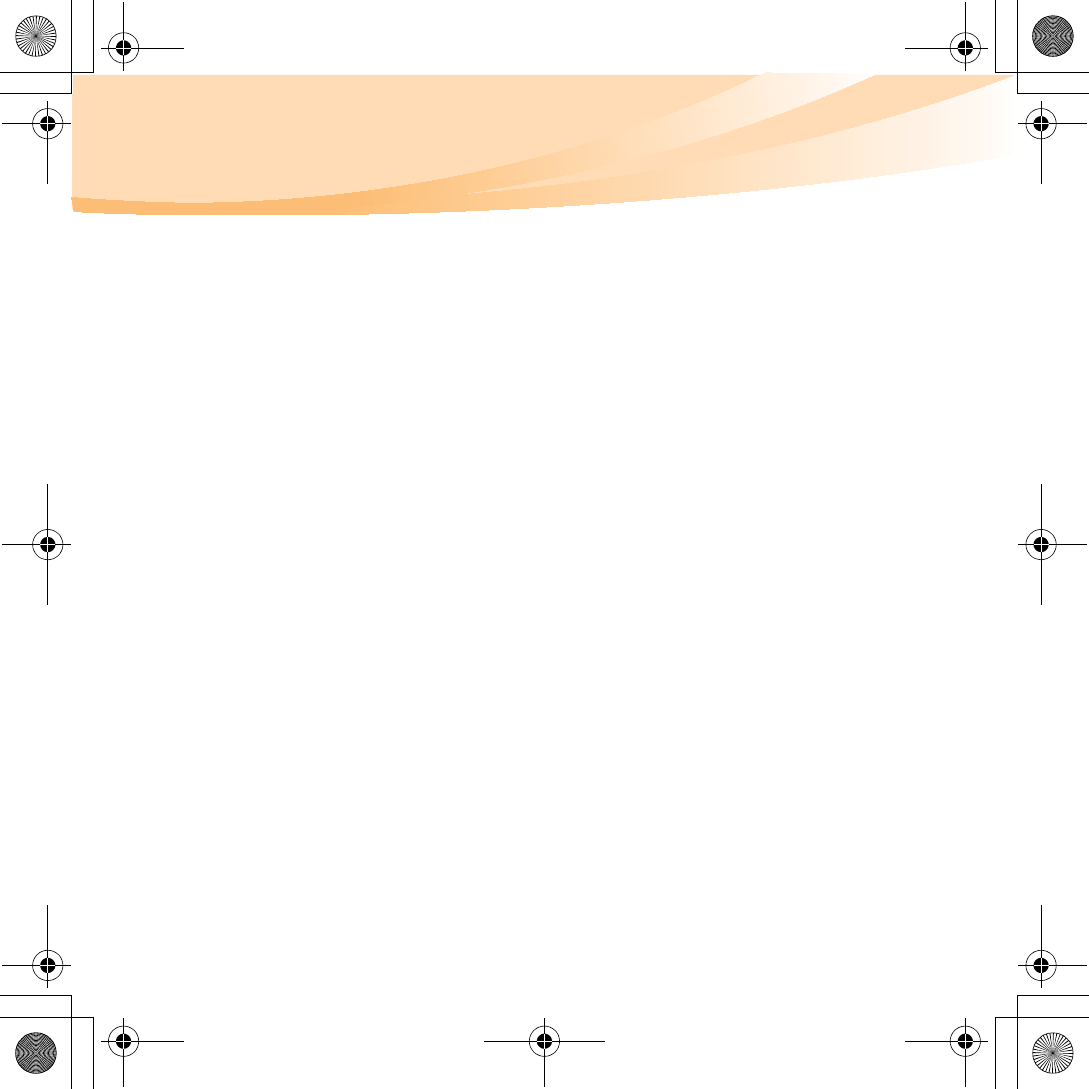
Explanation of hard disk capacity
Dear user,
While using your computer, you may find that the nominal hard disk
capacity indicated is somewhat different from the disk capacity
displayed by the operating system. For example, a nominal 40GB hard
disk will appear as less than 40GB in the operating system. This
discrepancy is not an error in hard disk installation nor any other
problem, but a normal phenomenon of computers. This phenomenon is
primarily due to the following reasons:
I. Different standards used by the manufacturer and operating
system when calculating hard disk capacity
Hard disk manufacturers use a radix of 1000, i.e., 1G = 1,000MB, 1MB =
1,000KB, 1KB = 1,000 bytes. However, when identifying hard disk capacity,
operating systems use a radix of 1024, i.e., 1GB = 1,024MB, 1MB = 1,024KB,
1KB = 1,024 bytes. The standard adopted by your computer is that of the
hard disk manufacturers. Since the standards adopted by the hard disk
manufacturer and operating system are different, the hard disk capacity
displayed by the operating system will be different from the nominal hard
disk capacity.
For example, if the hard disk is nominally X G, even when it is completely
empty, the capacity displayed by the operating system will be:
X × 1000 × 1000 × 1000/ (1024 × 1024 × 1024) | X × 0.931 G
S10-3 UserGuide V1.0_en.book Page 2 Tuesday, November 10, 2009 11:04 AM
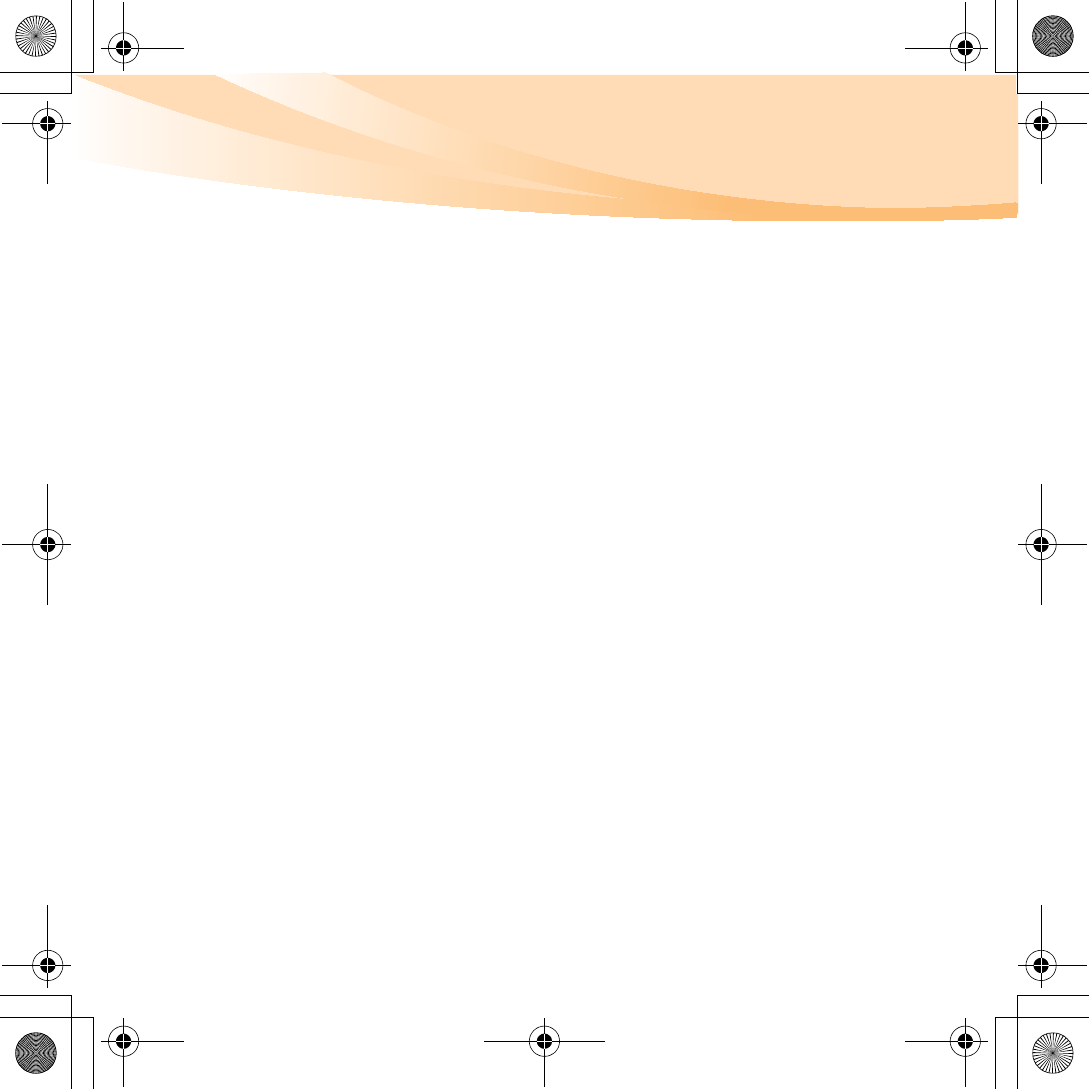
In addition, if a portion of the hard disk space has been used for some
specific purpose, then the capacity indicated by the operating system will
be even less than X × 0.931 G.
II. A portion of the hard disk space is used for specific purposes
Lenovo computers may come with preinstalled OneKey Rescue system, so
the hard disk has a special portion partitioned before delivery, which is
used to store hard disk mirror and OneKey Rescue system program files.
The size of the reserved space for this partition varies according to the
model, operating system and software of the computer. For the sake of
safety, this partition is not apparent, which is commonly referred to as a
“hidden partition”.
In addition, after the hard disk is partitioned or formatted, the system will
assign a certain amount of hard disk space for the system files.
For the above reasons, the available hard disk space indicated by the
operating system is always less than the computer’s nominal hard disk
capacity.
S10-3 UserGuide V1.0_en.book Page 3 Tuesday, November 10, 2009 11:04 AM
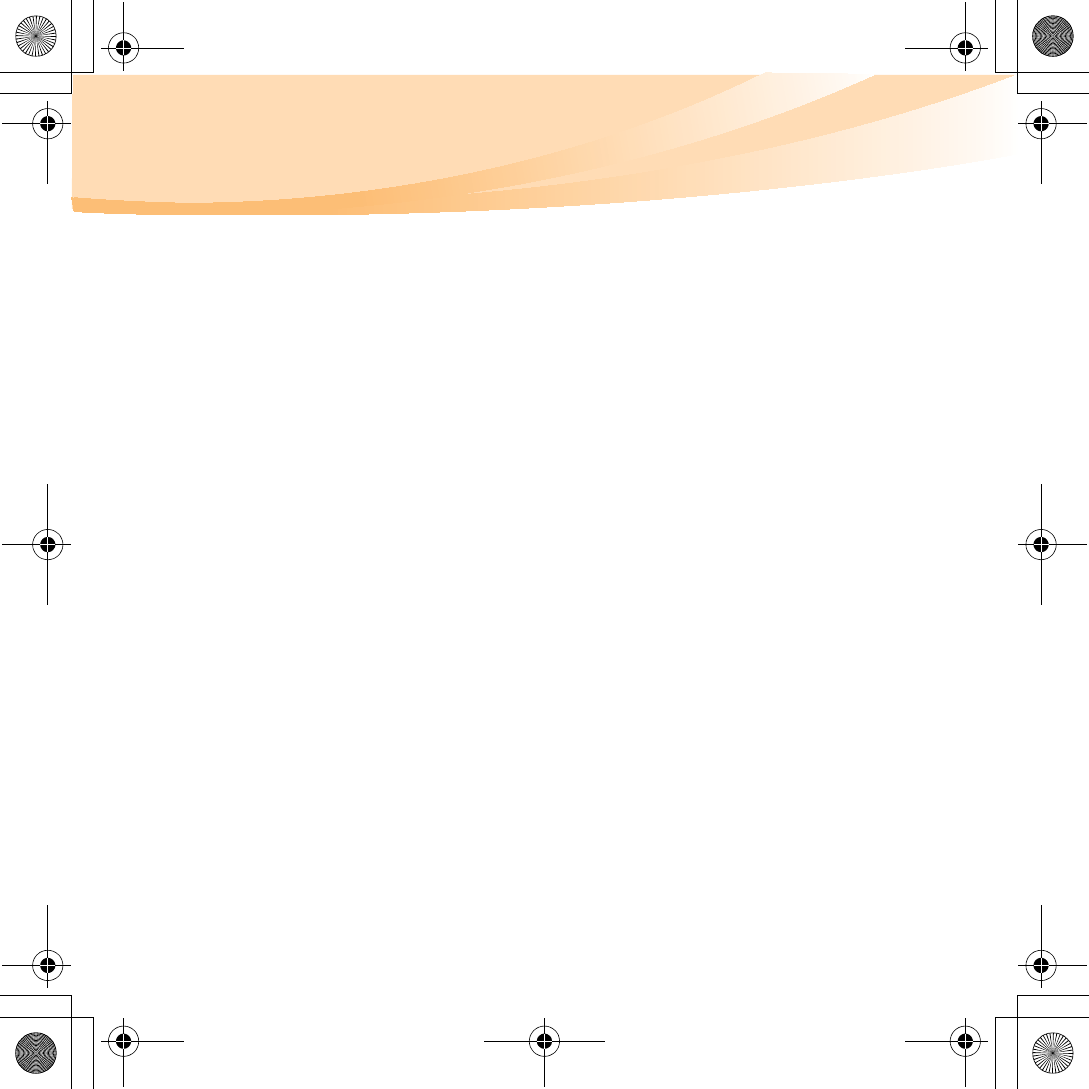
S10-3 UserGuide V1.0_en.book Page 4 Tuesday, November 10, 2009 11:04 AM
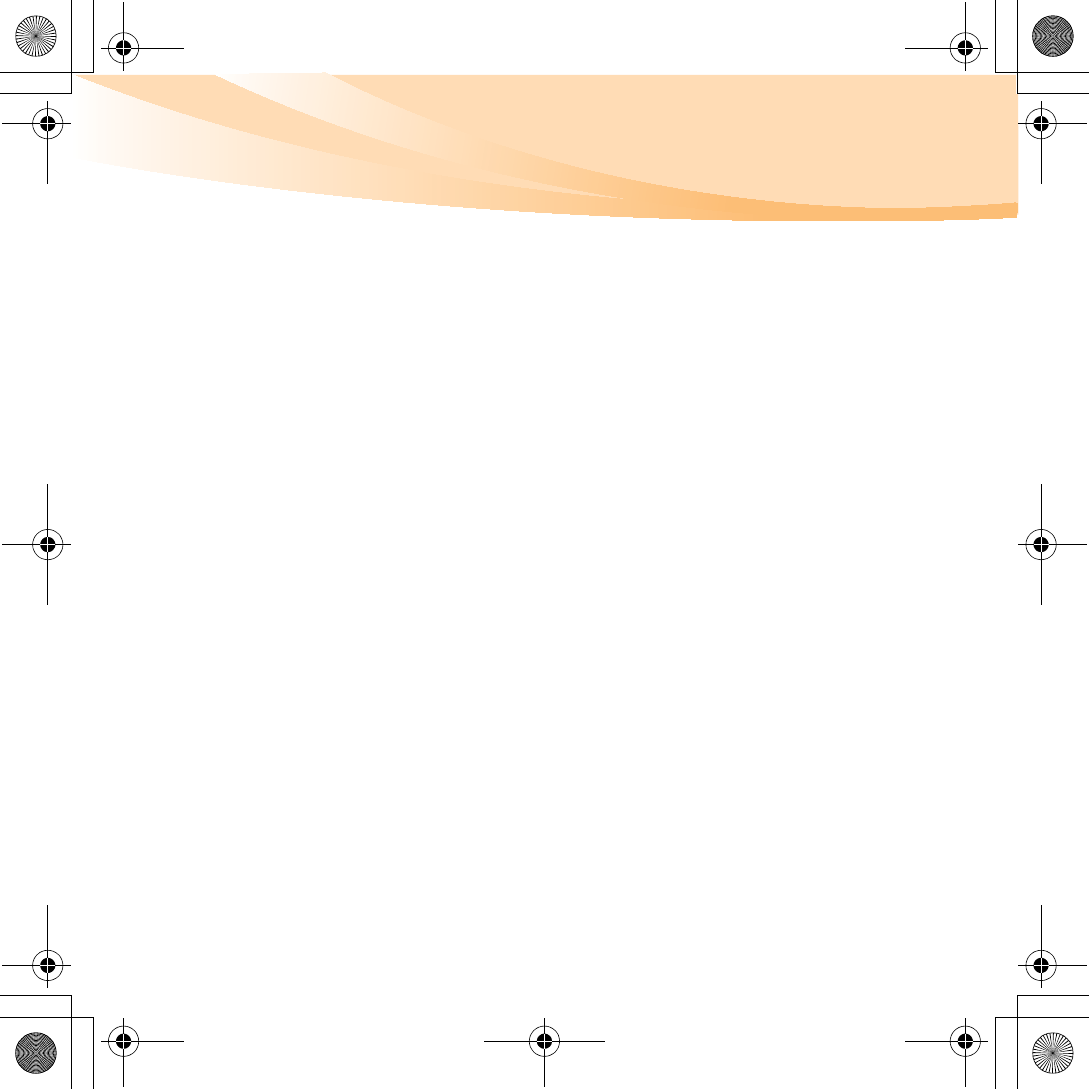
i
Important safety information...... iii
Important safety information....iii
Chapter 1. Getting to know your
computer ....................................... 1
Top view........................................1
Left-side view ............................... 3
Right-side view............................. 4
Bottom view..................................5
Chapter 2. Learning the
basics ............................................ 7
First use.......................................... 7
Using AC adapter and
battery ..........................................10
Using the touchpad....................13
Using the keyboard....................14
Special buttons............................ 17
System status indicators............ 19
Securing your computer............20
Connecting external devices..... 22
Using Lenovo Quick Start
(select models only) ...................25
Chapter 3. Using the Internet .... 27
Wired connection .......................27
Wireless connection ...................29
Chapter 4. OneKey Rescue
system..........................................34
OneKey Rescue system .............34
Chapter 5. Troubleshooting .......37
Frequently asked questions ......37
Troubleshooting .........................40
Chapter 6. Upgrading and
replacing devices ........................48
Replacing the battery.................48
Replacing the hard disk drive ..50
Replacing memory .....................54
Appendix A. Getting help and
service..........................................58
Getting help on the Web ...........59
Calling the customer support
center............................................59
Getting help around the
world............................................62
Lenovo warranty service
telephone numbers.....................62
Appendix B. Use, and care
Information ..................................63
Caring your computer ...............63
Accessibility and comfort..........69
Maintenance................................71
Contents
S10-3 UserGuide V1.0_en.book Page i Tuesday, November 10, 2009 11:04 AM
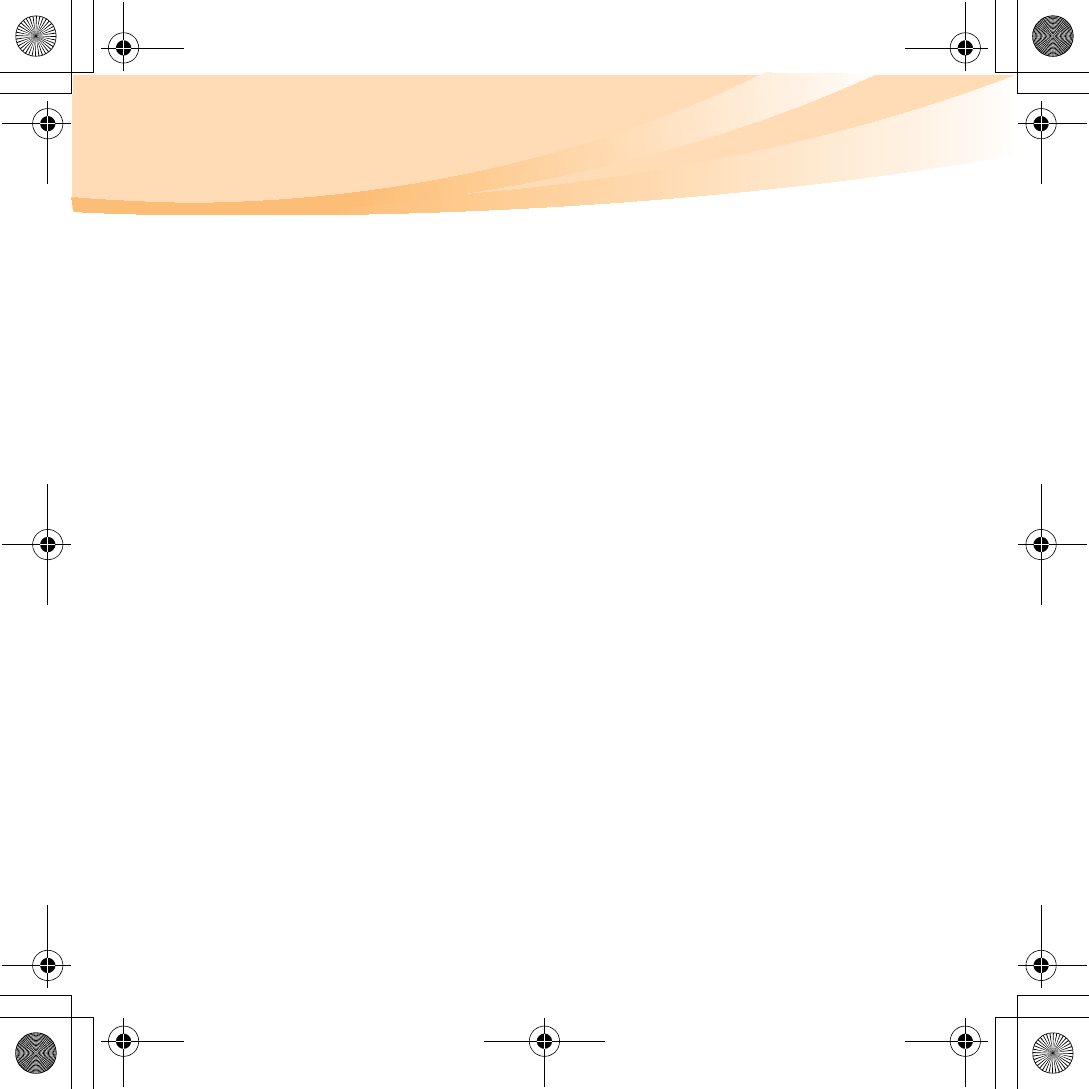
ii
Contents
Appendix C. Lenovo limited
warranty ...................................... 76
Warranty information ............... 86
Appendix D. Customer replaceable
units (CRUs)................................ 90
Appendix E. Notices................... 92
Notices......................................... 92
ENERGY STAR model
information ................................. 95
Wireless related information.... 97
Electronic emissions notices... 101
WEEE and recycling
statements ................................. 108
Turkish statement of
compliance................................ 108
EU WEEE statements .............. 109
Japan recycling statements..... 110
Notice for users in the
U.S.A.......................................... 112
Notice on deleting data from your
hard disk ................................... 112
Appendix F. Features and
specifications ........................... 114
Trademarks............................... 116
Index.......................................... 117
S10-3 UserGuide V1.0_en.book Page ii Tuesday, November 10, 2009 11:04 AM
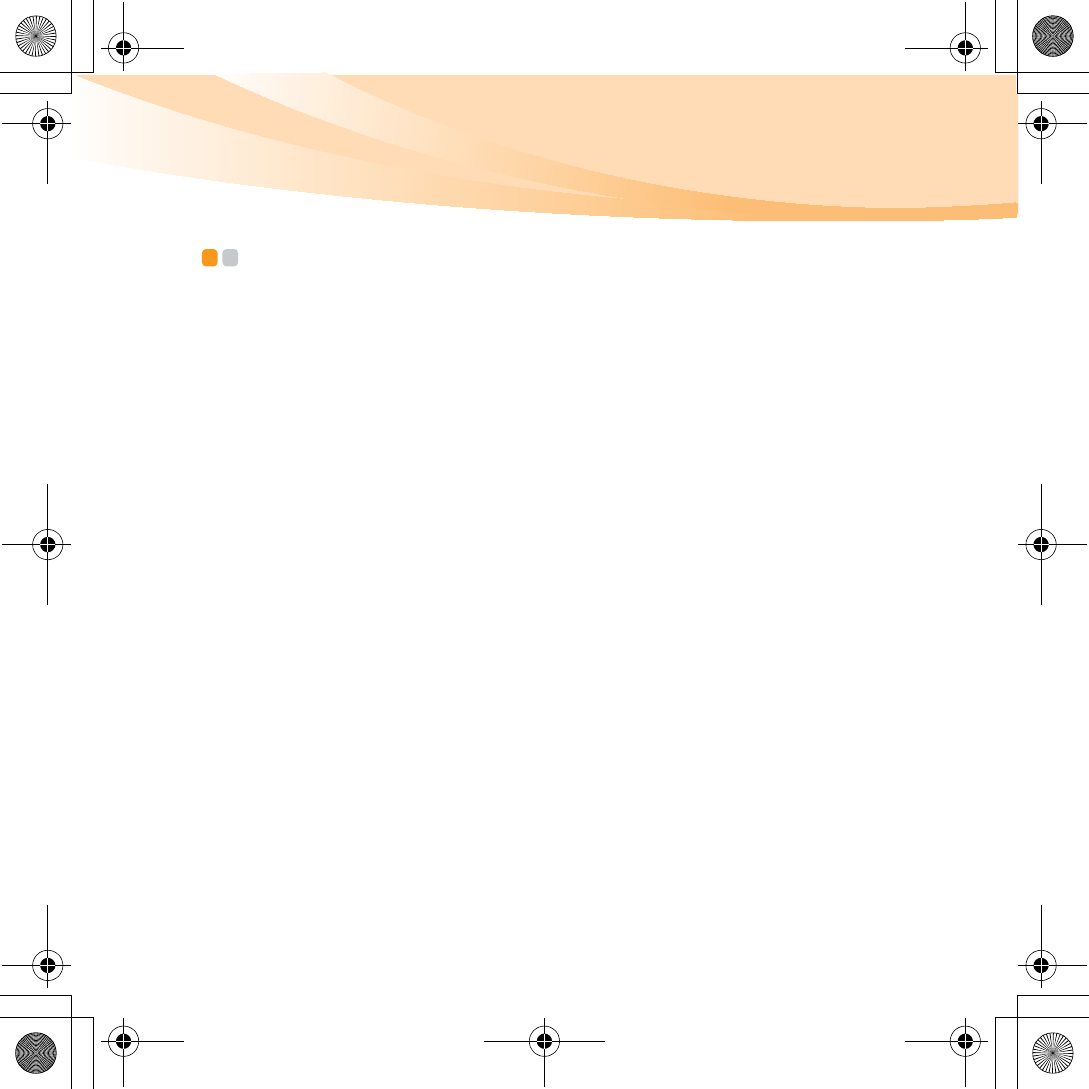
iii
Important safety information
Important safety information - - - - - - - - - - - - - - - - - - - - - - - - - - - - - - - - - - - - - - - - -
This information can help you safely use your notebook personal
computer. Follow and retain all information included with your computer.
The information in this document does not alter the terms of your purchase
agreement or the Lenovo Limited Warranty. For more information, see
“Appendix C. Lenovo limited warranty” on page 76.
Read this first
Personal computers are electronic devices. Power cords, power adapters,
and other features can create potential safety risks that can result in
physical injury or property damage, especially if misused.
The safety risks are categorized as follows:
Danger:
Physical injury or even death may be caused.
Attention:
Property damage or even minor injury may be caused.
To protect yourself from hazards and create a safer computer work
environment, follow the instructions hereafter.
S10-3 UserGuide V1.0_en.book Page iii Tuesday, November 10, 2009 11:04 AM
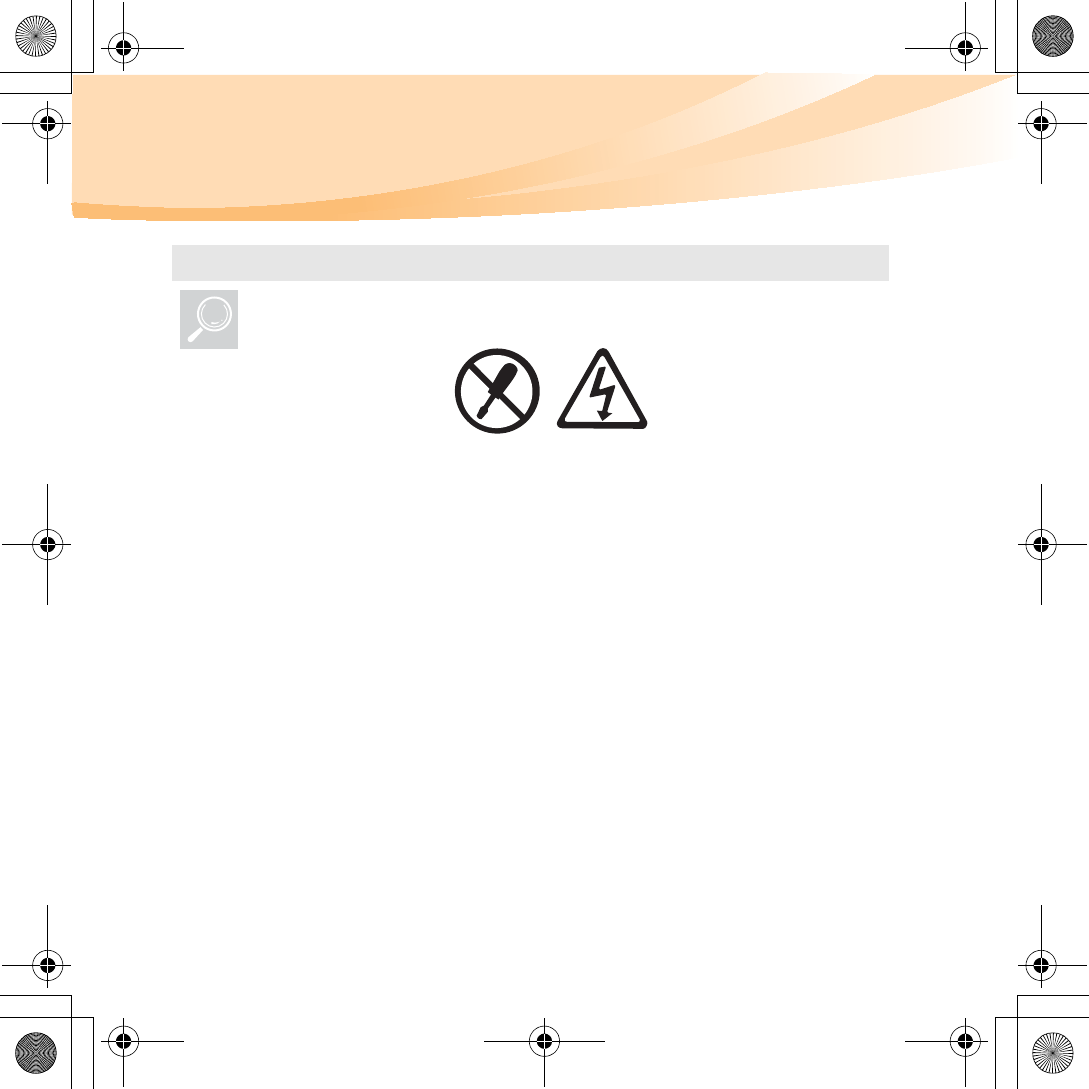
iv
Important safety information
Unpack
Inspect the covers of the computer and the AC adapter, especially
parts with the following labels attached for any crack or damage.
Danger:
• Hazardous voltage, current, and energy levels are present
inside any component that has this label attached.
S10-3 UserGuide V1.0_en.book Page iv Tuesday, November 10, 2009 11:04 AM
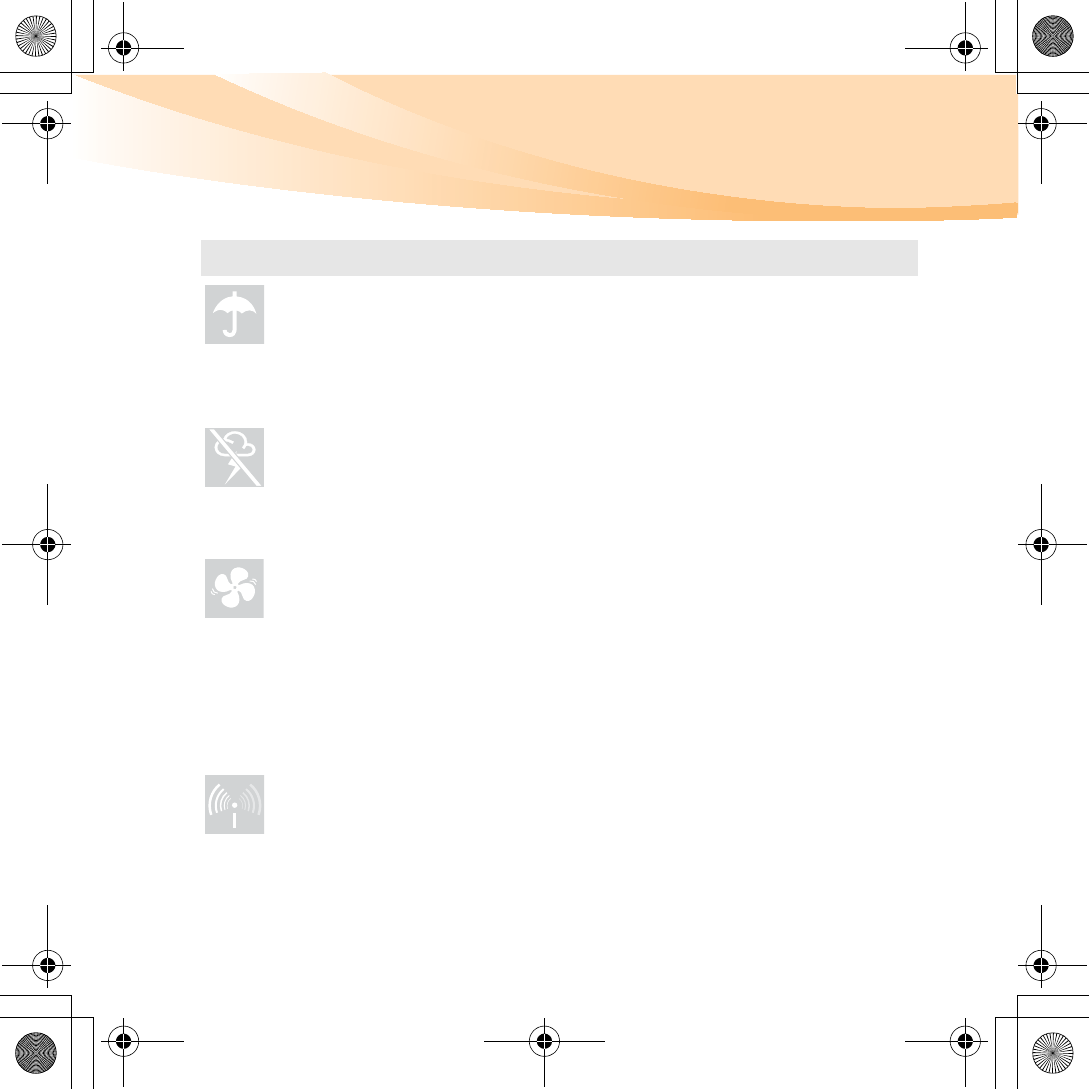
Important safety information
v
Working place
Do NOT use the computer in humid places such as a bathroom.
Keep the computer and other parts away from liquids.
Danger:
• An electric shock may be caused by spilled liquid.
Do NOT use the computer during a lightning storm.
Attention:
• Lightning storms may damage the computer and result in an
electric shock.
Ensure your computer and other components maintain good
ventilation.
Danger:
• Placing the working computer or other parts on a bed, sofa or
other flexible surface may block the ventilation slots causing
overheating of your computer or other parts and increases the
risk of fire.
Turn off wireless devices where they may cause interference, such as in
a hospital or at an airport.
S10-3 UserGuide V1.0_en.book Page v Tuesday, November 10, 2009 11:04 AM
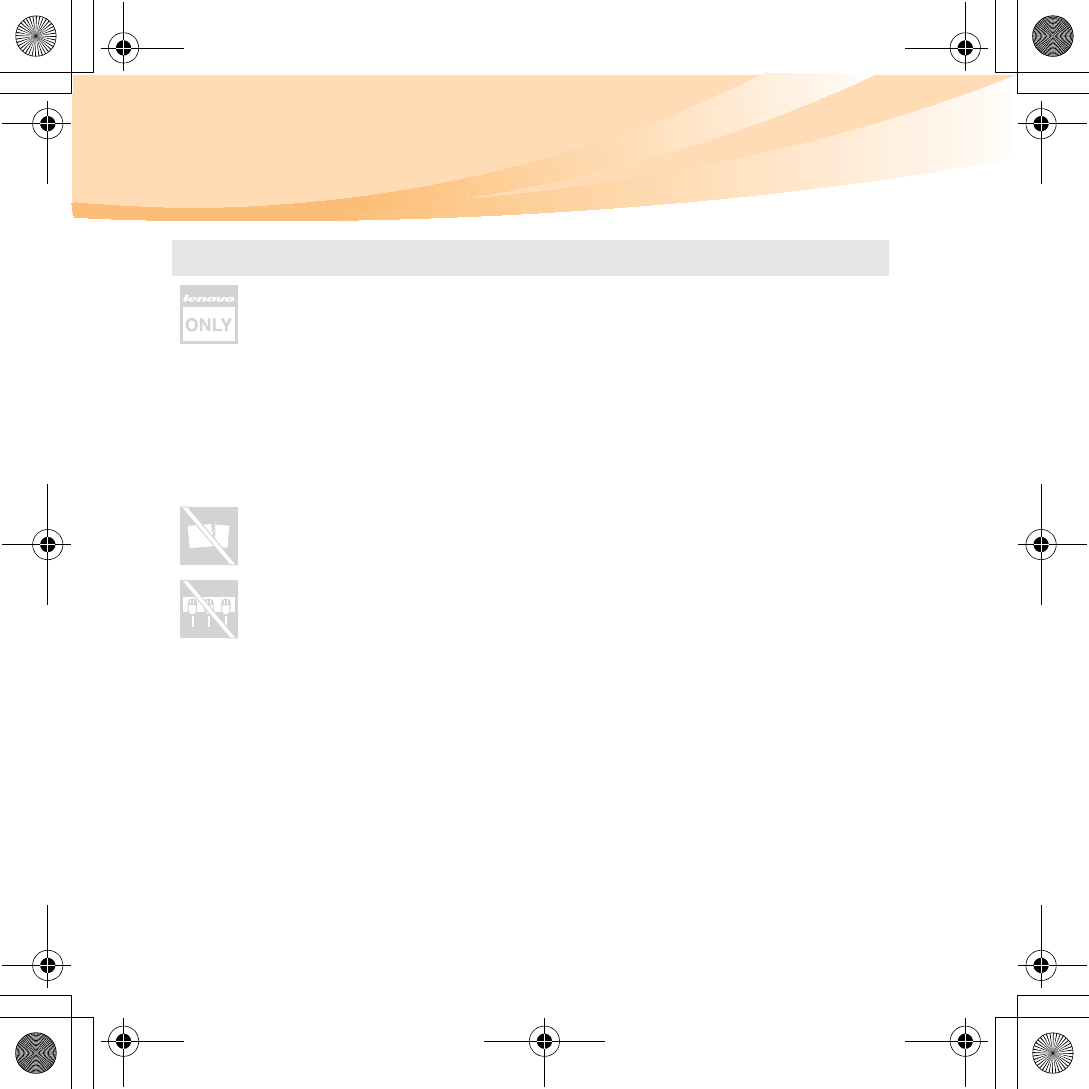
vi
Important safety information
Correct usage procedures
Use ONLY the power cord, power adapter and battery pack shipped
with the computer. Never use these devices with another product.
Be sure the power outlet is suitable for the plug and provides the
correct voltage and current for the product you are using.
Danger:
• An unsuitable power supply may damage your computer and
can cause an electric shock or fire.
Do NOT use a power outlet, power cord, power adapter or battery
pack that appears to be damaged or corroded.
Do NOT share an electrical outlet with other home or commercial
appliances that draw large amounts of electricity.
If power strips are used, the load should NOT exceed the power strip’s
input rating. Unplug the power cord if there are any cracking, hissing,
or popping sounds, or if a strong odor comes from the computer.
Danger:
• Overloading the power supply may cause unstable voltages
which might damage the computer, data, attached devices, or
even cause a fire.
S10-3 UserGuide V1.0_en.book Page vi Tuesday, November 10, 2009 11:04 AM
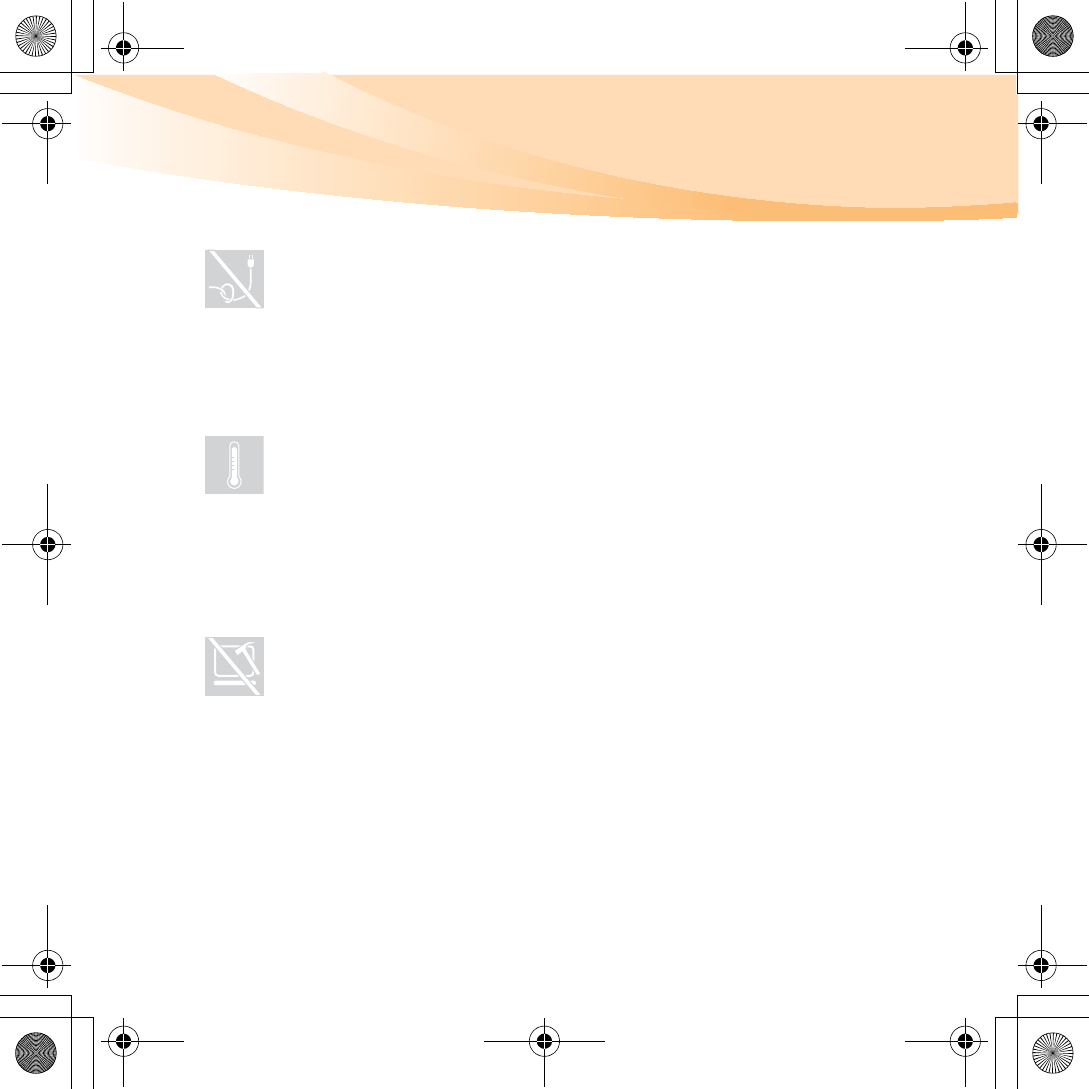
Important safety information
vii
Do NOT wrap the power cord around the power adapter or other
objects.
Do NOT squeeze or pinch the cord, or place heavy objects on it.
Attention:
• Stressing the cord may cause the cord to fray, crack or crimp
which may present a safety hazard.
Avoid keeping your hands, your lap, or any other part of your body in
contact with a hot section of the working computer for any extended
length of time.
Attention:
• Extended contact with your body, even through clothing, could
cause discomfort or even a skin burn.
Do not drop, bump, scratch, hit or place heavy objects on the liquid
crystal display (LCD) of your computer.
Attention:
• Direct contact with liquid crystal material from a broken LCD is
hazardous; if contact occurs, rinse with large amount of running
water for more than 15 minutes.
S10-3 UserGuide V1.0_en.book Page vii Tuesday, November 10, 2009 11:04 AM
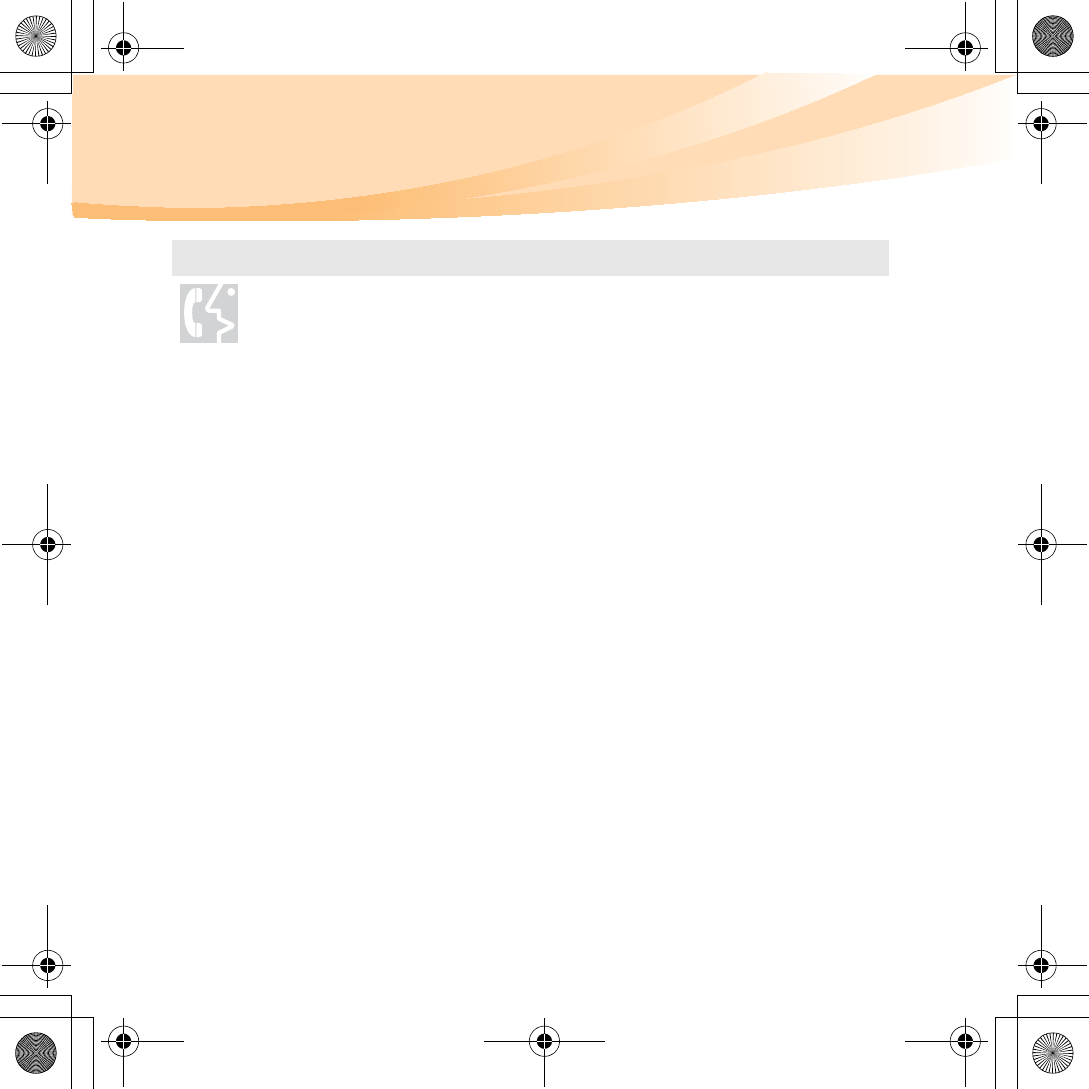
viii
Important safety information
Service and upgrades
Do NOT attempt to service a product yourself unless instructed to do
so by the customer support center or your documentation.
Attention:
• DO NOT take risks or attempt to diagnose the situation
yourself. Contact the customer support center for further
guidance. For a list of service and support phone numbers,
go to http://consumersupport.lenovo.com.
Lenovo provides documentation with instructions when it is
appropriate for customers to install options or replace units (CRUs).
Closely follow all instructions when installing or replacing parts.
Disconnect the attached power cords, battery pack, and all the cables
before you open the device covers, unless instructed otherwise in the
installation and configuration procedures.
Keep the covers closed whenever the computer is plugged in.
S10-3 UserGuide V1.0_en.book Page viii Tuesday, November 10, 2009 11:04 AM
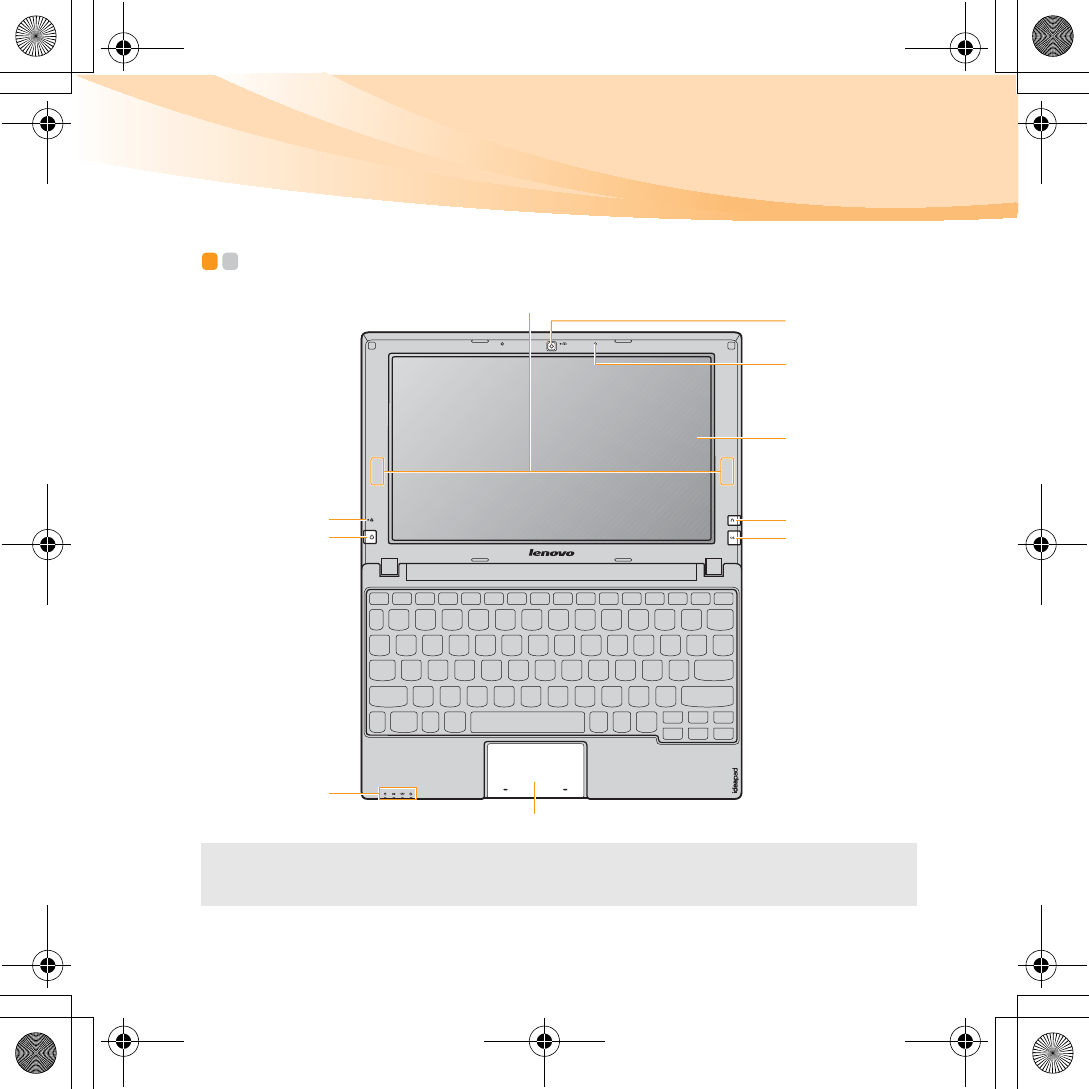
1
Chapter 1. Getting to know your computer
Top view - - - - - - - - - - - - - - - - - - - - - - - - - - - - - - - - - - - - - - - - - - - - - - - - - - - - - - - - - - - - - - - - - - - - - - - - - - - - - - - - - - - - - - - - - - -
Note: The illustrations in this manual may differ from the actual product. Please refer to
the actual product.
a
b
a
h
e
c
d
i
g
f
S10-3 UserGuide V1.0_en.book Page 1 Tuesday, November 10, 2009 11:04 AM

2
Chapter 1. Getting to know your computer
Attention:
•Do NOT open the display panel beyond 130 degrees. When closing the display
panel, be careful NOT to leave pens or any other objects in between the display
panel and the keyboard. Otherwise, the display panel may be damaged.
System status
indicators
For details, see “System status indicators” on page 19.
Power button Press this button to turn on the computer.
Integrated
camera
Use the camera for video communication.
Built-in
microphone
The built-in microphone (with noise reduction) can be used
for video conferencing, voice narration, or simple audio
recordings.
Computer
display
The LCD display with LED backlight provides brilliant
visual output.
OneKey Rescue
system button
Press this button to open OneKey Rescue system (If
OneKey Rescue system has been preinstalled) when the
computer is powered off.
Note: For details, see “Chapter 4. OneKey Rescue system” on page 34.
Quick Start
button
When the computer is powered-off, press this button to enter
the Lenovo Quick Start if it has been installed.
One-piece
touchpad
The touchpad functions as a conventional mouse with
built-in left-click and right-click buttons.
Note: For details, see “Using the touchpad” on page 13.
Wireless module
antennas (select
models only)
The built-in antennas ensure optimal reception of wireless
communication radio.
S10-3 UserGuide V1.0_en.book Page 2 Tuesday, November 10, 2009 11:04 AM
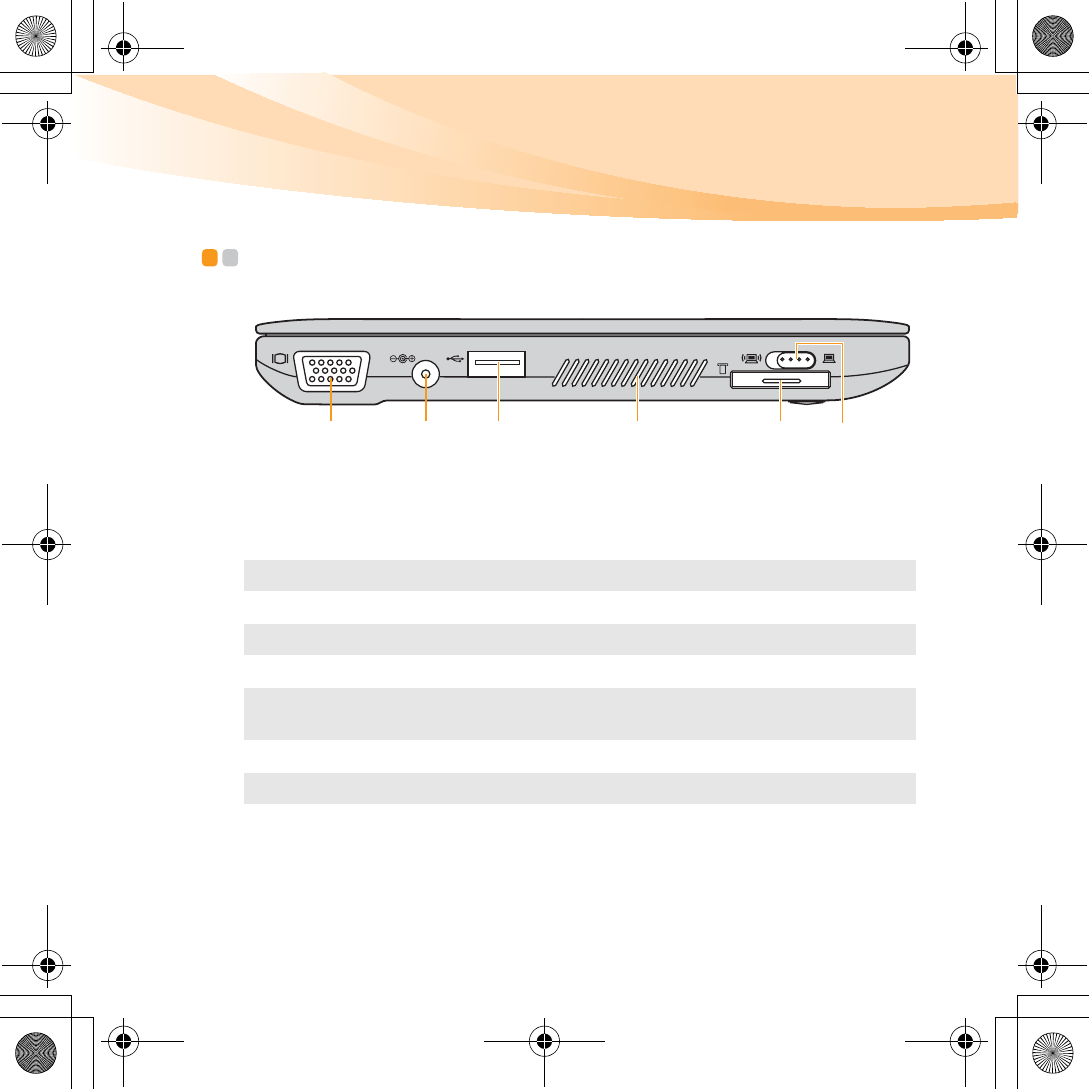
Chapter 1. Getting to know your computer
3
Left-side view - - - - - - - - - - - - - - - - - - - - - - - - - - - - - - - - - - - - - - - - - - - - - - - - - - - - - - - - - - - - - - - - - - - - - - - - - - - - - -
VGA port Connects to external display devices.
AC power
adapter jack
Connect the AC adapter here.
Note: For details, see “Using AC adapter and battery” on page 10.
USB port Connects to USB devices.
Note: For details, see “Connecting a universal serial bus (USB) device” on page 24.
Fan louvers Dissipate internal heat.
Note: Make sure that none of the fan louvers are blocked or else overheating of the
computer may occur.
Memory card slot Insert memory cards (not supplied) here.
Note: For details, see “Using memory cards (not supplied)” on page 22.
Integrated
wireless device
switch
Use this switch to turn on/off the wireless radio of all
wireless devices on your computer.
fedab
c
S10-3 UserGuide V1.0_en.book Page 3 Tuesday, November 10, 2009 11:04 AM
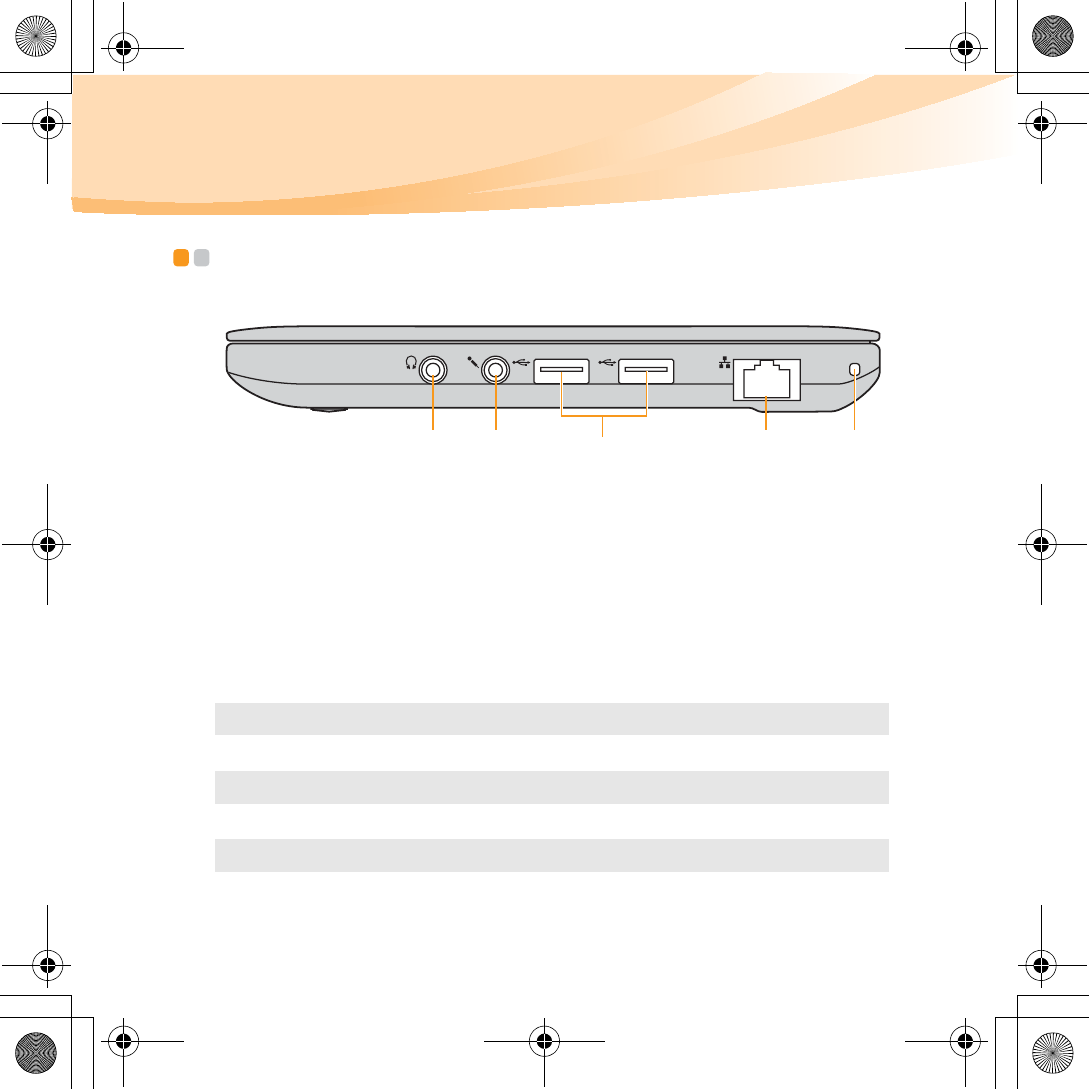
4
Chapter 1. Getting to know your computer
Right-side view - - - - - - - - - - - - - - - - - - - - - - - - - - - - - - - - - - - - - - - - - - - - - - - - - - - - - - - - - - - - - - - - - - - - - - - - - -
Headphone jack Connects to external headphones.
Attention:
•Listening to music at high volume over extended periods of time
may damage your hearing.
Microphone jack Connects to external microphones.
USB port Connects to USB devices.
Note: For details, see “Connecting a universal serial bus (USB) device” on page 24.
RJ-45 port
Connects to an Ethernet network.
Note: For details, see “Wired connection” on page 27.
Kensington slot Attach a security lock (not supplied) here.
Note: For details, see “Attaching a security lock (not supplied)” on page 20.
edab
c
S10-3 UserGuide V1.0_en.book Page 4 Tuesday, November 10, 2009 11:04 AM
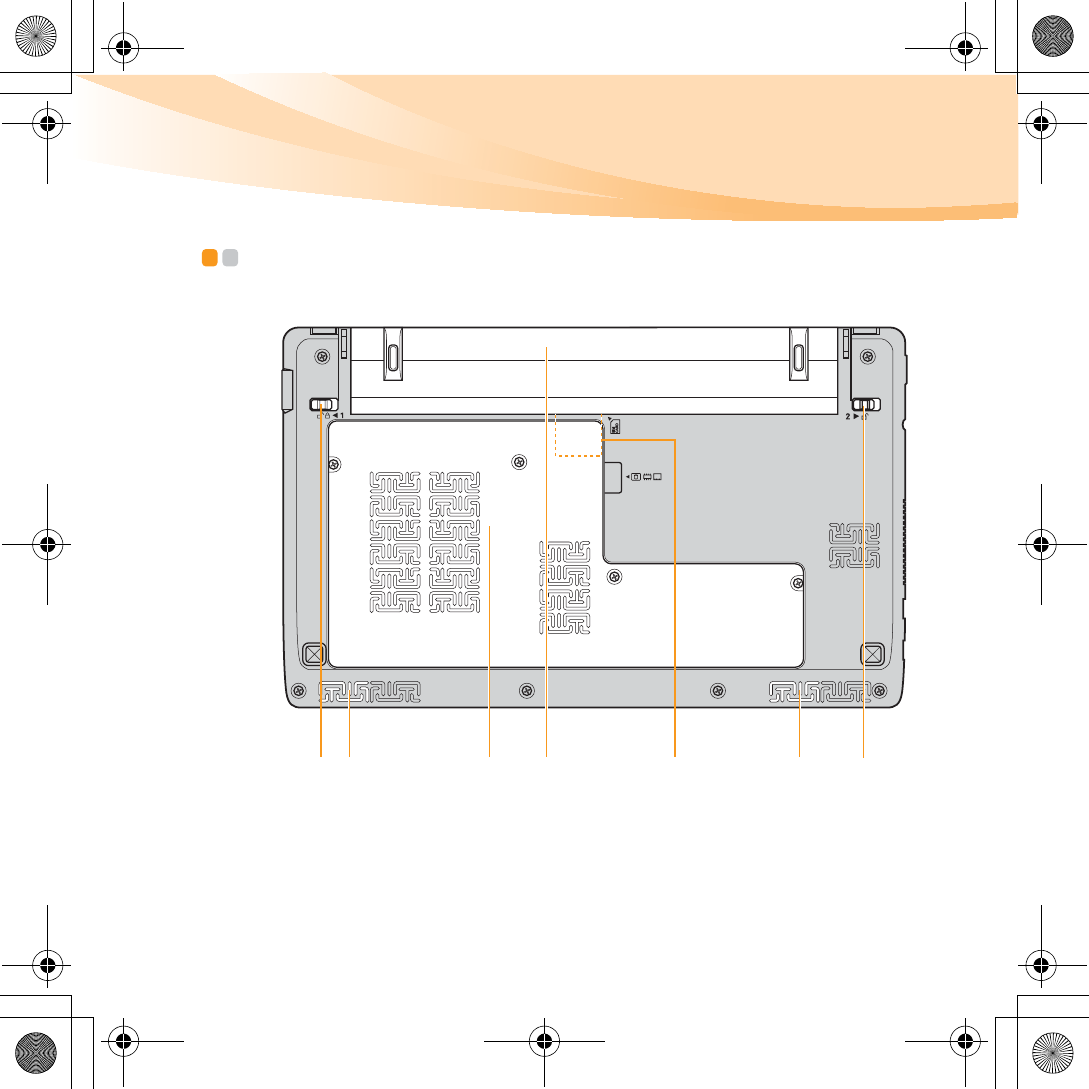
Chapter 1. Getting to know your computer
5
Bottom view - - - - - - - - - - - - - - - - - - - - - - - - - - - - - - - - - - - - - - - - - - - - - - - - - - - - - - - - - - - - - - - - - - - - - - - - - - - - - - - - - -
d
ab cb
ef
S10-3 UserGuide V1.0_en.book Page 5 Tuesday, November 10, 2009 11:04 AM
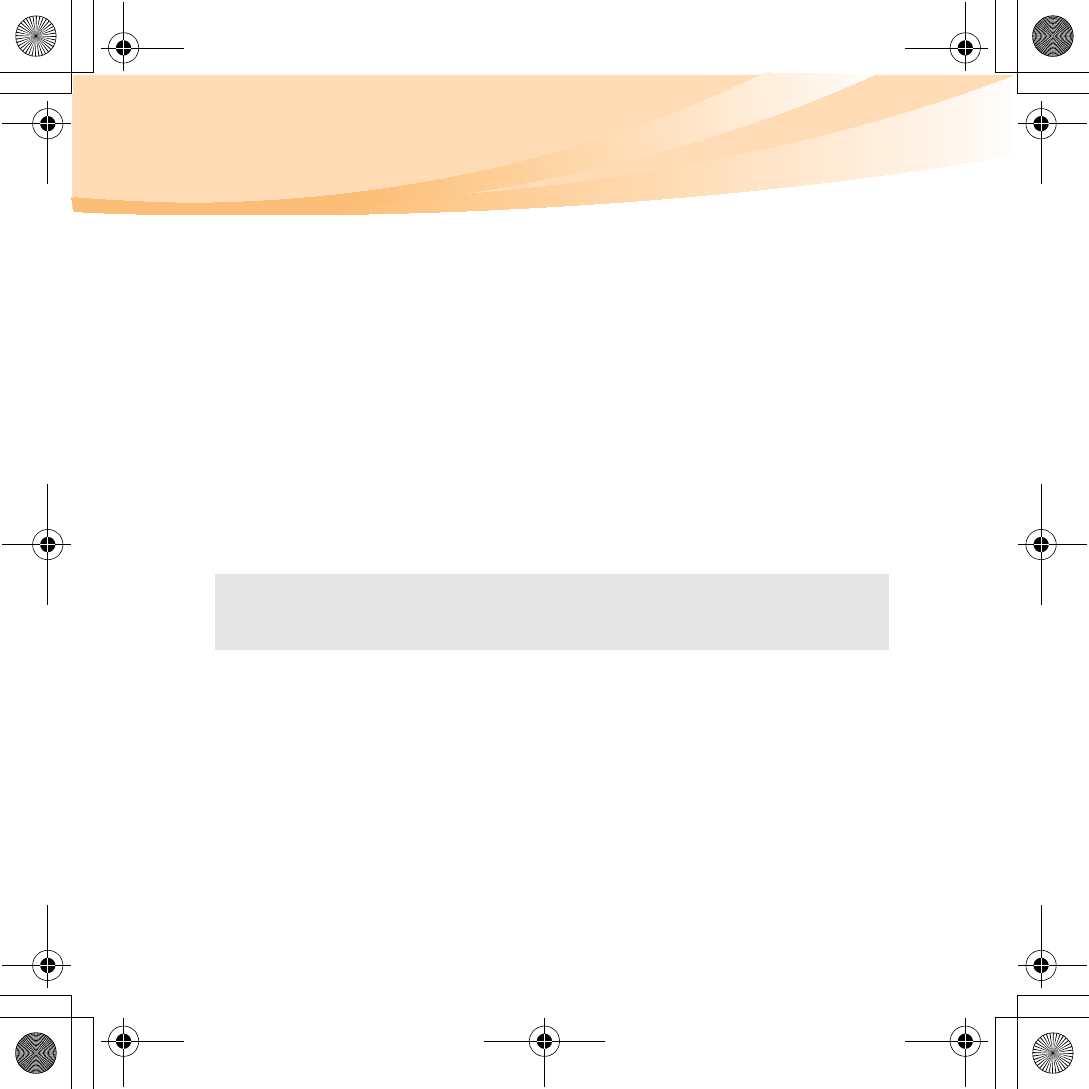
6
Chapter 1. Getting to know your computer
Battery latch -
manual
The manual battery latch is used to keep the battery pack
secured in place.
Speakers The stereo speakers provide rich and powerful sound.
Hard disk/
Memory/Mini PCI
ExpressCard slot
compartment
Battery pack For details, see “Using AC adapter and battery” on page 10.
SIM card slot
(select models
only)
Insert a SIM card (not supplied) for using Mobile
Broadband.
Notes:
•After removing the battery pack, you can insert a SIM card into this slot.
•For details, see “Using Mobile Broadband (select models only)” on page 31
Battery latch -
spring loaded
The spring-loaded battery latch keeps the battery pack
secured in place.
S10-3 UserGuide V1.0_en.book Page 6 Tuesday, November 10, 2009 11:04 AM
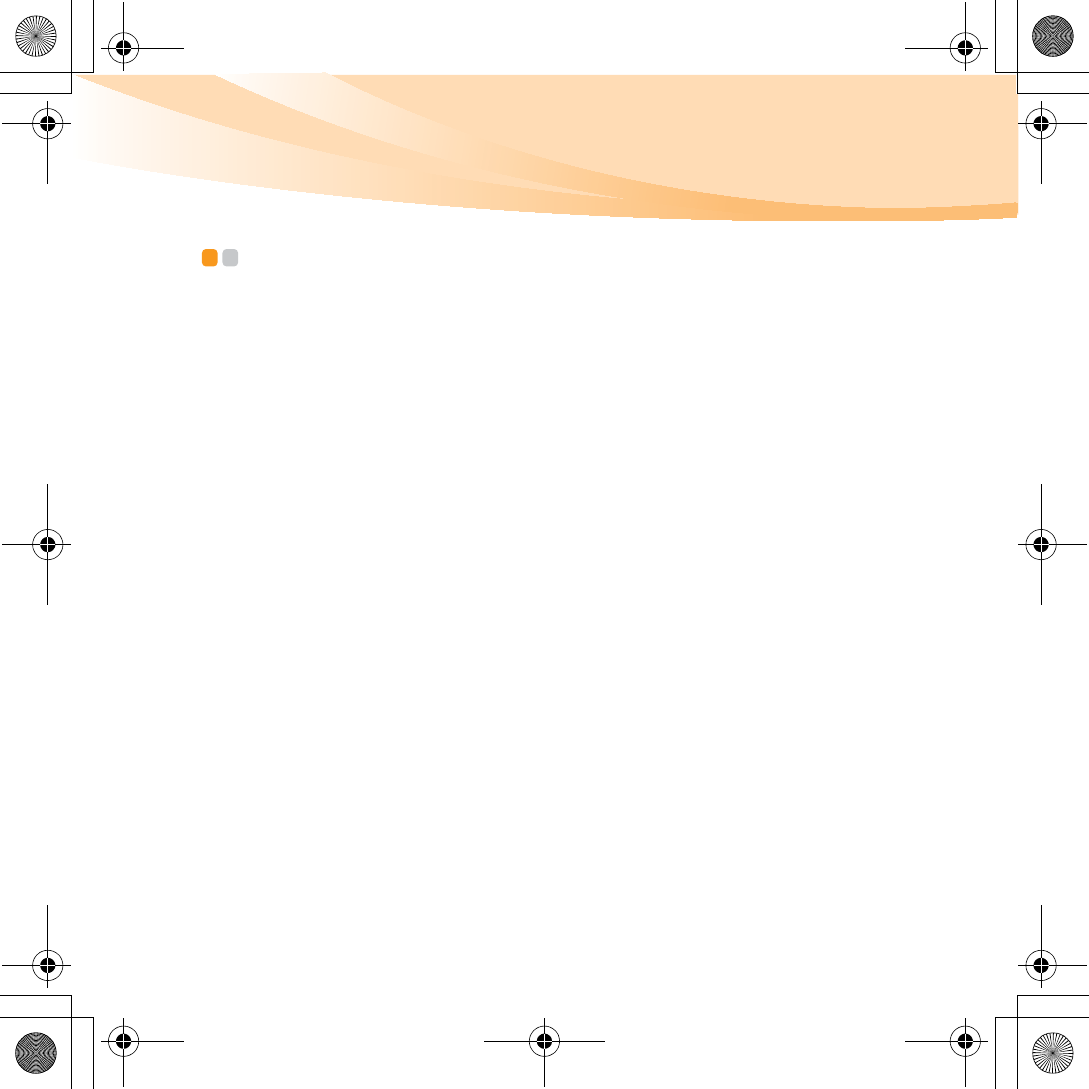
7
Chapter 2. Learning the basics
First use
- - - - - - - - - - - - - - - - - - - - - - - - - - - - - - - - - - - - - - - - - - - - - - - - - - - - - - - - - - - - - - - - - - - - - - - - - - - - - - - - - - - - - - - - - - - - - - -
Read the manuals
Read the supplied manuals before using your computer.
Connect to the power
The supplied battery pack is not fully charged at purchase.
To charge the battery and begin using your computer, insert the battery
pack and connect the computer to an electrical outlet. The battery is
automatically charged while the computer is running on AC power.
Install the battery pack
Refer to the supplied Setup Poster to install the battery pack.
Connect the computer to an electrical outlet
1
Connect the power cord to the AC adapter.
2
Connect the AC adapter to the AC power adapter jack of the computer.
3
Plug the power cord into an electrical outlet.
S10-3 UserGuide V1.0_en.book Page 7 Tuesday, November 10, 2009 11:04 AM
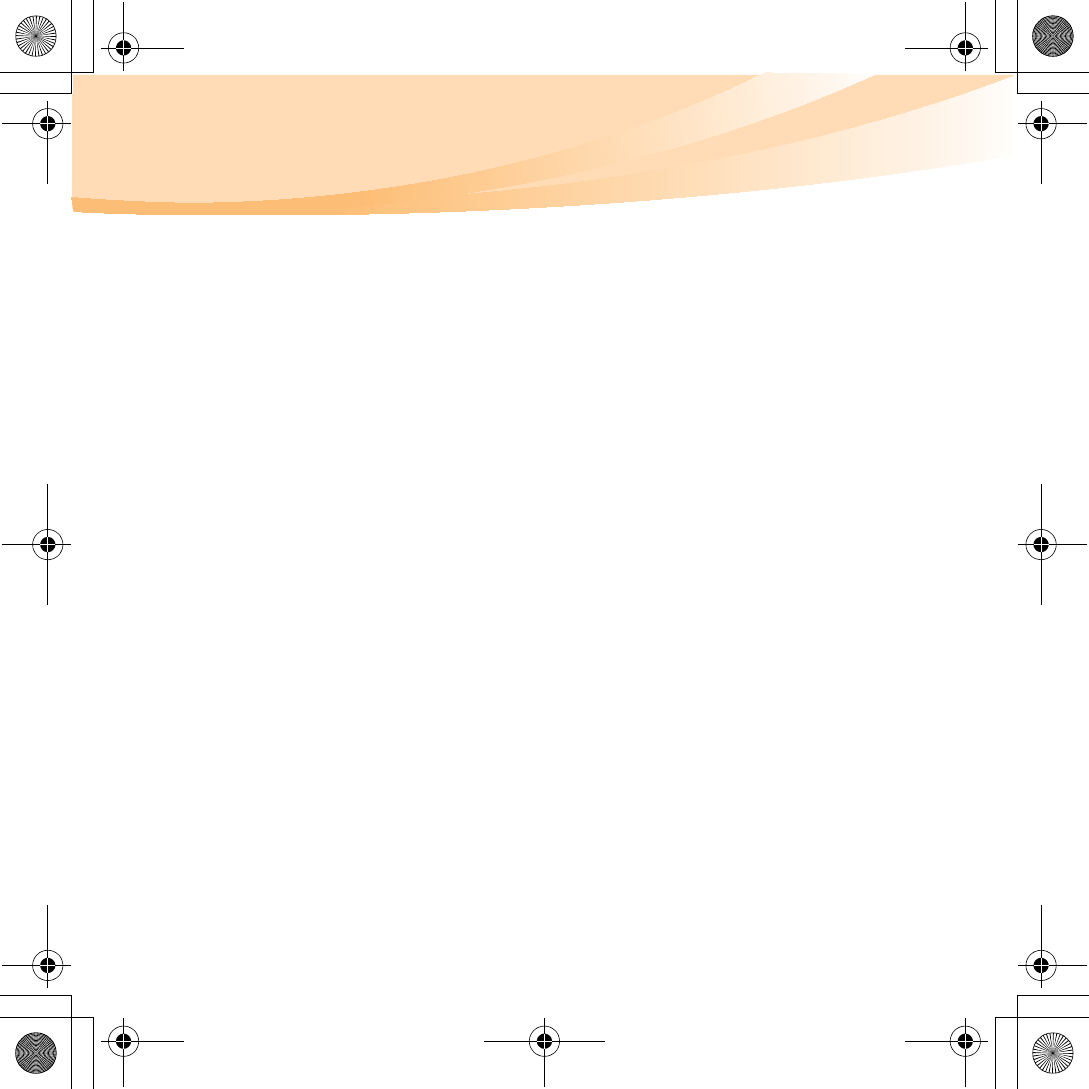
8
Chapter 2. Learning the basics
Turn on the computer
Press the power button to turn on the computer.
Configure the operating system
You may need to configure the operation system when it is first used. The
configuration process may include the procedures below.
• Accepting the end user license agreement
• Configuring the Internet connection
• Registering the operating system
• Creating a user account
Putting your computer into sleep state or shutting it down
When you finish working with your computer, you can put it into sleep
state or shut it down.
Putting your computer into sleep state
If you will be away from your computer for only a short time, put the
computer into sleep state.
When the computer is in sleep state, you can quickly wake it to resume use,
and bypass the startup process.
S10-3 UserGuide V1.0_en.book Page 8 Tuesday, November 10, 2009 11:04 AM
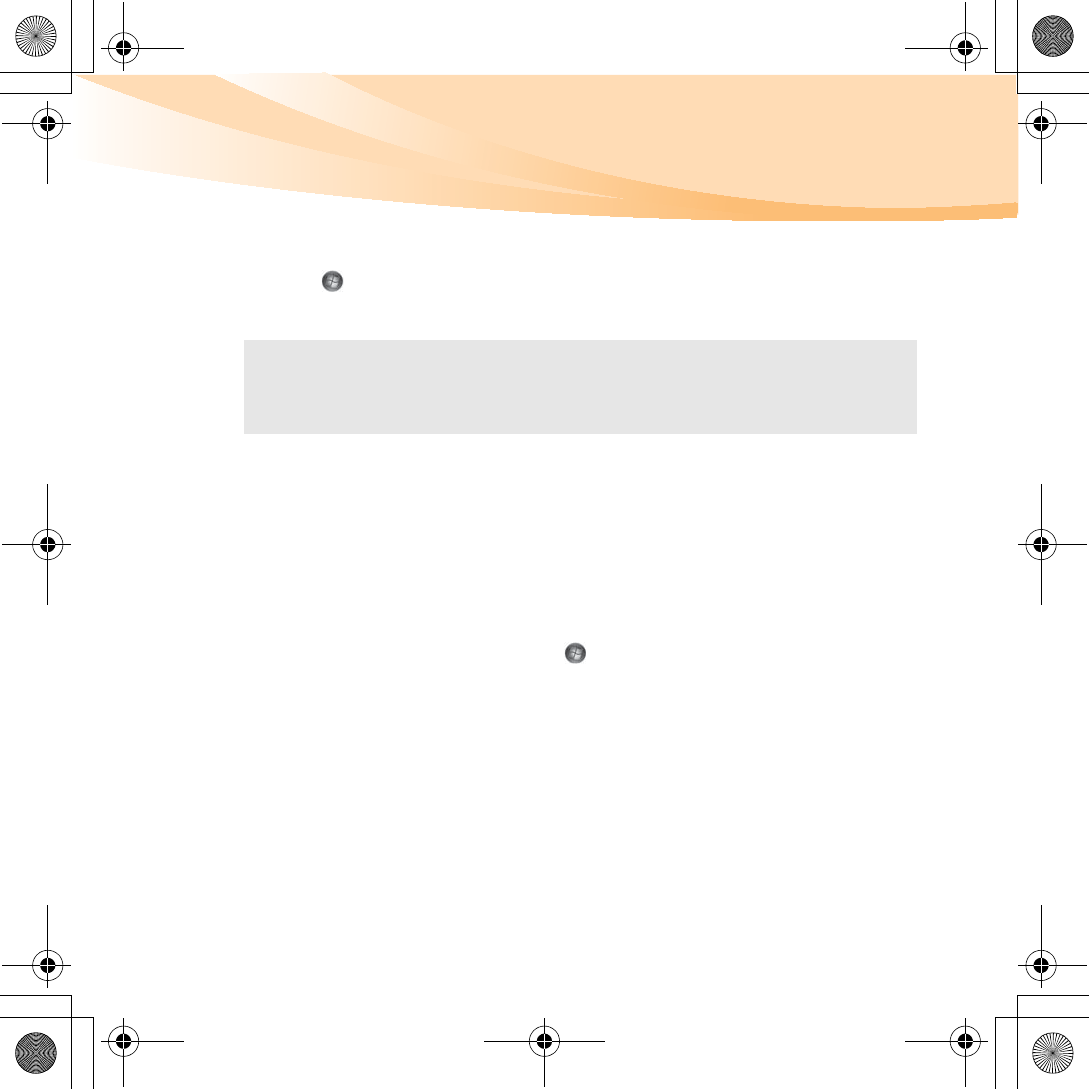
Chapter 2. Learning the basics
9
To put the computer into sleep state, do one of the following.
• Click and select Sleep from the Start menu.
•Press Fn + F1.
To wake the computer, do one of the following.
• Press the power button.
• Press any key on the keyboard.
Shutting down your computer
If you are not going to use your computer for a day or two, shut it down.
To shut down your computer, click and select Shut down from the Start
menu.
Note: Wait until the power indicator light starts blinking (indicating that the
computer is in sleep state) before you move your computer. Moving your
computer while the hard disk is spinning can damage the hard disk, causing
loss of data.
S10-3 UserGuide V1.0_en.book Page 9 Tuesday, November 10, 2009 11:04 AM
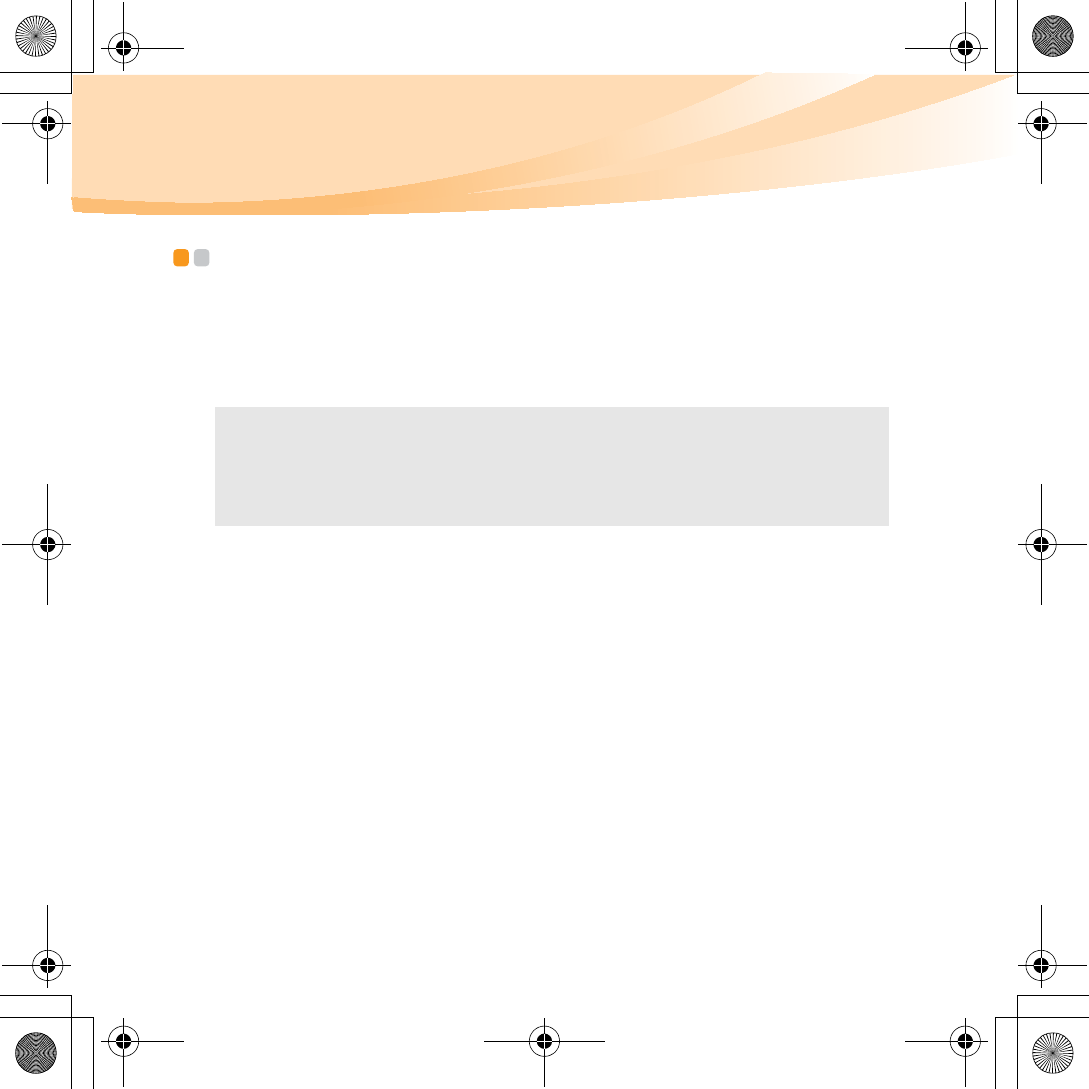
10
Chapter 2. Learning the basics
Using AC adapter and battery - - - - - - - - - - - - - - - - - - - - - - - - - - - - - - - - - - - - - - - - - - - - - - -
Checking battery status
You can determine the percentage of battery power remaining by checking
the battery icon in the notification area.
Charging the battery
When you find that the battery power is low, you need to charge the
battery or replace it with a fully charged one.
You need to charge the battery in any of the following situations:
• When you purchase a new battery
• If the battery status indicator starts blinking
• If the battery has not been used for a long time
Note: As each computer user has different habits and needs, it is difficult to predict
how long a battery charge will last. There are two main factors:
• The amount of energy stored in the battery when you commence work.
• The way you use your computer: for example, how often you access the
hard disk drive and how bright you make the computer display.
S10-3 UserGuide V1.0_en.book Page 10 Tuesday, November 10, 2009 11:04 AM
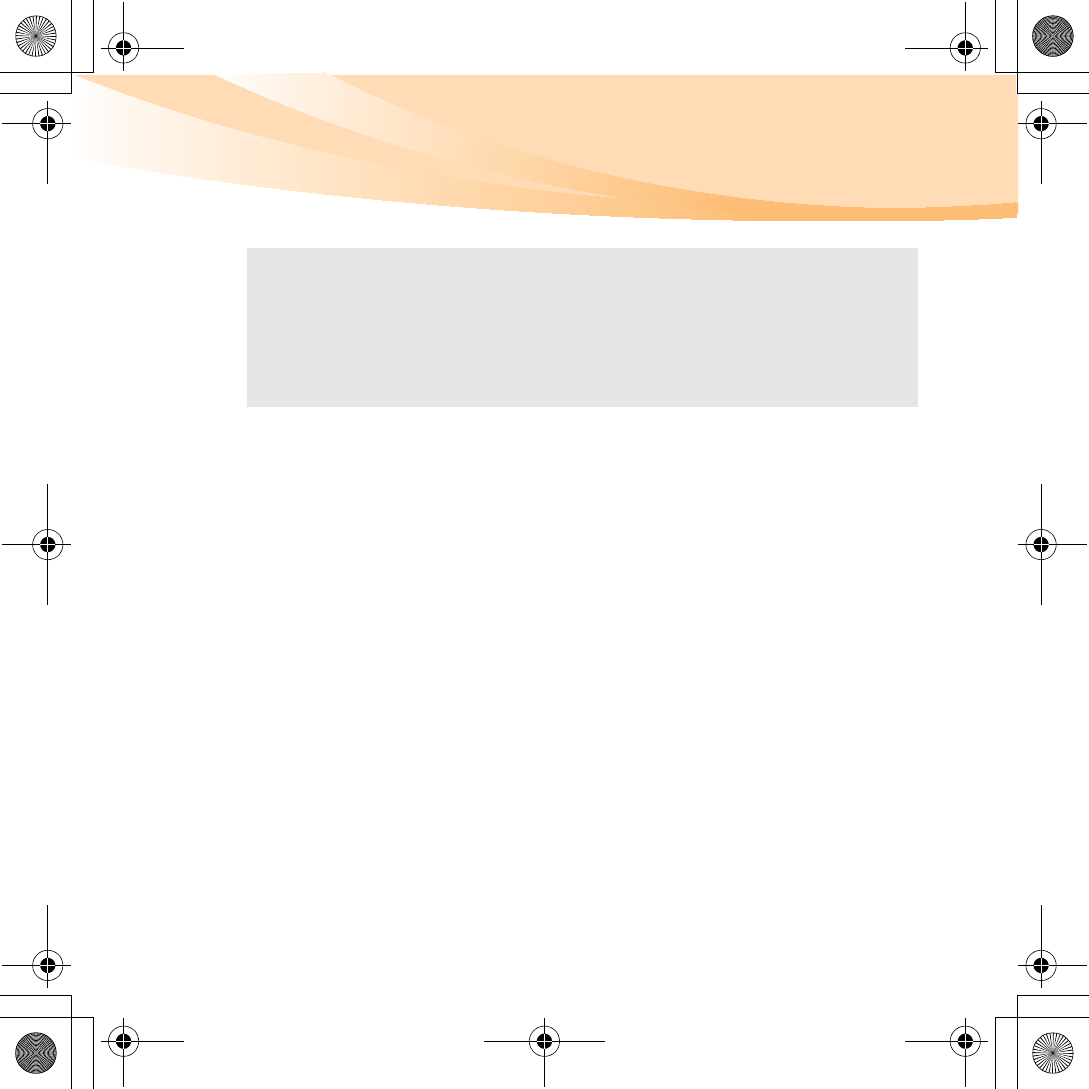
Chapter 2. Learning the basics
11
Removing the battery pack
If you are not going to use the computer for an extended period of time, or
if you need to send your computer to Lenovo for service, etc., remove the
battery pack from the computer. Before removing the battery pack, make
sure the computer has been shut down.
Notes:
•You are advised to insert the battery pack when using your computer to prevent
small particles from entering the inside of your computer.
•To increase the life of the battery pack, the computer does not start recharging
the battery immediately after it drops from fully charged.
•Charge the battery at a temperature between 50 °F and 80 °F (10 °C-30 °C).
•Full charge or discharge is not required.
S10-3 UserGuide V1.0_en.book Page 11 Tuesday, November 10, 2009 11:04 AM
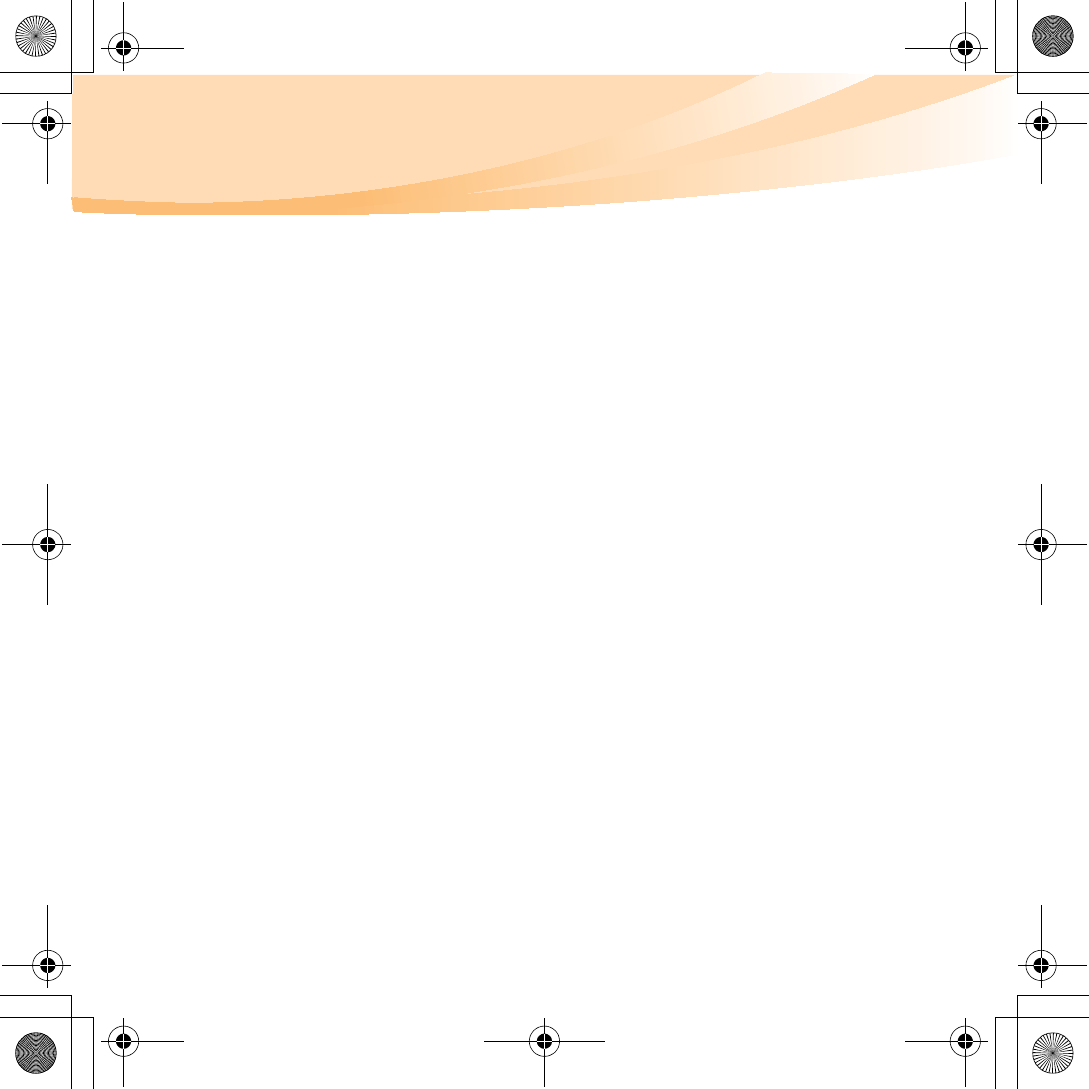
12
Chapter 2. Learning the basics
Handling the battery
If the rechargeable battery pack is replaced with an incorrect type, there may
be danger of an explosion. The battery pack contains a small amount of
harmful substances. To avoid possible injury and detriment to the
environment, pay attention to the following points:
• Replace only with a battery of the type recommended by Lenovo.
• Keep the battery pack away from fire.
• Do not expose the battery pack to water or rain.
• Do not attempt to disassemble the battery pack.
• Do not short-circuit the battery pack.
• Keep the battery pack away from children.
• Do not put the battery pack in trash that is disposed of in landfills. When
disposing of the battery, comply with local ordinances or regulations and
your company’s safety standards.
S10-3 UserGuide V1.0_en.book Page 12 Tuesday, November 10, 2009 11:04 AM
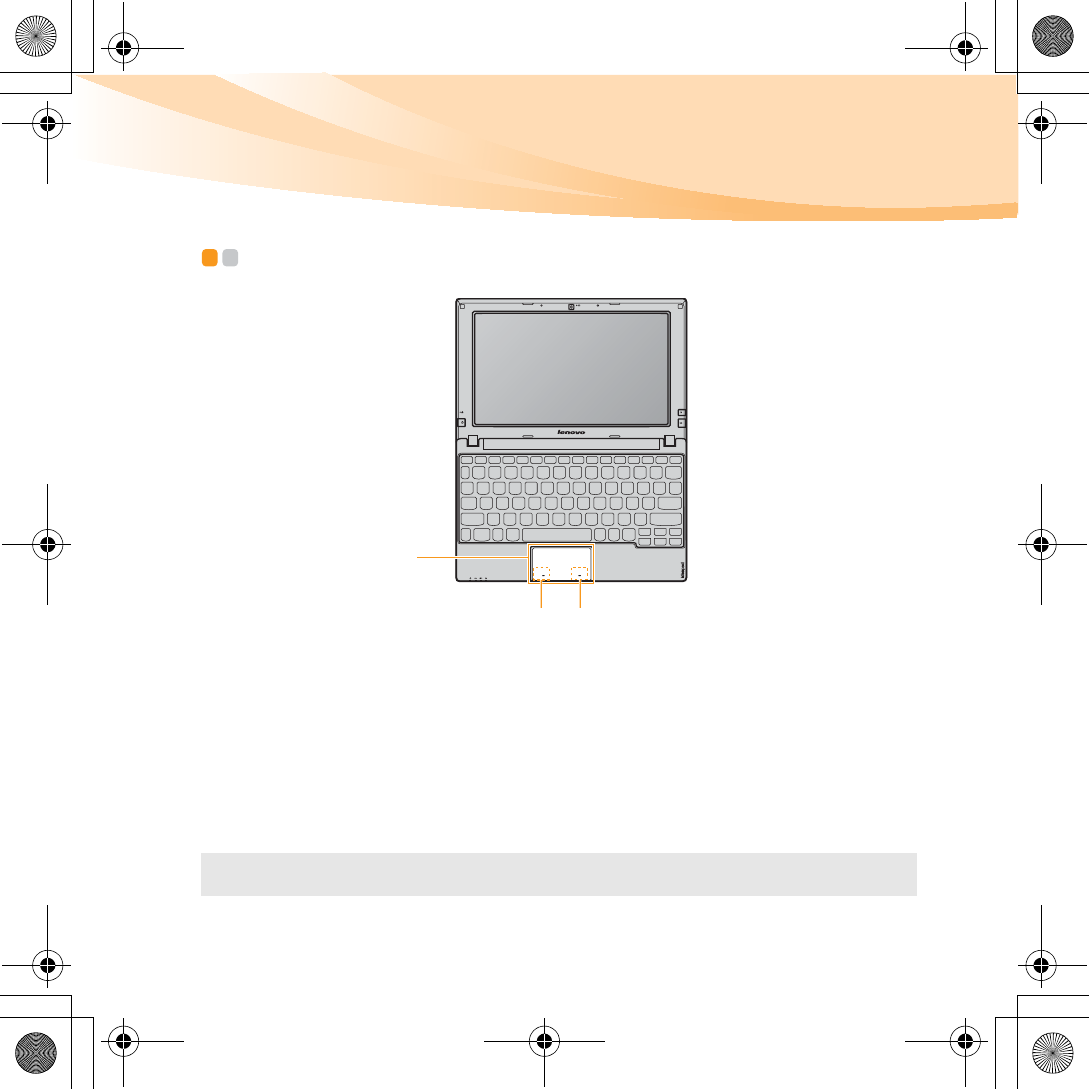
Chapter 2. Learning the basics
13
Using the touchpad - - - - - - - - - - - - - - - - - - - - - - - - - - - - - - - - - - - - - - - - - - - - - - - - - - - - - - - - - - - - - - - - - - - - -
One-piece touchpad To move the cursor on the screen, slide your
fingertip over the pad in the direction in which you
want the cursor to move.
Bottom left area The function corresponds to that of the left mouse
button on a conventional mouse, which can be
implemented by clicking this area.
Bottom right area The function corresponds to that of the right mouse
button on a conventional mouse, which can be
implemented by clicking this area.
Note: You can enable/disable the touchpad using Fn+F6.
a
b
c
S10-3 UserGuide V1.0_en.book Page 13 Tuesday, November 10, 2009 11:04 AM

14
Chapter 2. Learning the basics
Using the keyboard - - - - - - - - - - - - - - - - - - - - - - - - - - - - - - - - - - - - - - - - - - - - - - - - - - - - - - - - - - - - - - - - - - - - -
Your computer has a numeric keypad and function keys incorporated in its
standard keyboard.
Numeric keypad
The keyboard has keys that, when enabled, work as a 10-key numeric
keypad.
To enable or disable the numeric keypad, press Fn+Insert.
Note: The indicator will light on if the numeric keypad is enabled.
7890
P
O
IU
J
M
KL
S10-3 UserGuide V1.0_en.book Page 14 Tuesday, November 10, 2009 11:04 AM
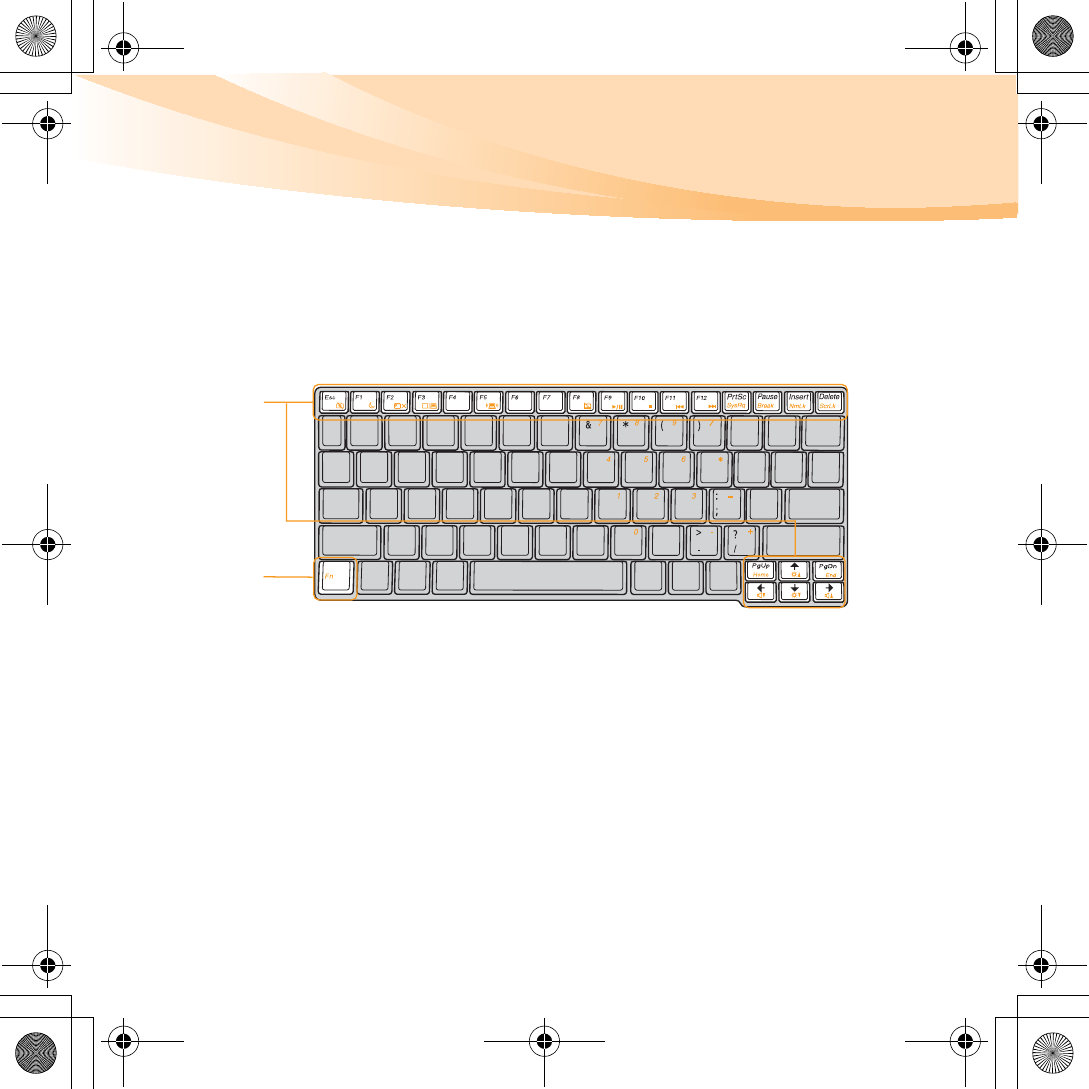
Chapter 2. Learning the basics
15
Function key combinations
Through the use of the function keys, you can change operational features
instantly. To use this function, press and hold Fn ; then press one of the
function keys .
7890
P
O
I
U
J
M
KL
a
b
S10-3 UserGuide V1.0_en.book Page 15 Tuesday, November 10, 2009 11:04 AM

16
Chapter 2. Learning the basics
The following describes the features of each function key.
Fn + Esc: Turn on/off the integrated camera.
Fn + F1: Enter sleep mode.
Fn + F2: Turn on/off the LCD screen.
Fn + F3: Open the interface for the display device switch
to select notebook or external display.
Fn + F4: Open the interface for display resolution settings.
Fn + F5: Open the interface for integrated wireless devices
settings (enable/disable).
Fn + F6: Enable/Disable the touchpad.
Fn + F7: Start/Pause playback of Windows Media Player.
Fn + F8: Stop playback of Windows Media Player.
Fn + F9: Skip to the previous track.
Fn + F10: Skip to the next track.
Fn + F11: Activate the F12 function.
* You can press Fn+F11 during computer startup to open
the boot selection menu.
Fn + PrtSc: Activate the system request.
Fn + Pause: Activate the break function.
Fn + Insert: Enable/Disable the numeric keypad.
Fn + Delete: Enable/Disable the Scroll Lock.
Fn + ↑/↓ :Increase/Decrease display brightness.
Fn + →/← :Increase/Decrease volume level.
S10-3 UserGuide V1.0_en.book Page 16 Tuesday, November 10, 2009 11:04 AM
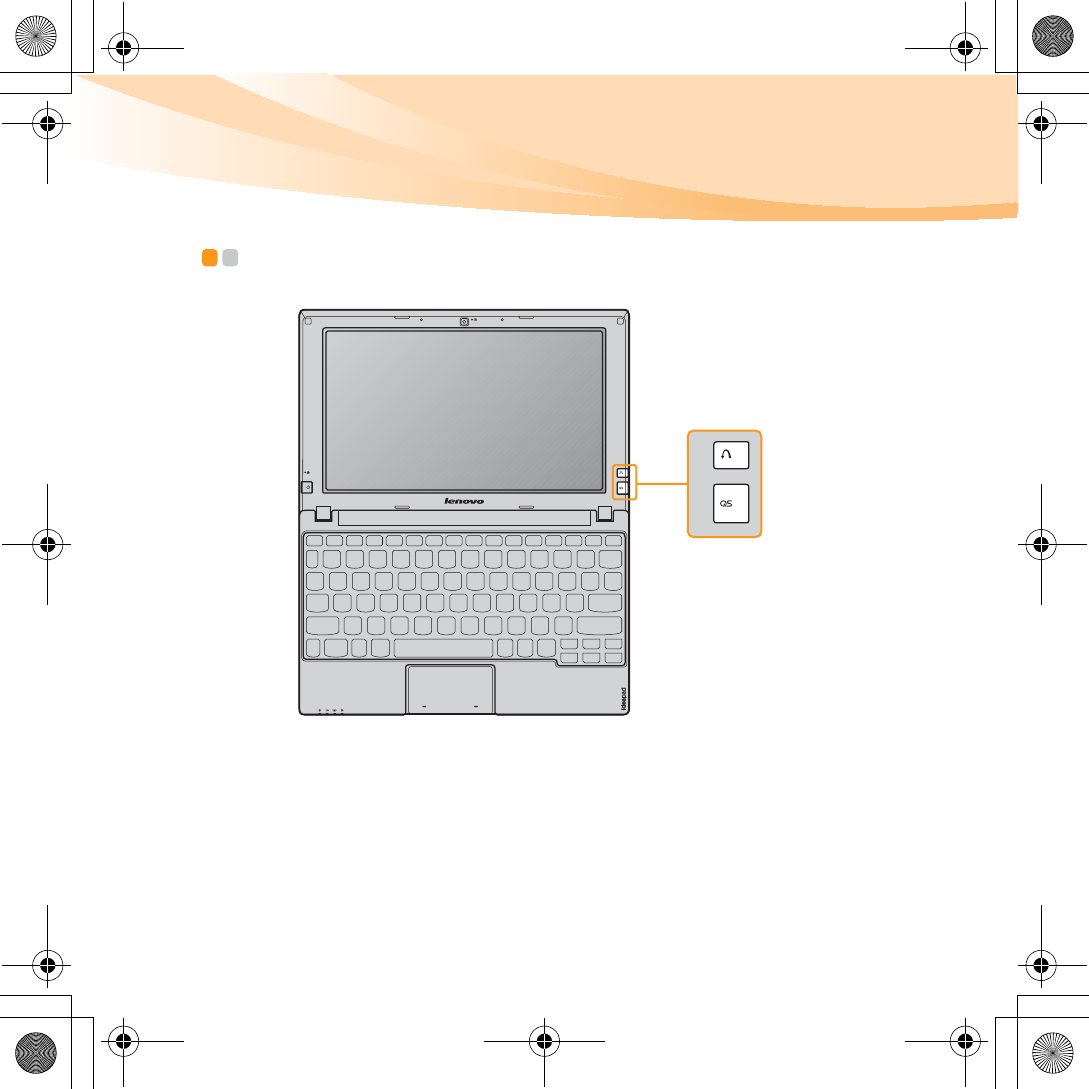
Chapter 2. Learning the basics
17
Special buttons - - - - - - - - - - - - - - - - - - - - - - - - - - - - - - - - - - - - - - - - - - - - - - - - - - - - - - - - - - - - - - - - - - - - - - - - - - - - - -
S10-3 UserGuide V1.0_en.book Page 17 Tuesday, November 10, 2009 11:04 AM
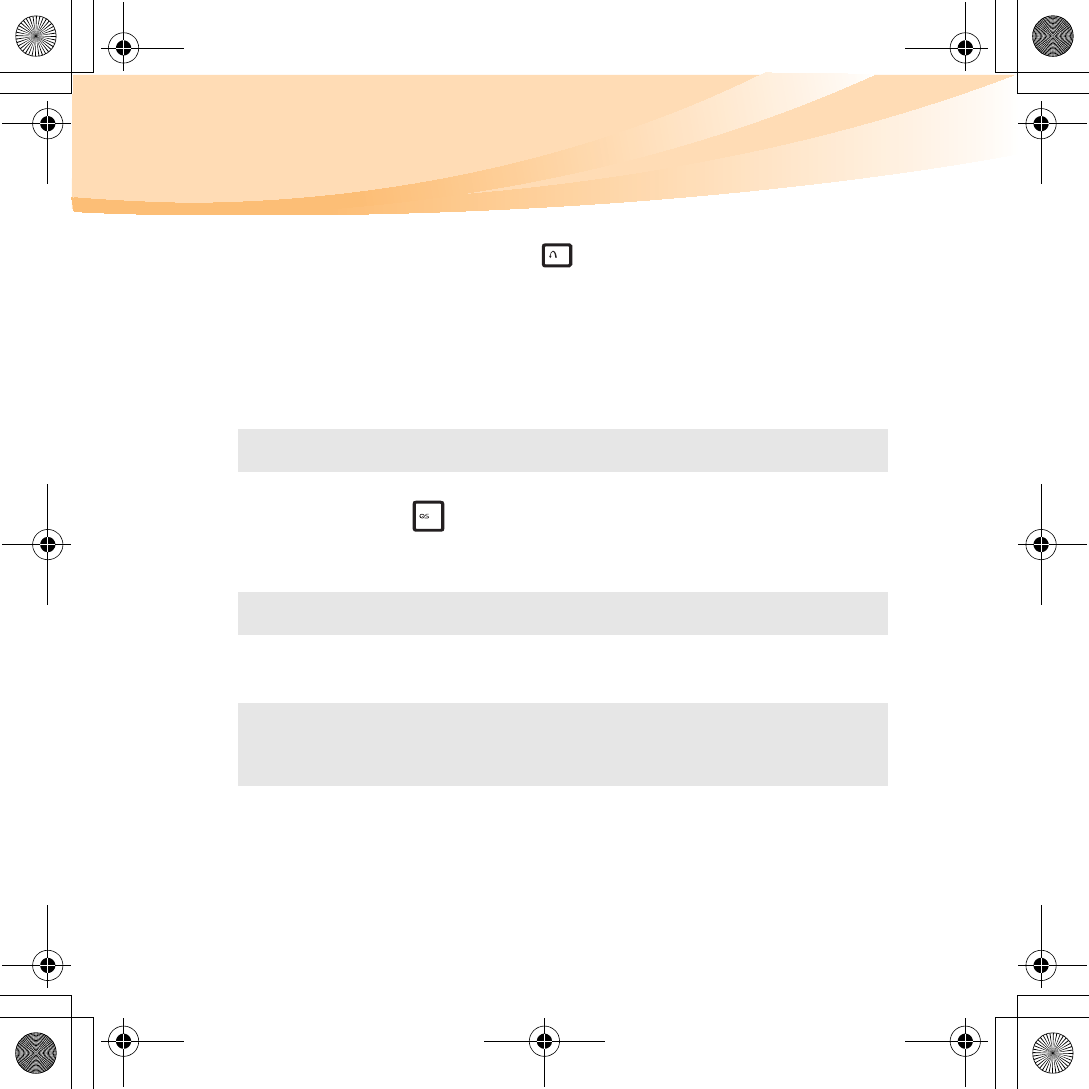
18
Chapter 2. Learning the basics
OneKey Rescue system button
• When the computer is powered off, press this button to enter the
OneKey Rescue system if Lenovo OneKey Rescue system has been
preinstalled.
• Under Windows operating systems, press this button to start Lenovo
OneKey Recovery.
Quick Start button
• When the computer is powered-off, press this button to enter Lenovo
Quick Start if it has been installed.
• Under Windows operating systems, press this button to launch a self-
defined program, file or a Website.
Note:
For details, see “OneKey Rescue system” on page 34.
Note:
For details, see “Using Lenovo Quick Start (select models only)” on page 25.
Note: To re-define the Quick Start button, select Self-defined program setting
(start oAll Programs oLenovo oEnergy Management oSelf-defined
program setting).
S10-3 UserGuide V1.0_en.book Page 18 Tuesday, November 10, 2009 11:04 AM
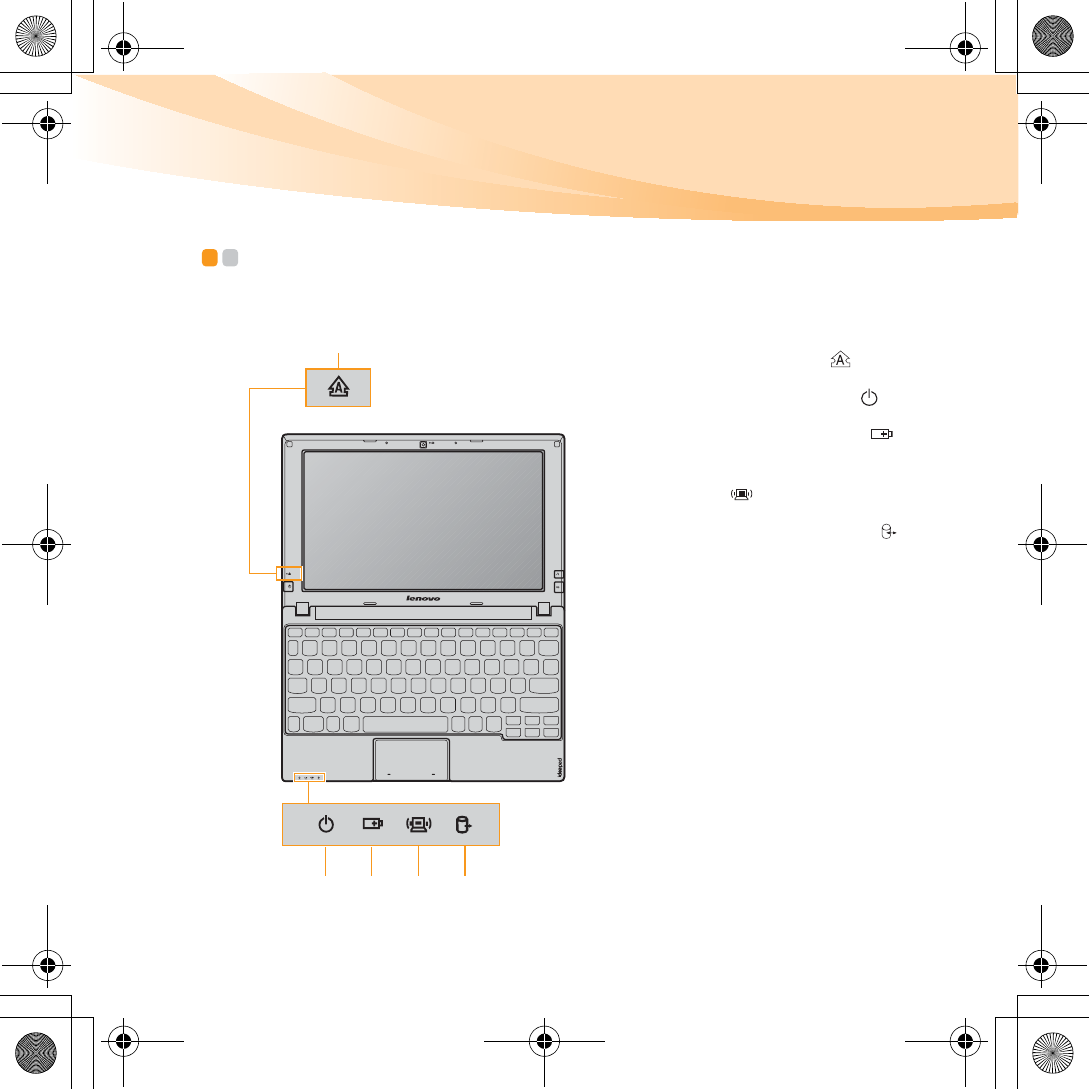
Chapter 2. Learning the basics
19
System status indicators - - - - - - - - - - - - - - - - - - - - - - - - - - - - - - - - - - - - - - - - - - - - - - - - - -
These indicators inform you of the computer status.
b c d e
aCaps lock indicator
Power status indicator
Battery status indicator
Wireless communication
indicator
Hard disk drive indicator
S10-3 UserGuide V1.0_en.book Page 19 Tuesday, November 10, 2009 11:04 AM
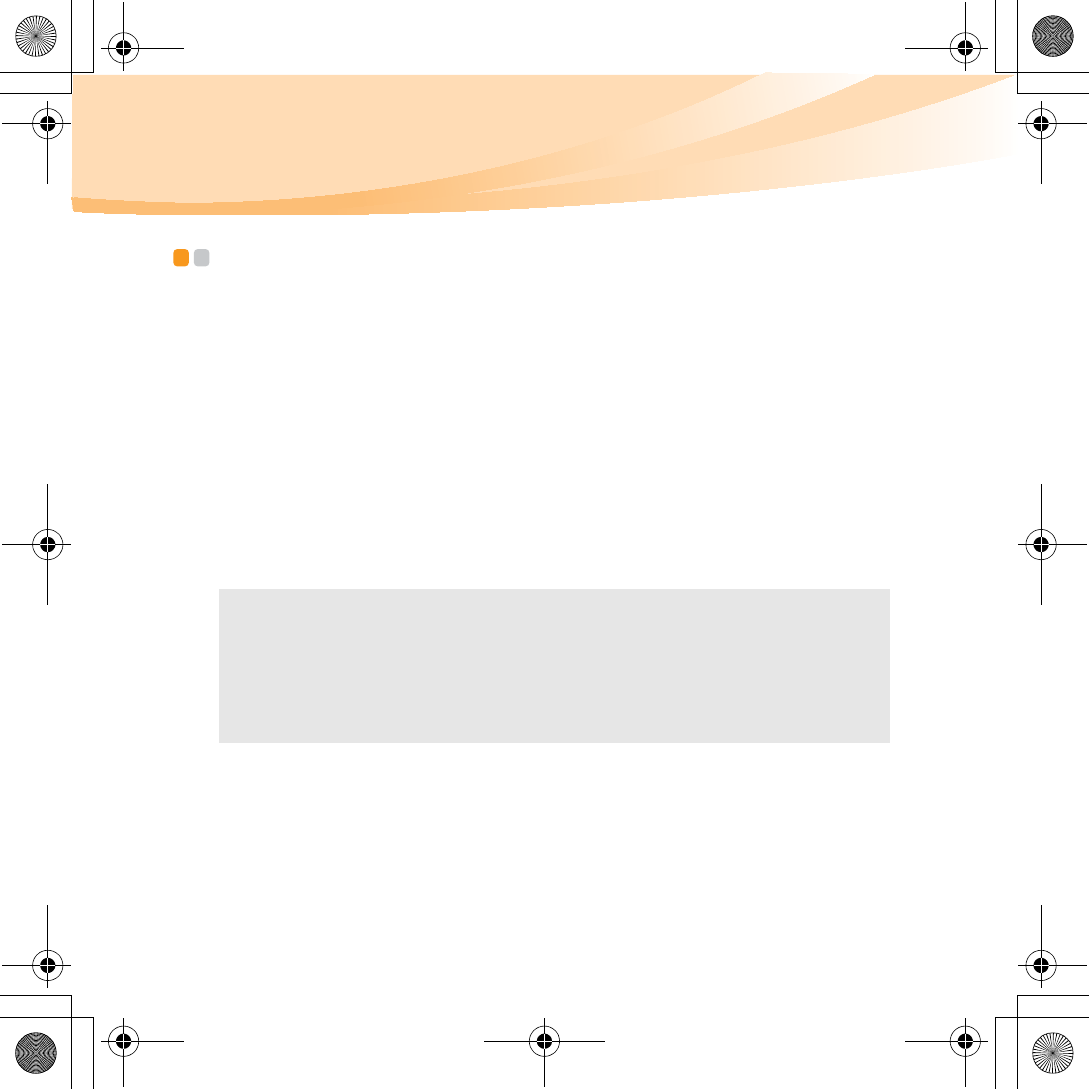
20
Chapter 2. Learning the basics
Securing your computer - - - - - - - - - - - - - - - - - - - - - - - - - - - - - - - - - - - - - - - - - - - - - - - - - - - - - - - - - - -
This section provides information about how to help protect your
computer from theft and unauthorized use.
Attaching a security lock (not supplied)
You can attach a security lock to your computer to help prevent it from
being removed without your permission. For details on installing the
security lock, please refer to the instructions shipped with the security lock
that you have purchased.
Refer to the “Right-side view” on page 4 for the location of the Kensington
slot.
Notes:
•Before purchasing any security product, verify that it is compatible with this
type of security keyhole.
•You are responsible for evaluating, selecting, and implementing the locking
devices and security features. Lenovo offers no comment, judgement, or
warranty regarding the function, quality or performance of locking devices and
security features.
S10-3 UserGuide V1.0_en.book Page 20 Tuesday, November 10, 2009 11:04 AM
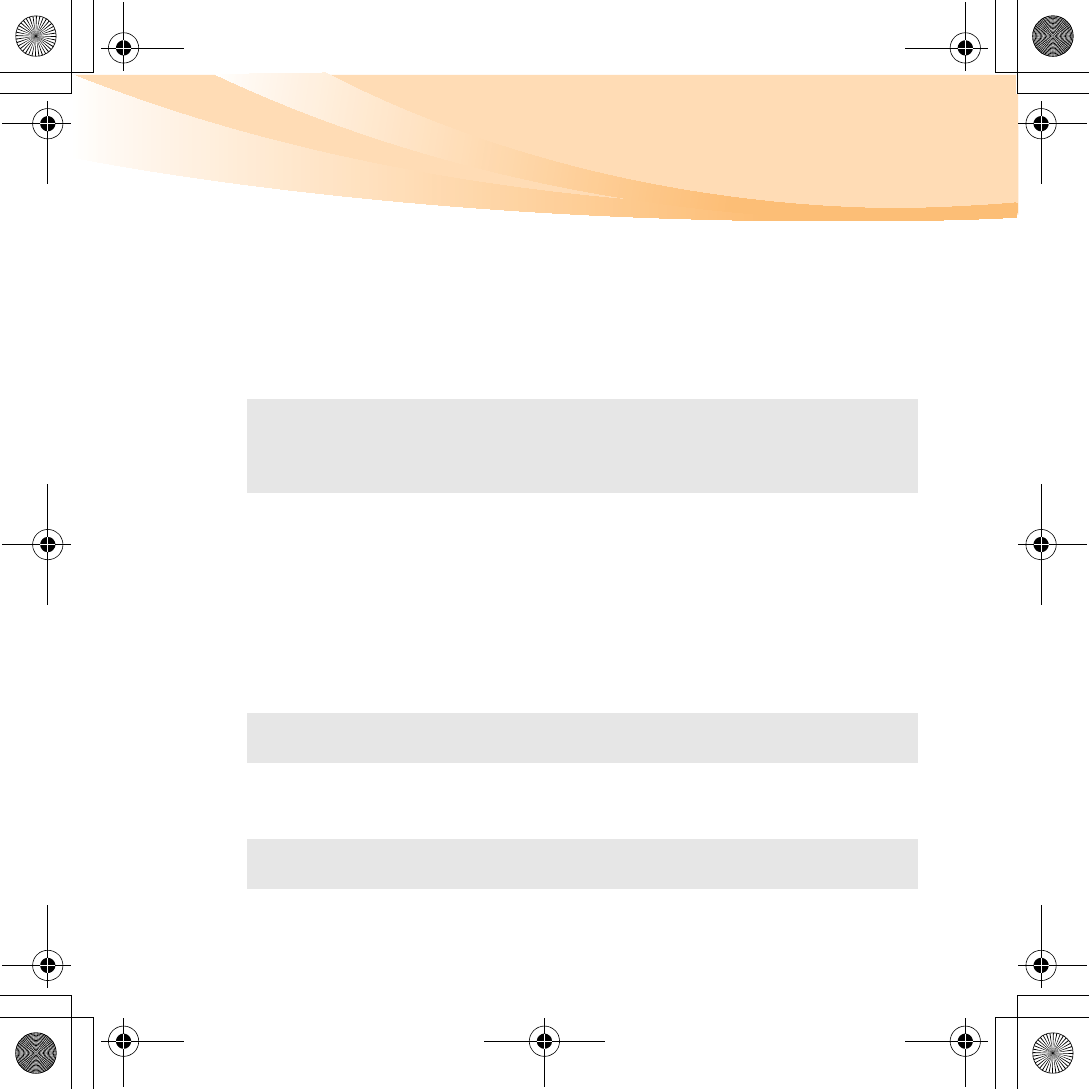
Chapter 2. Learning the basics
21
Using VeriFace™
VeriFace is a face recognition software which takes a digital snapshot,
extracts key features of your face, and creates a digital map that becomes
the system’s “password”.
If you want to activate VeriFace for the first time, click the VeriFace icon on
the desktop to register your facial image.
For more instructions on VeriFace, see the help file on your software.
Using passwords
Using passwords helps prevent your computer from being used by others.
Once you set a password and enable it, a prompt appears on the screen
each time you power on the computer. Enter your password at the prompt.
The computer cannot be used unless you enter the correct password.
For details about how to set the password, see the help to the right of the
screen in BIOS Setup Utility.
Notes:
•The face registration and verification works best in an environment with steady
and even light.
•You can determine whether to use this function when you log on the system.
Note: This password can be from one to seven alphanumeric characters in any
combination.
Note: To enter BIOS Setup Utility, press F2 when the Lenovo logo appears on the
screen while the computer is starting up.
S10-3 UserGuide V1.0_en.book Page 21 Tuesday, November 10, 2009 11:04 AM
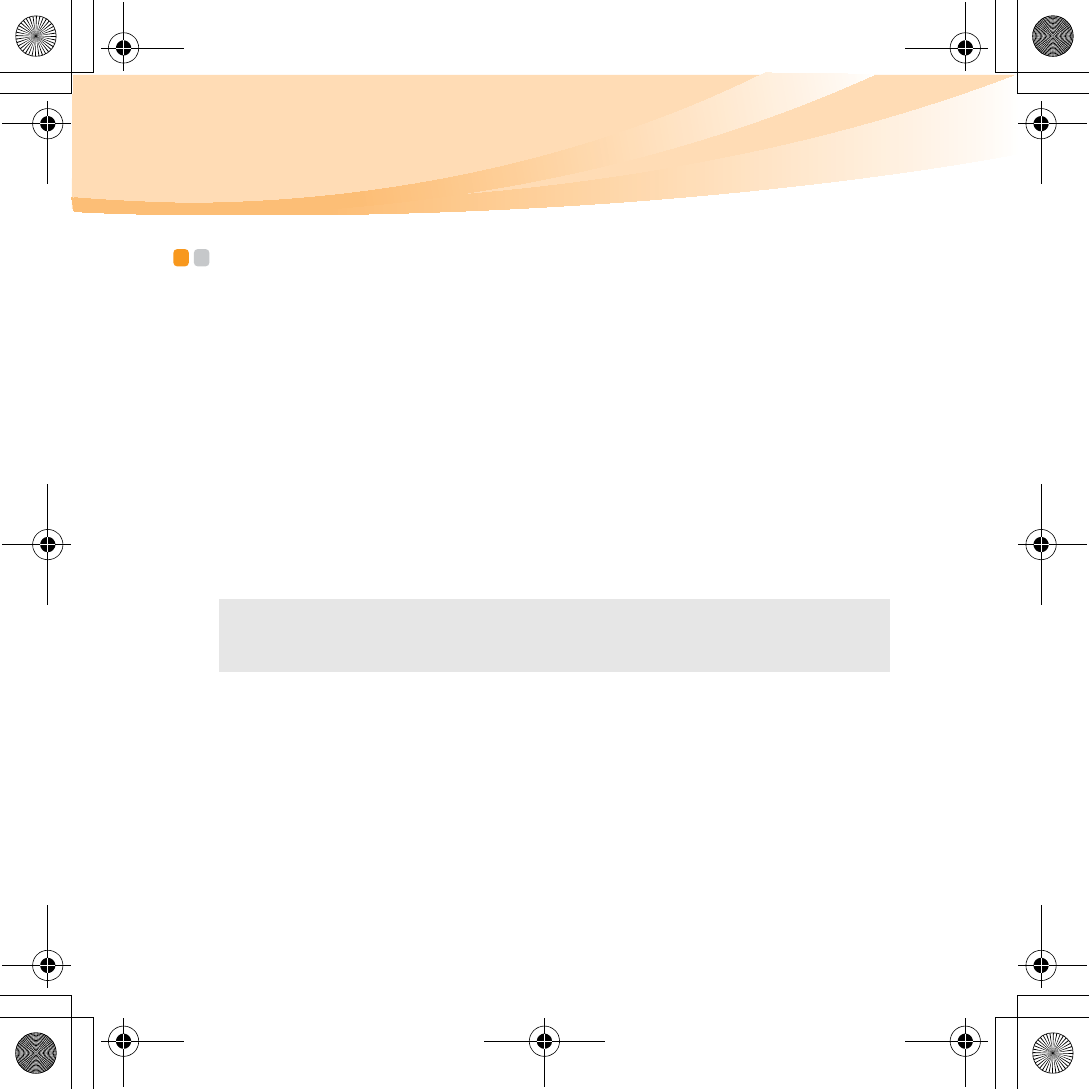
22
Chapter 2. Learning the basics
Connecting external devices - - - - - - - - - - - - - - - - - - - - - - - - - - - - - - - - - - - - - - - - -
Your computer has a wide range of built-in features and connection
capabilities.
Using memory cards (not supplied)
Your computer supports the following types of memory cards:
• Secure Digital (SD) card
• High Capacity Secure Digital (SDHC) card
• MultiMediaCard (MMC)
• Memory Stick (MS)
• Memory Stick PRO (MS PRO)
Notes:
•Insert ONLY one card in the slot at a time.
•This card reader does not support SDIO devices (e.g., SDIO Bluetooth, etc.).
S10-3 UserGuide V1.0_en.book Page 22 Tuesday, November 10, 2009 11:04 AM
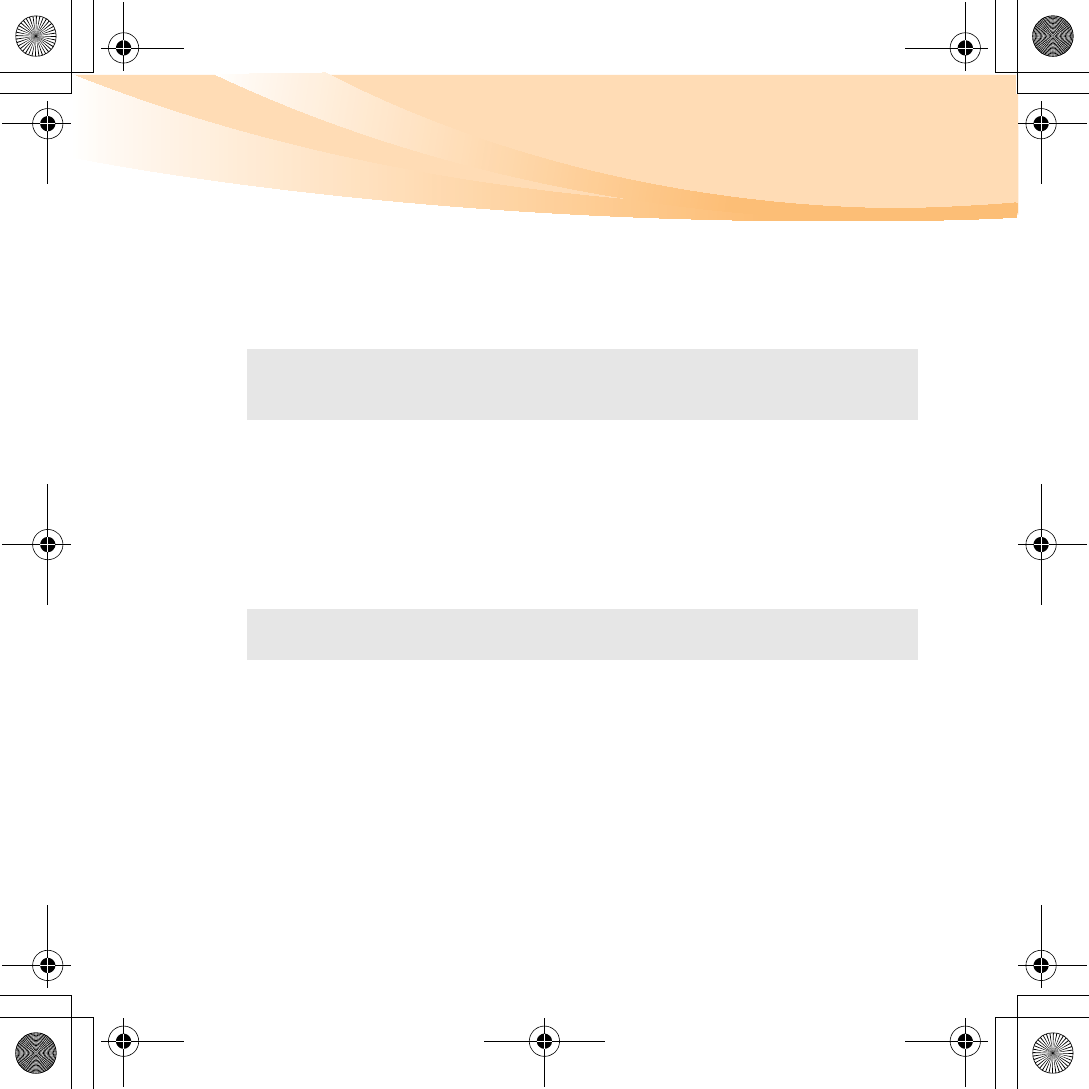
Chapter 2. Learning the basics
23
Inserting a memory card
1
Push the dummy card until you hear a click. Gently pull the dummy
card out of the memory card slot.
2
Slide the memory card in until it clicks into place.
Removing a memory card
1
Push the memory card until you hear a click.
2
Gently pull the memory card out of the memory card slot.
Note: The dummy card is used for preventing dust and small particles from
entering the inside of your computer when the memory card slot is not in use.
Retain the dummy card for future use.
Note: Before removing the memory card, disable it via Windows safely remove
hardware and eject media utility to avoid data corruption.
S10-3 UserGuide V1.0_en.book Page 23 Tuesday, November 10, 2009 11:04 AM
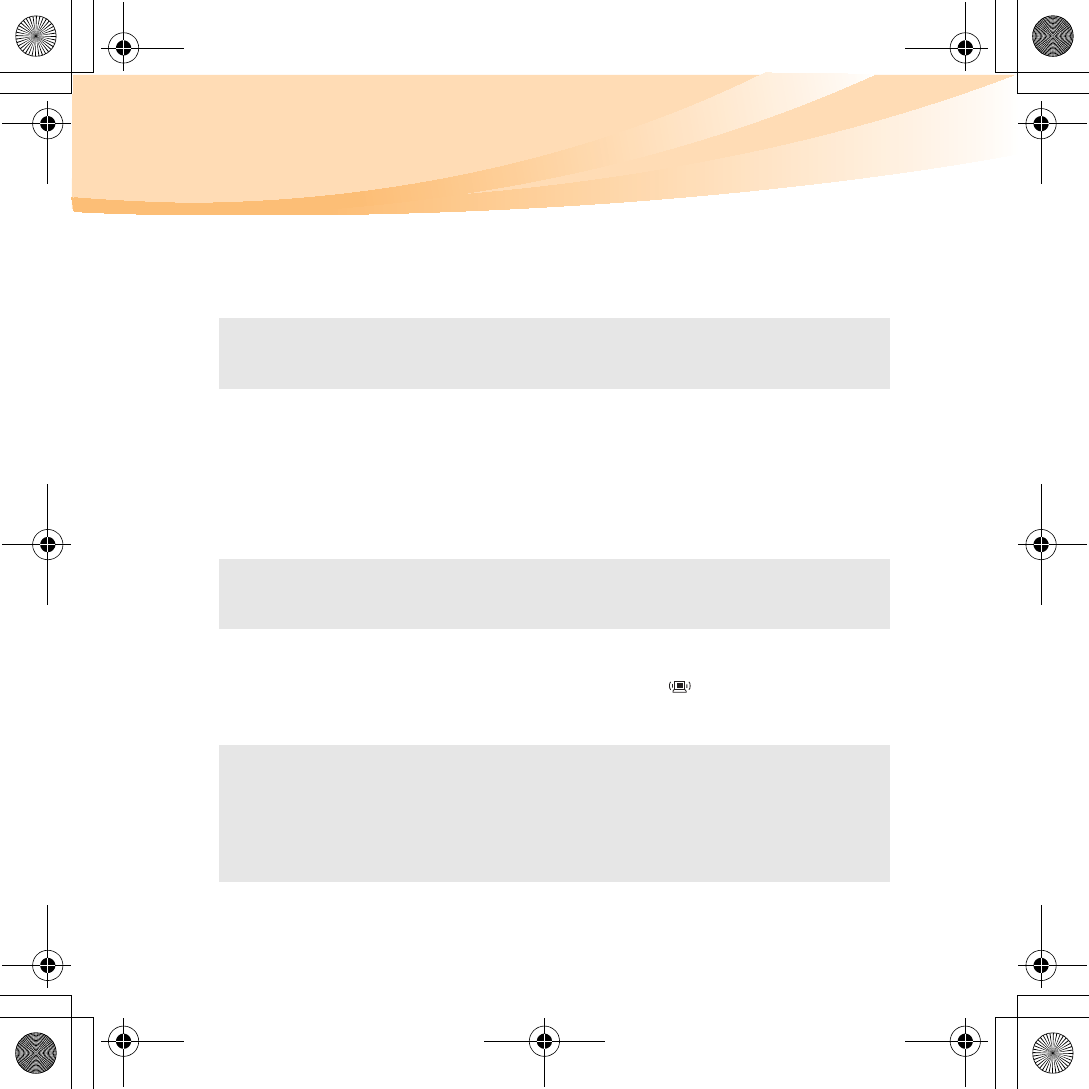
24
Chapter 2. Learning the basics
Connecting a universal serial bus (USB) device
Your computer comes with three USB ports compatible with USB devices.
Connecting a Bluetooth enabled device (select models only)
If your computer has an integrated Bluetooth adapter card, it can connect to
and transfer data wirelessly to other Bluetooth enabled devices, such as
notebook computers, PDAs and cell phones. You can transfer data between
these devices without cables at up to 10 meters range in open space.
Enabling Bluetooth communications on your computer
1
Slide the integrated wireless device switch to .
2
Press Fn +F5 to make configuration.
Note: When using a high power consumption USB device such as USB ODD, use
the external device’s power adapter. Otherwise, the device may not be
recognized, and system shut down may result.
Note: The actual maximum range may vary due to interference and transmission
barriers. To get the best possible connection speed, place the device as near
your computer as possible.
Notes:
•When you do not need to use the Bluetooth function, turn it off to save battery
power.
•You need to pair the Bluetooth enabled device with your computer before you can
transfer data between them. Read the documentation supplied with the Bluetooth
enabled device for details on how to pair the device with your computer.
S10-3 UserGuide V1.0_en.book Page 24 Tuesday, November 10, 2009 11:04 AM
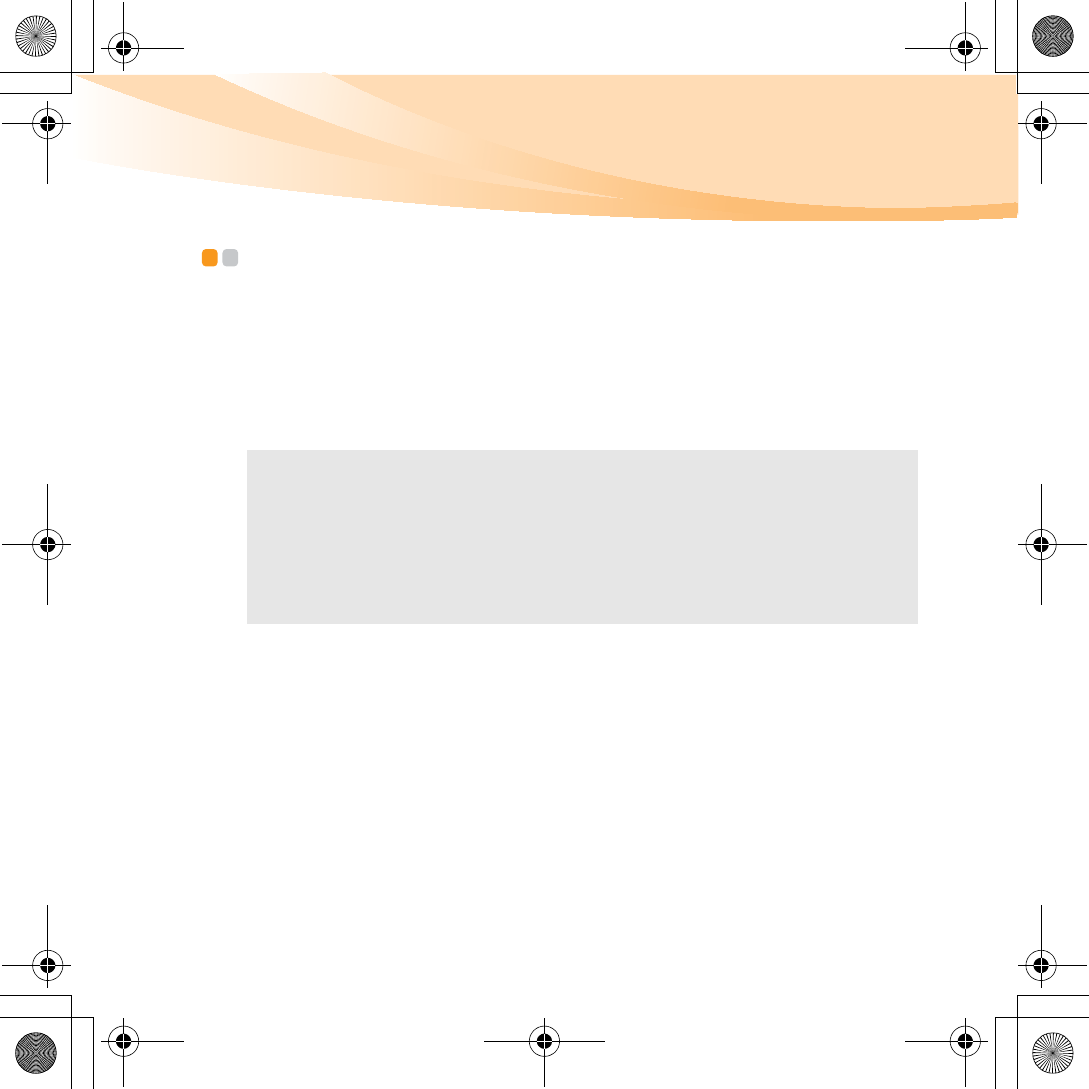
Chapter 2. Learning the basics
25
Using Lenovo Quick Start
(select models only) - - - - - - - - - - - - - - - - - - - - - - - - - - - - - - - - - - - - - - - - - - - - - - - - - - - - - - - - - - - - - -
With a boot time of just a few seconds, Lenovo Quick Start offers a handy
environment that allows you to enjoy an instant access to functions such as
Web browsing, instant messaging and other entertainment functions
without entering the traditional operating system.
Notes:
•If Lenovo Quick Start is not installed, a prompt notice will appear on the screen
when you start it.
•The Web browser of Lenovo Quick Start is designed for you to get an instant
access to online information and does not fully support video streaming. You
may experience low frame rate when watching online video in Lenovo Quick
Start. To view online video, restart the computer to your Windows operating
system and use Internet Explorer to play the online video.
S10-3 UserGuide V1.0_en.book Page 25 Tuesday, November 10, 2009 11:04 AM
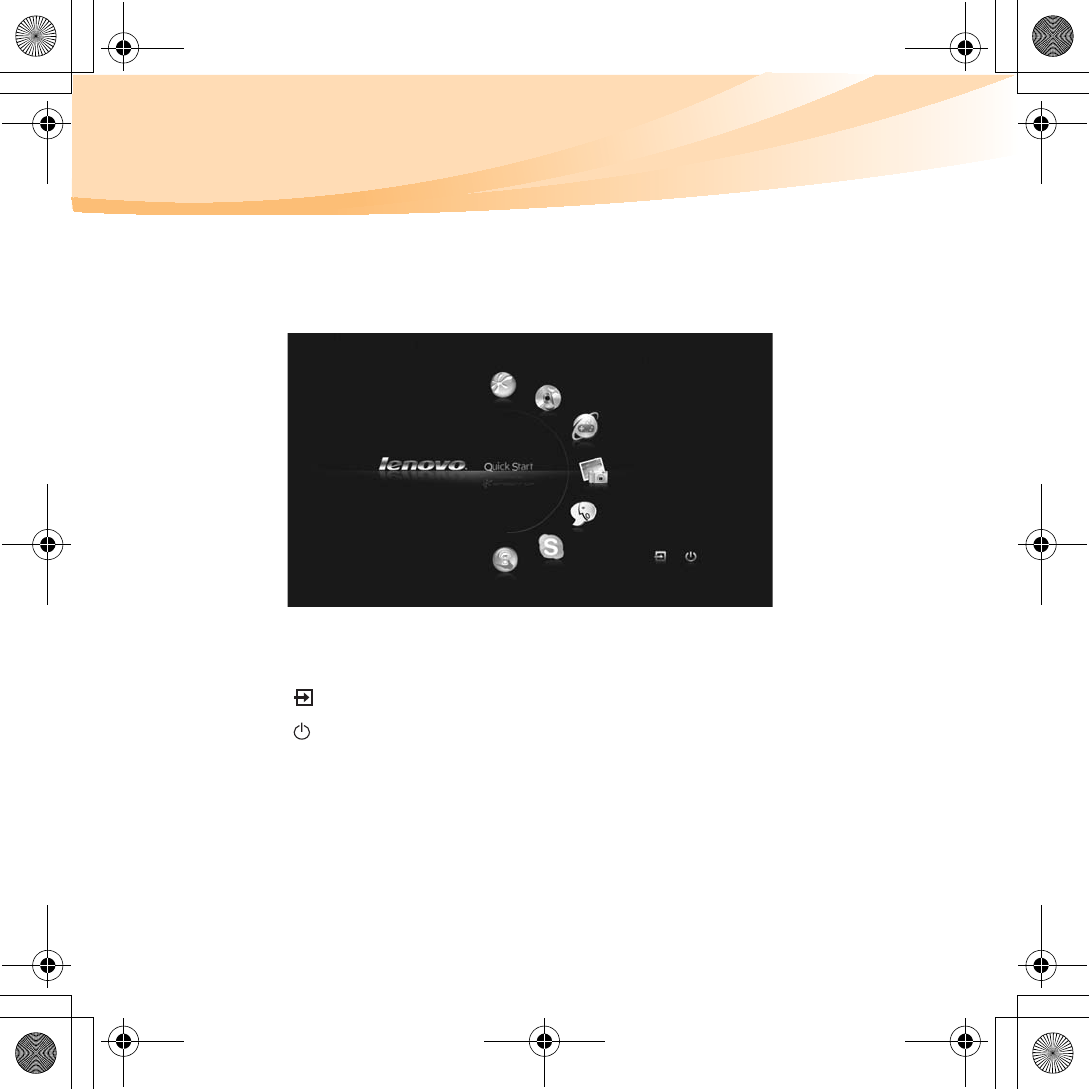
26
Chapter 2. Learning the basics
Starting Lenovo Quick Start
Press the QS button when the computer is powered-off. The following will
appear on the screen after a few seconds.
Exiting Lenovo Quick Start
• Click to restart the computer.
• Click to turn off the computer.
S10-3 UserGuide V1.0_en.book Page 26 Tuesday, November 10, 2009 11:04 AM
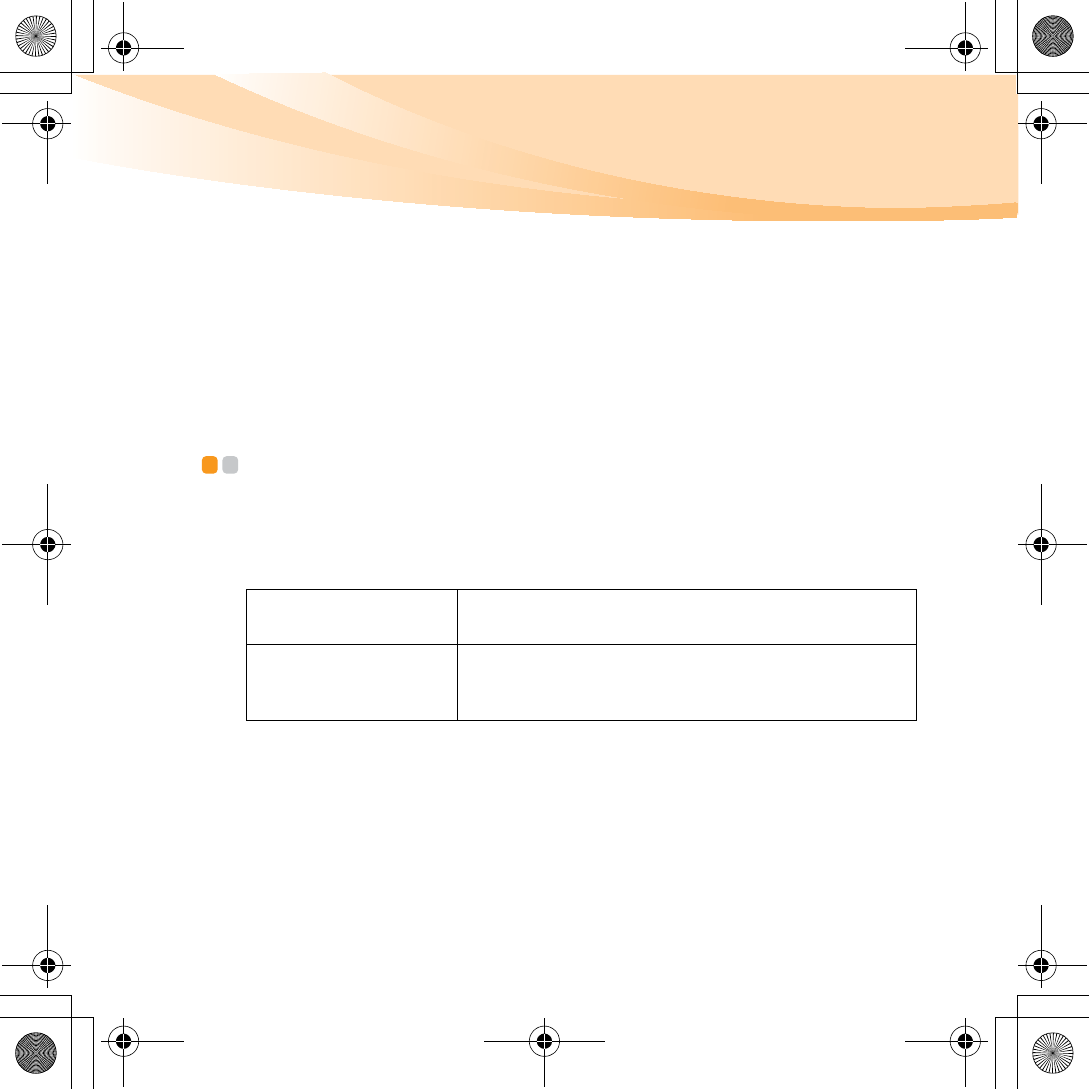
27
Chapter 3. Using the Internet
As a global network, the Internet connects computers worldwide,
providing services such as e-mailing, information searching, electronic
commerce, Web browsing and entertainment.
You can connect the computer to the Internet in the following ways:
Wired connection: uses physical wiring to connect.
Wireless network technology: connect without wiring.
Wired connection - - - - - - - - - - - - - - - - - - - - - - - - - - - - - - - - - - - - - - - - - - - - - - - - - - - - - - - - - - - - - - - - - - - - -
Wired connections are a reliable and safe way to connect the computer to
the Internet. Generally, the following two accessing methods are widely
used.
Cable Cable Internet services use a cable modem connected to
the residential cable TV line.
DSL DSL is a family of related technologies that bring
high-speed network access to homes and small
businesses over ordinary telephone lines.
S10-3 UserGuide V1.0_en.book Page 27 Tuesday, November 10, 2009 11:04 AM
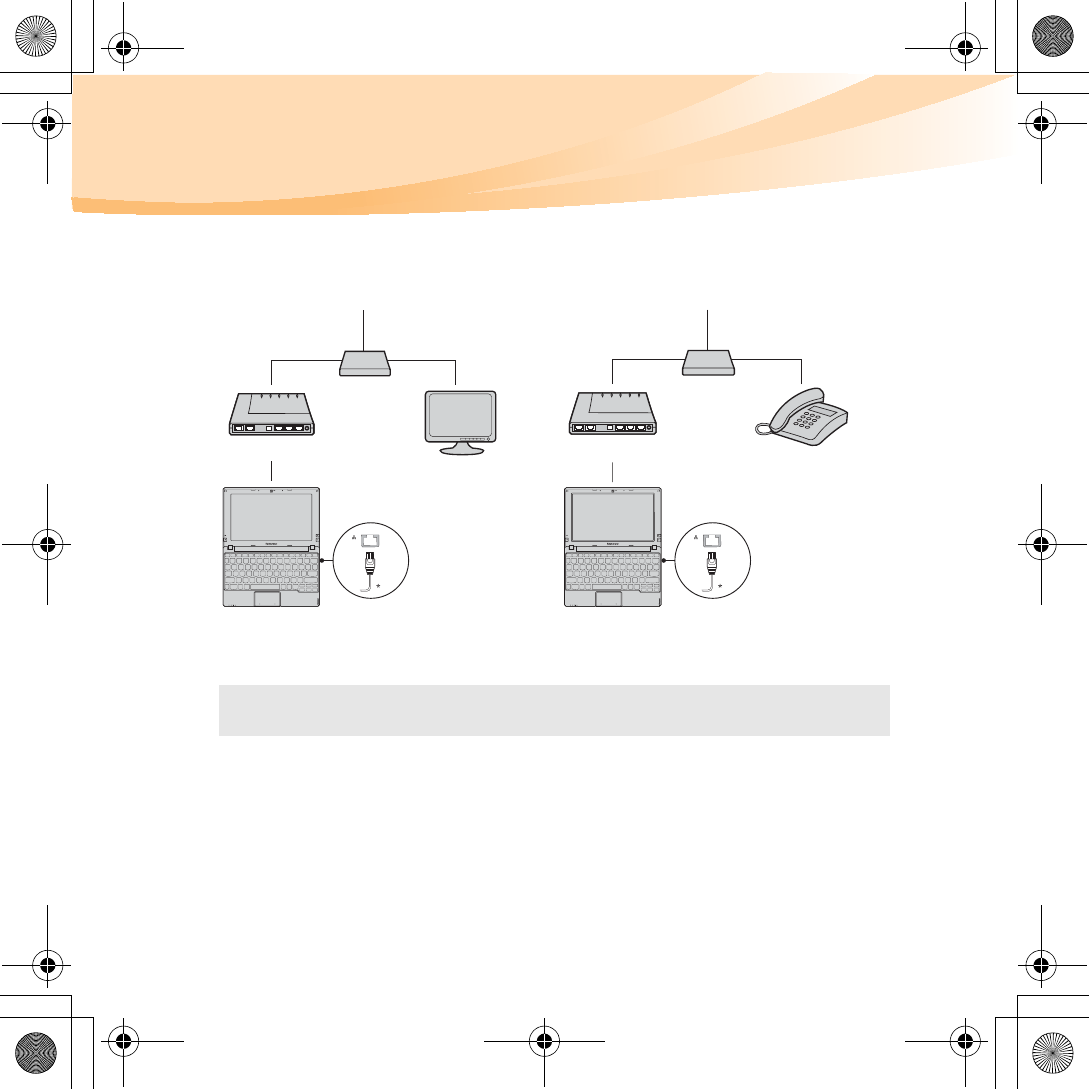
28
Chapter 3. Using the Internet
Hardware connection:
Cable DSL
Software configuration
Consult your Internet Service Provider (ISP) for details on how to configure
your computer.
Note: The above diagrams are for reference only. Actual connection method may
vary.
TV cable
Splitter *
Cable modem *
* Not supplied.
Telephone line
Splitter *
DSL modem *
S10-3 UserGuide V1.0_en.book Page 28 Tuesday, November 10, 2009 11:04 AM
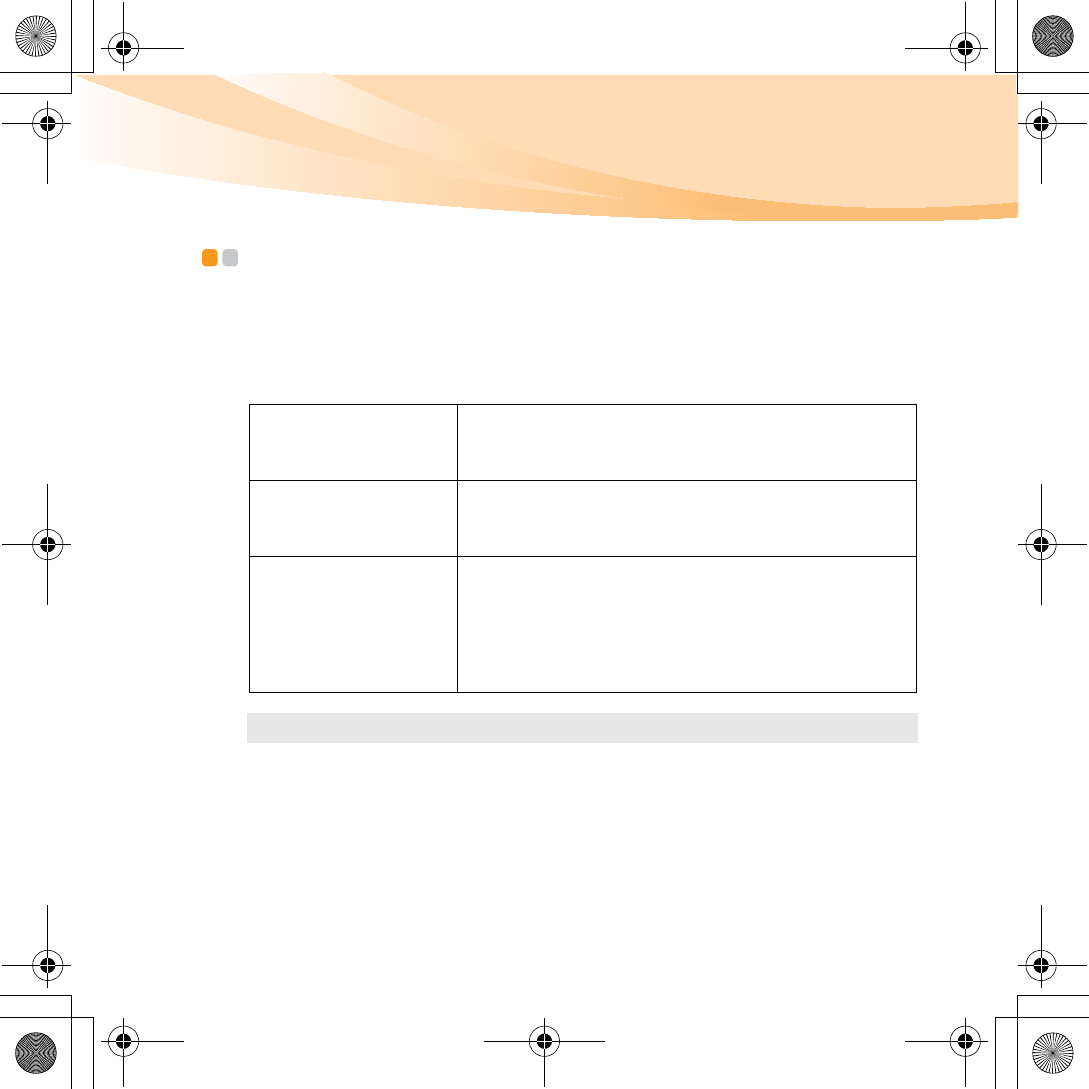
Chapter 3. Using the Internet
29
Wireless connection - - - - - - - - - - - - - - - - - - - - - - - - - - - - - - - - - - - - - - - - - - - - - - - - - - - - - - - - - - - - - - - - - - - -
Wireless connections provide mobile access to the Internet, allowing you to
stay online anywhere the wireless signal covers.
Divided by the signal scales, wireless connection to the Internet can be built
based on the following standards.
Wi-Fi Wi-Fi networks cover a small physical area, like a home,
office, or small group of buildings. An access point is
necessary for the connection.
WiMAX WiMAX networks connect several Wireless LAN systems
to cover a metropolitan area, providing high-speed
broadband access without the need for cables.
Mobile Broadband The Mobile Broadband network provides Internet access
to computers, cell phones and other devices over a large
geographic area. Mobile networks are used for data
transmission, and access is usually provided by a mobile
network operator. A Mobile Broadband SIM card is
necessary for the connection.
Note: Your computer may not support all wireless connection methods.
S10-3 UserGuide V1.0_en.book Page 29 Tuesday, November 10, 2009 11:04 AM
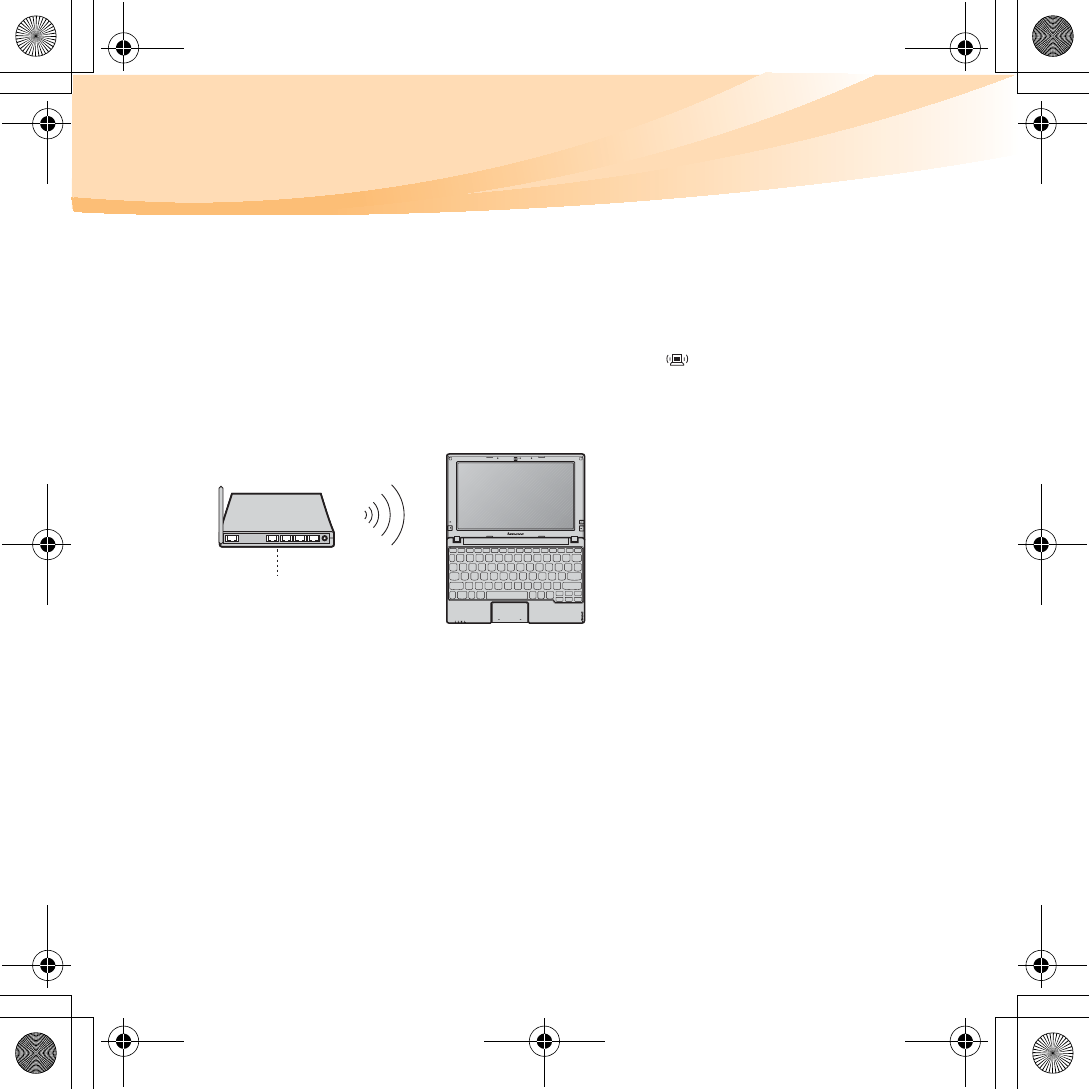
30
Chapter 3. Using the Internet
Using Wi-Fi/WiMax (select models only)
Enabling wireless connection
To enable wireless communications, do the following:
1
Slide the integrated wireless device switch to .
2
Press Fn + F5 to make configuration.
Hardware connection
Software configuration
Consult your Internet Service Provider (ISP) and search Windows Help and
Support Center for details on how to configure your computer.
Access point *
Wi-Fi/WiMax network
* Not supplied
S10-3 UserGuide V1.0_en.book Page 30 Tuesday, November 10, 2009 11:04 AM
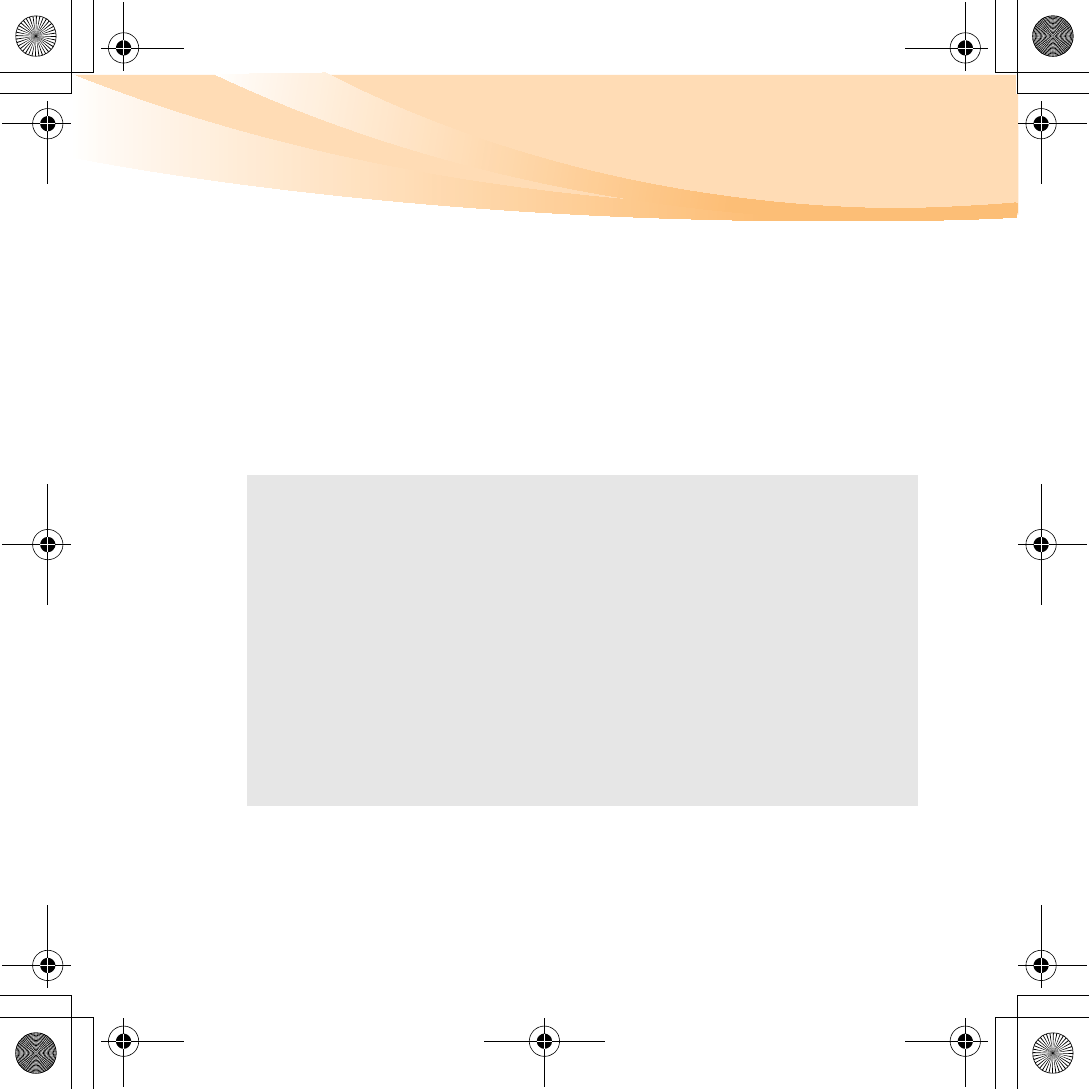
Chapter 3. Using the Internet
31
Using Mobile Broadband (select models only)
Before getting started with Mobile Broadband, you first need to choose a
mobile network operator and make sure you are in the coverage area of the
network. After that, you also need:
• To activate the Mobile Broadband service through your local mobile
network operator. You will get a Subscriber Identity Module (SIM) card
after activation. For instructions on inserting the SIM card, refer to
“Inserting the SIM card” on page 32.
Notes:
•Various standards are in use by mobile operators to provide Mobile Broadband
services. The Lenovo Mobile Broadband module may support one or more of the
following standards:
GSM (Global System for Mobile Communications)
TD-SCDMA (Time Division-Synchronous Code Division Multiple Access)
SCDMA (Synchronous Code Division Multiple Access)
EV-DO (Evolution Data Optimized)
HSPA (High Speed Packet Access)
•Mobile Broadband is a subscription service. Refer to your local mobile network
operator for availability, cost and other information.
•A SIM card is a type of smart card used by mobile network operators to identify
their service subscribers on the mobile network. You will get the SIM card from
your mobile network operator after you have activated the Mobile Broadband
service.
S10-3 UserGuide V1.0_en.book Page 31 Tuesday, November 10, 2009 11:04 AM
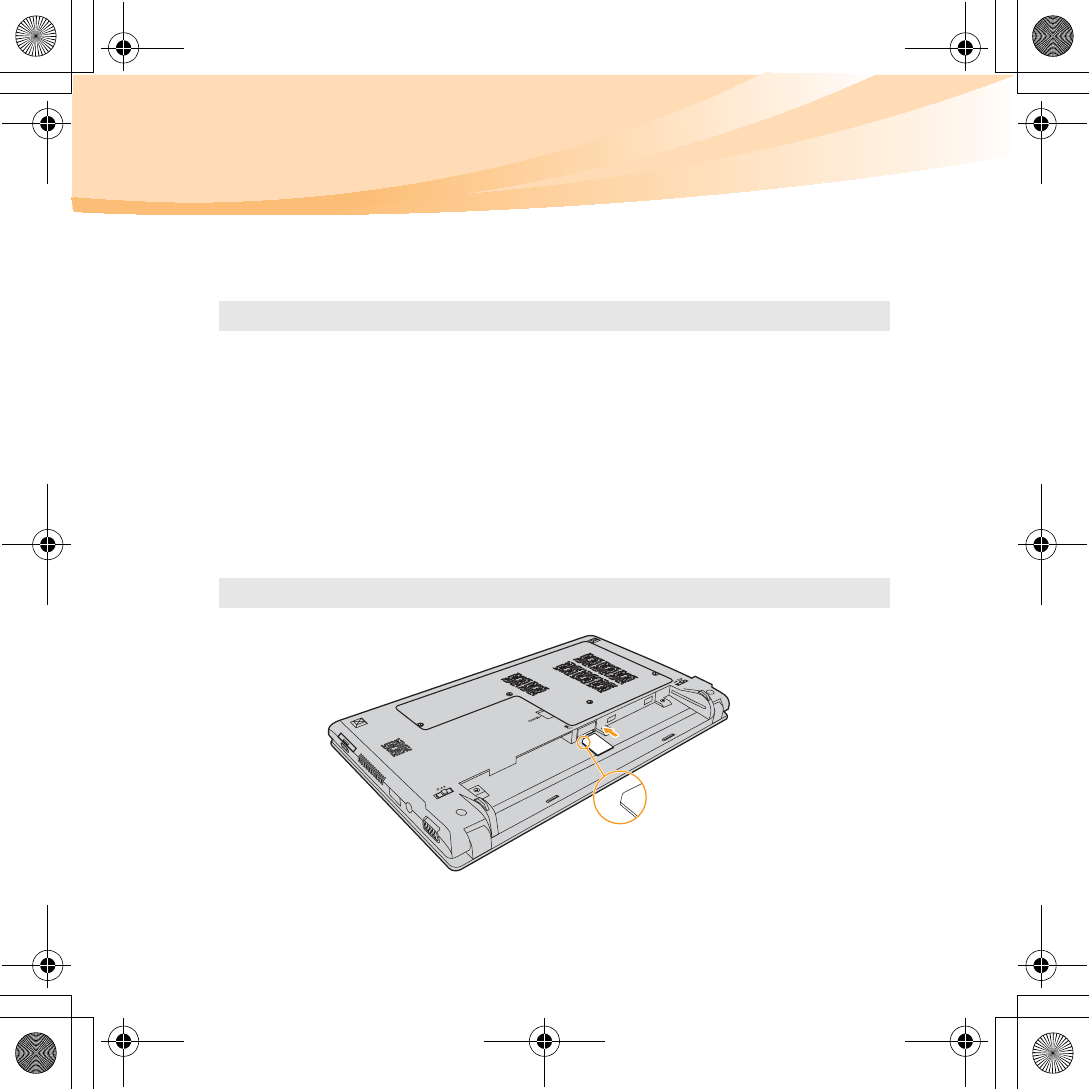
32
Chapter 3. Using the Internet
• A connection management utility to connect/disconnect to your Mobile
Broadband network.
Inserting the SIM card
To insert the SIM card:
1
Turn off the computer; then disconnect the AC adapter and all cables
from the computer.
2
Close the computer display and turn it over.
3
Remove the battery.
4
Insert the SIM card to the card slot until it clicks into place as shown in
the illustration.
Note: In general, your mobile service provider provides this utility.
Note: Inserting the SIM card in the wrong direction may damage the SIM card slot.
Notched Corner
S10-3 UserGuide V1.0_en.book Page 32 Tuesday, November 10, 2009 11:04 AM
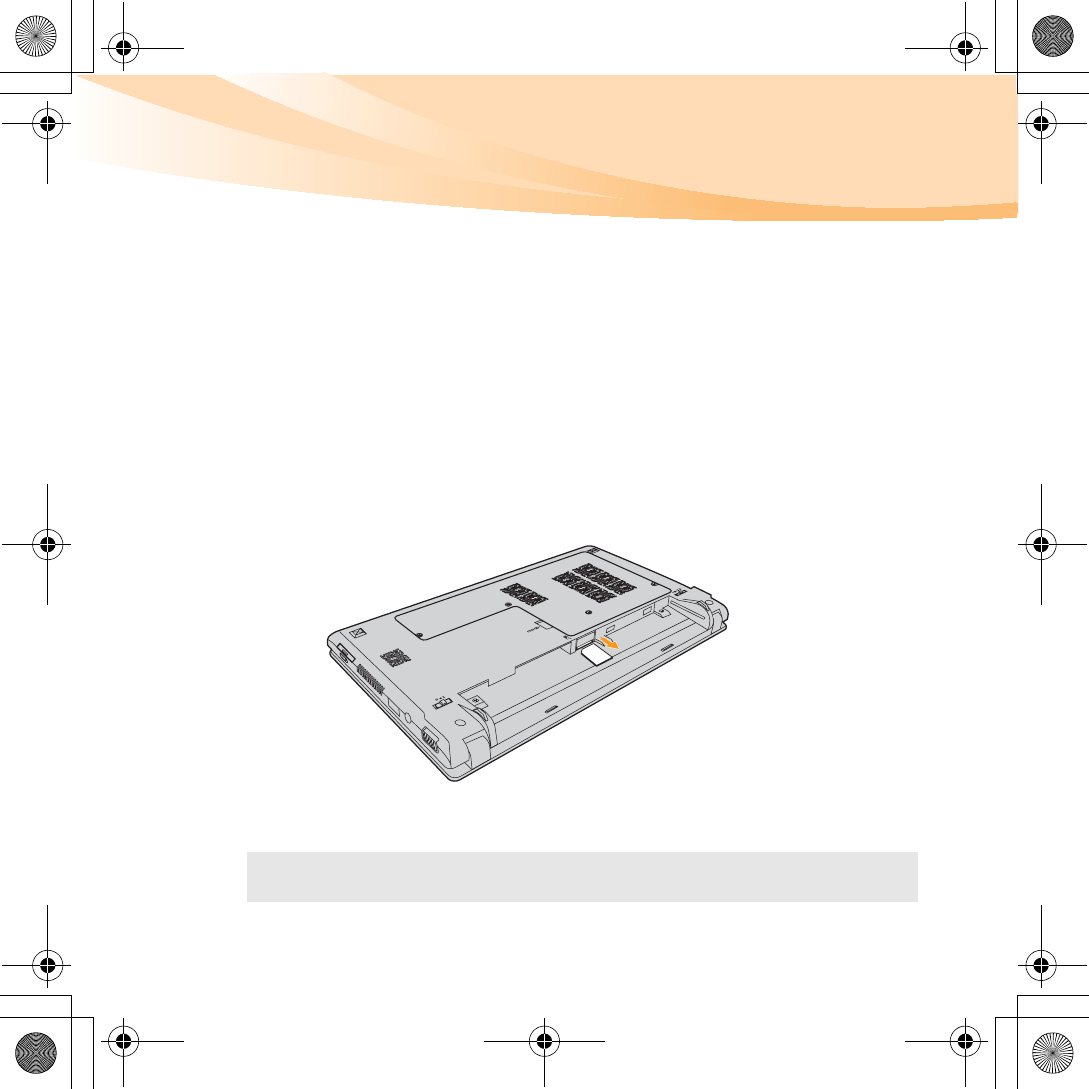
Chapter 3. Using the Internet
33
5
Put the battery back in place. Turn the computer over and reconnect
the cables.
Removing the SIM card
To remove the SIM card:
1
Turn off the computer, then disconnect the AC adapter and all cables
from the computer.
2
Close the computer display and turn it over.
3
Remove the battery.
4
Push the SIM card in until you hear a click, and then pull the SIM card
out.
5
Put the battery back in place. Turn the computer over and reconnect
the cables.
Note: Never insert or remove the SIM card while the computer is on. Doing so may
cause permanent damage to the SIM card as well as the SIM card reader.
S10-3 UserGuide V1.0_en.book Page 33 Tuesday, November 10, 2009 11:04 AM
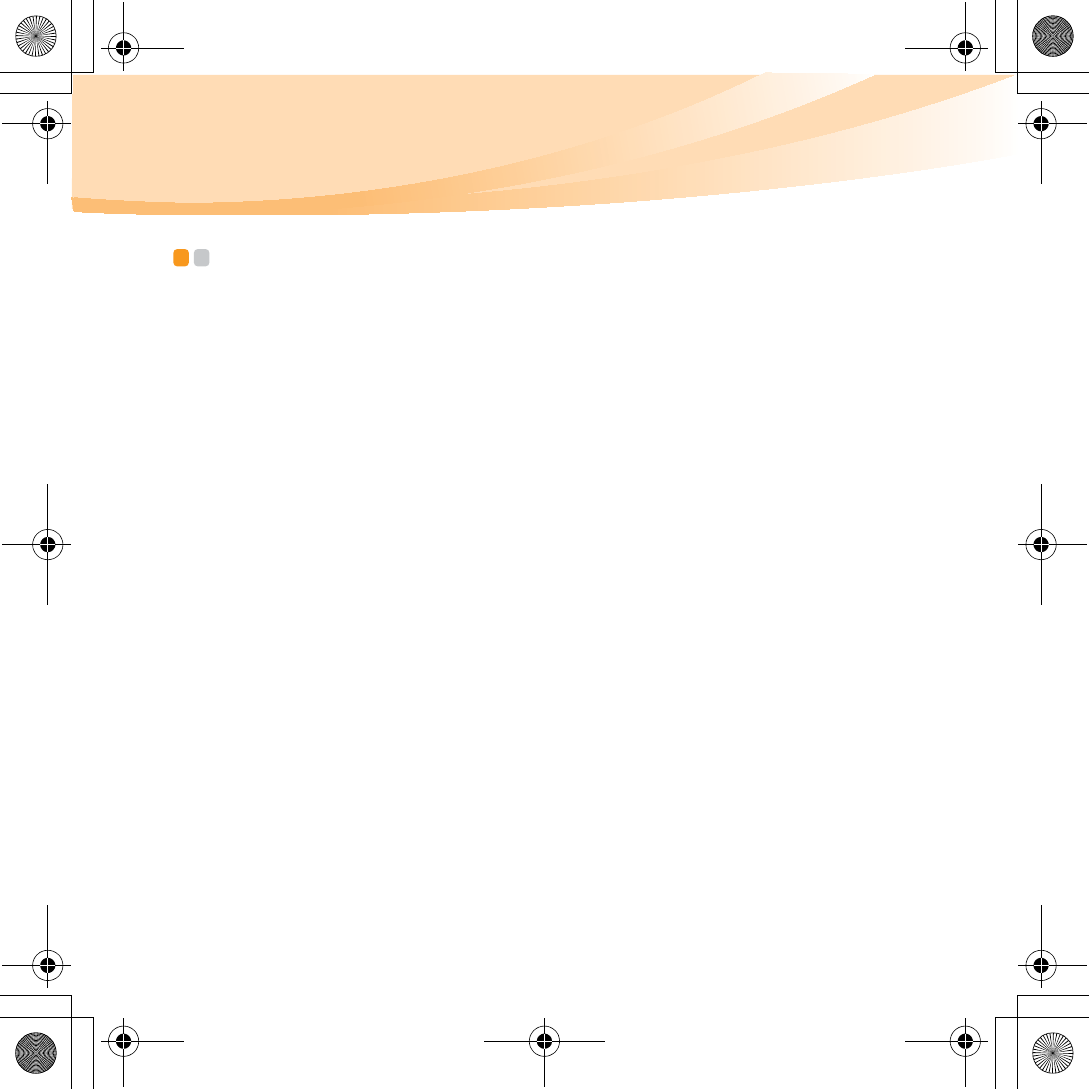
34
Chapter 4. OneKey Rescue system
OneKey Rescue system - - - - - - - - - - - - - - - - - - - - - - - - - - - - - - - - - - - - - - - - - - - - - - - - - - - - - - - - - - - -
Introduction
The Lenovo OneKey Rescue system is an easy-to-use application that can
be used to back up the data on your system partition (C drive) for easy
restore when required. You can run Lenovo OneKey Recovery under the
Windows operating system, and the OneKey Rescue system without
starting the Windows operating system.
Attention:
In order to utilize the features of the OneKey Rescue system, your hard
disk already includes a hidden partition by default to store the system
image file and OneKey Rescue system program files. This default partition
is hidden for security reasons and is the reason the available disk space is
less than it claims. The exact available hard disk space depends on the file
size of the mirror image file (based on the size of operating system and
pre-installed software).
S10-3 UserGuide V1.0_en.book Page 34 Tuesday, November 10, 2009 11:04 AM
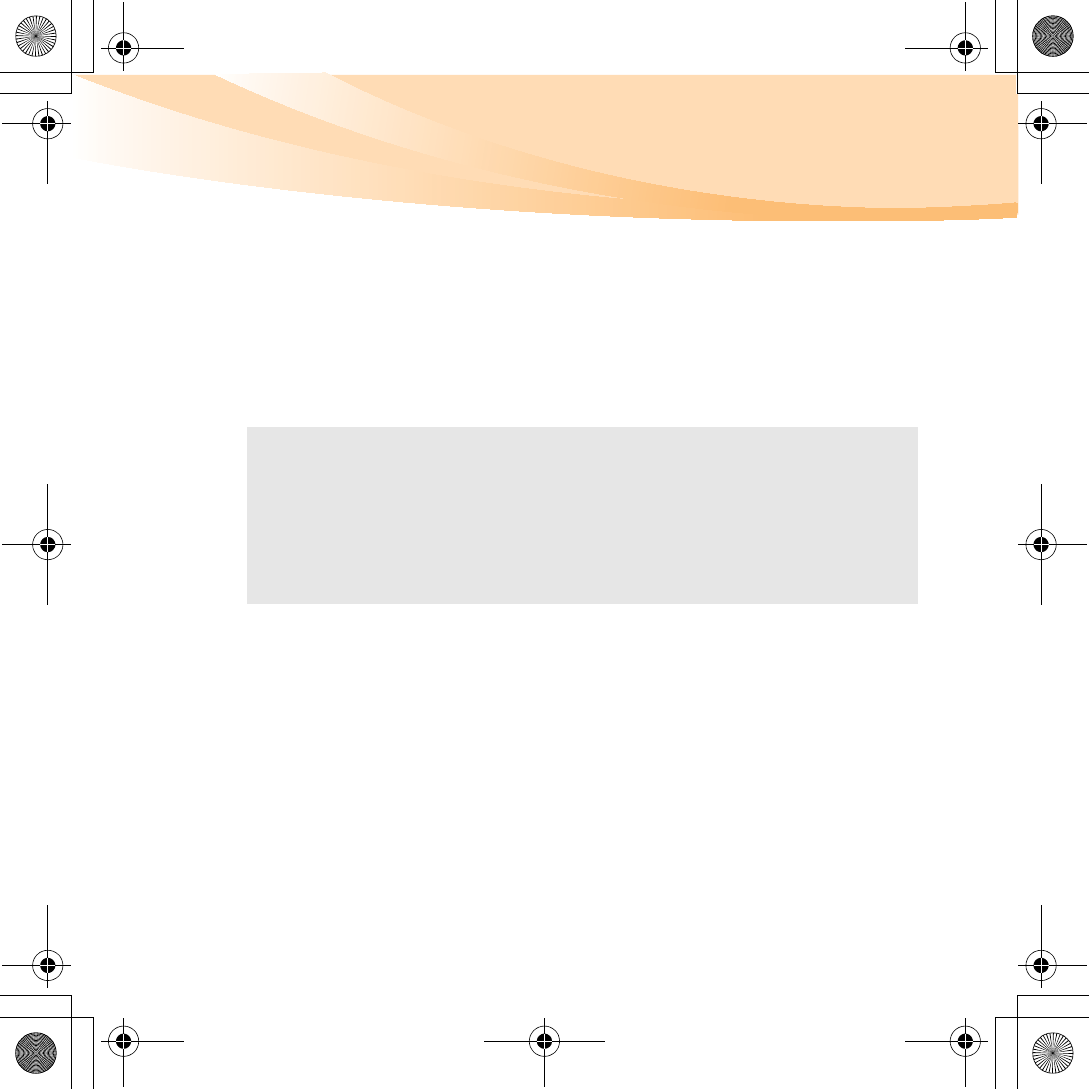
Chapter 4. OneKey Rescue system
35
Using Lenovo OneKey Recovery (Within Windows operating
system)
In Windows operating system, double click the OneKey Recovery system
Icon on the desktop to launch Lenovo OneKey Recovery.
Within the program, you can back up the system partition on the hard disk
drive, other storage devices, or by creating recovery discs.
For more instructions, see the help file of Lenovo OneKey
Recovery.
Notes:
•The backup process and creation of recovery discs may take some time, connect
the AC adapter and battery pack to your computer.
•After the recovery discs are burned, please number them so that you can use
them in the correct order.
•Computers without an integrated optical drive support the creation of recovery
discs; however an appropriate external optical drive is needed to physically
create the recovery discs.
S10-3 UserGuide V1.0_en.book Page 35 Tuesday, November 10, 2009 11:04 AM
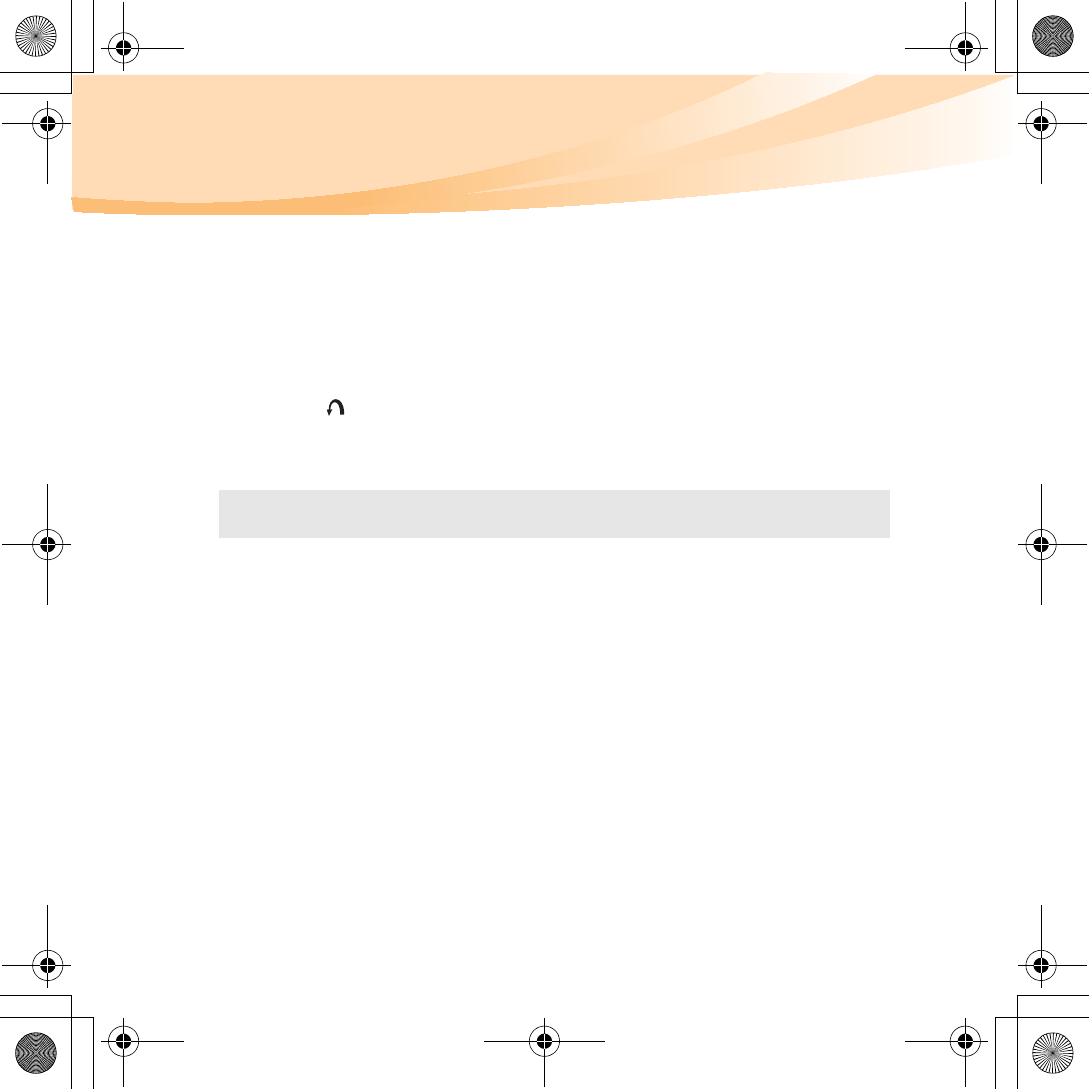
36
Chapter 4. OneKey Rescue system
Using Lenovo OneKey Rescue system (Without Windows
operating system)
In the event that the operating system cannot be loaded, follow the steps
below to access OneKey Rescue system.
• Shut down your computer.
• Press the key to launch OneKey Rescue system.
Within the program, you can choose to restore your system partition to the
original factory status, or to a previously generated backup.
Note: The recovery process is irreversible. Make sure to back up any critical data
before using the recovery feature.
S10-3 UserGuide V1.0_en.book Page 36 Tuesday, November 10, 2009 11:04 AM
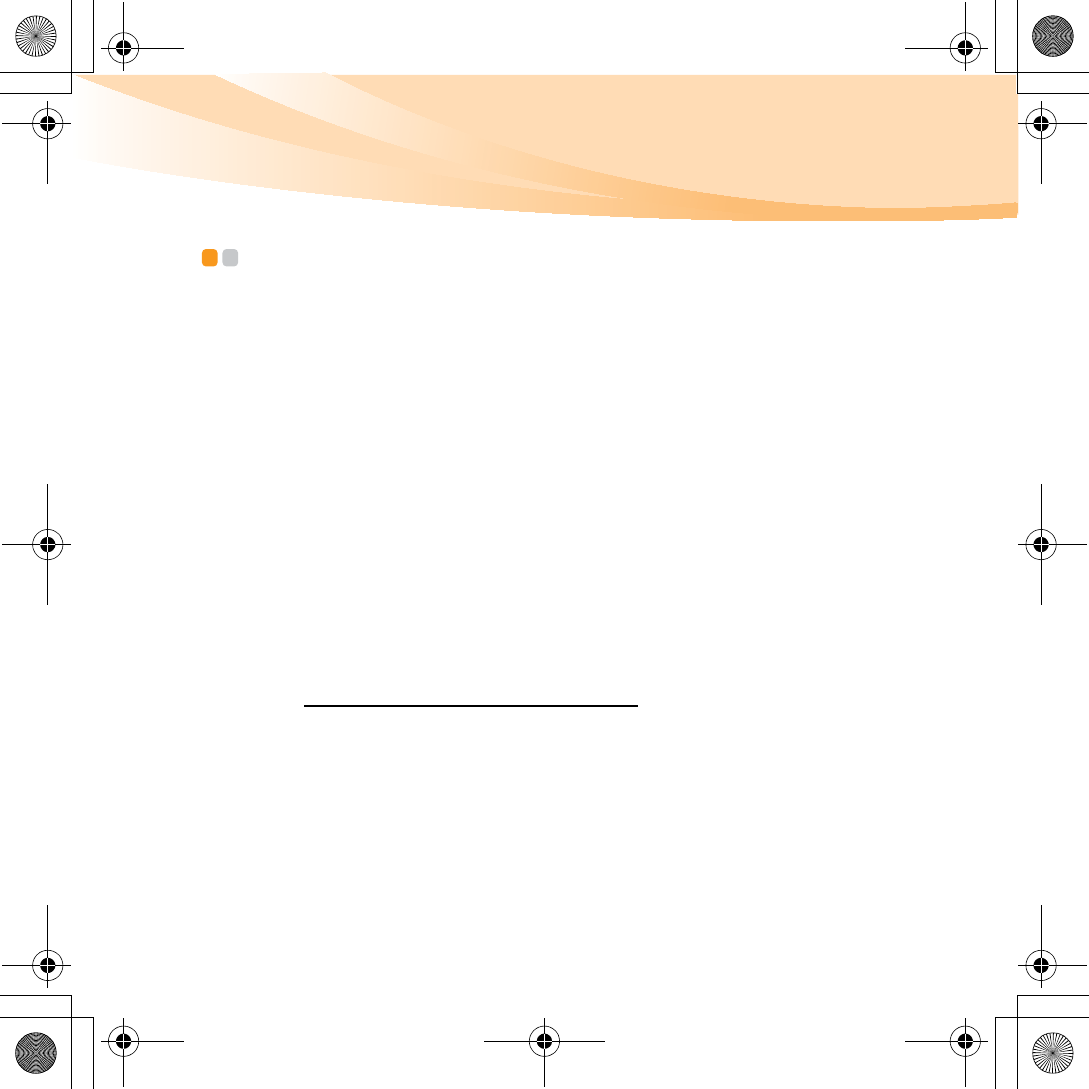
37
Chapter 5. Troubleshooting
Frequently asked questions - - - - - - - - - - - - - - - - - - - - - - - - - - - - - - - - - - - - - - - - - - -
This section lists frequently asked questions and tell where you can find detailed
answers. For details about each publication included in the package with your
computer, see Lenovo IdeaPad S10-3 Setup Poster.
What safety precautions should I follow when using my computer?
See “Important safety information” on page iii of this guide.
How can I prevent problems with my computer?
See “Appendix B. Use, and care Information” on page 63 of this guide.
More tips can be found in Chapter 1 and 2.
What are the main hardware features of my new computer?
More information can be found in Chapter 1 and 2.
Where can I find the detailed specifications for my computer?
See http://consumersupport.lenovo.com.
I need to upgrade a device or I need to replace one of the following: the hard
disk drive, memory, or the keyboard.
See “Appendix D. Customer replaceable units (CRUs)” on page 90 of this
guide.
S10-3 UserGuide V1.0_en.book Page 37 Tuesday, November 10, 2009 11:04 AM
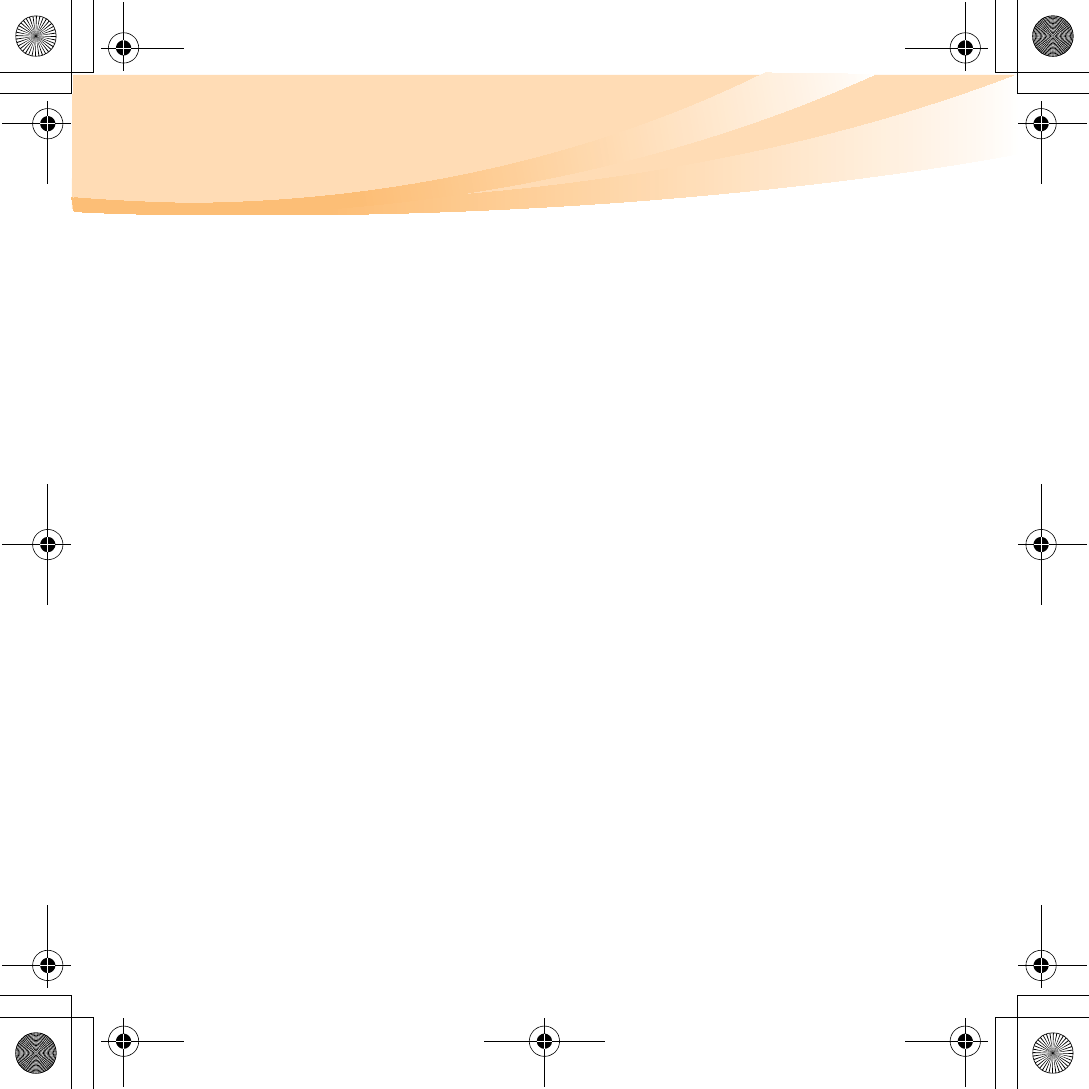
38
Chapter 5. Troubleshooting
Where are the recovery discs?
Your computer did not come with a recovery disc. For an explanation of
the alternative recovery methods offered by Lenovo, see “Chapter 4.
OneKey Rescue system” on page 34.
How can I contact the customer support center?
See “Appendix A. Getting help and service” on page 58 of this guide.
Where can I find warranty information?
For the warranty applicable to your computer, including the warranty
period and type of warranty service, see “Appendix C. Lenovo limited
warranty” on page 76.
How can I install the device drivers?
A compatible device driver is a requirement to ensure correct operation
and performance of each component in your computer. If your computer
is pre-installed with an operating system, Lenovo provides all the driver
you need in your hard disk.
What can I do if the backup process fails?
If you can start the backup feature without a problem, but it fails during
the backup process, please try the following steps:
1
Close other applications, then restart the backup process.
2
Check if the destination media is damaged, try to select another path
and then try again.
S10-3 UserGuide V1.0_en.book Page 38 Tuesday, November 10, 2009 11:04 AM
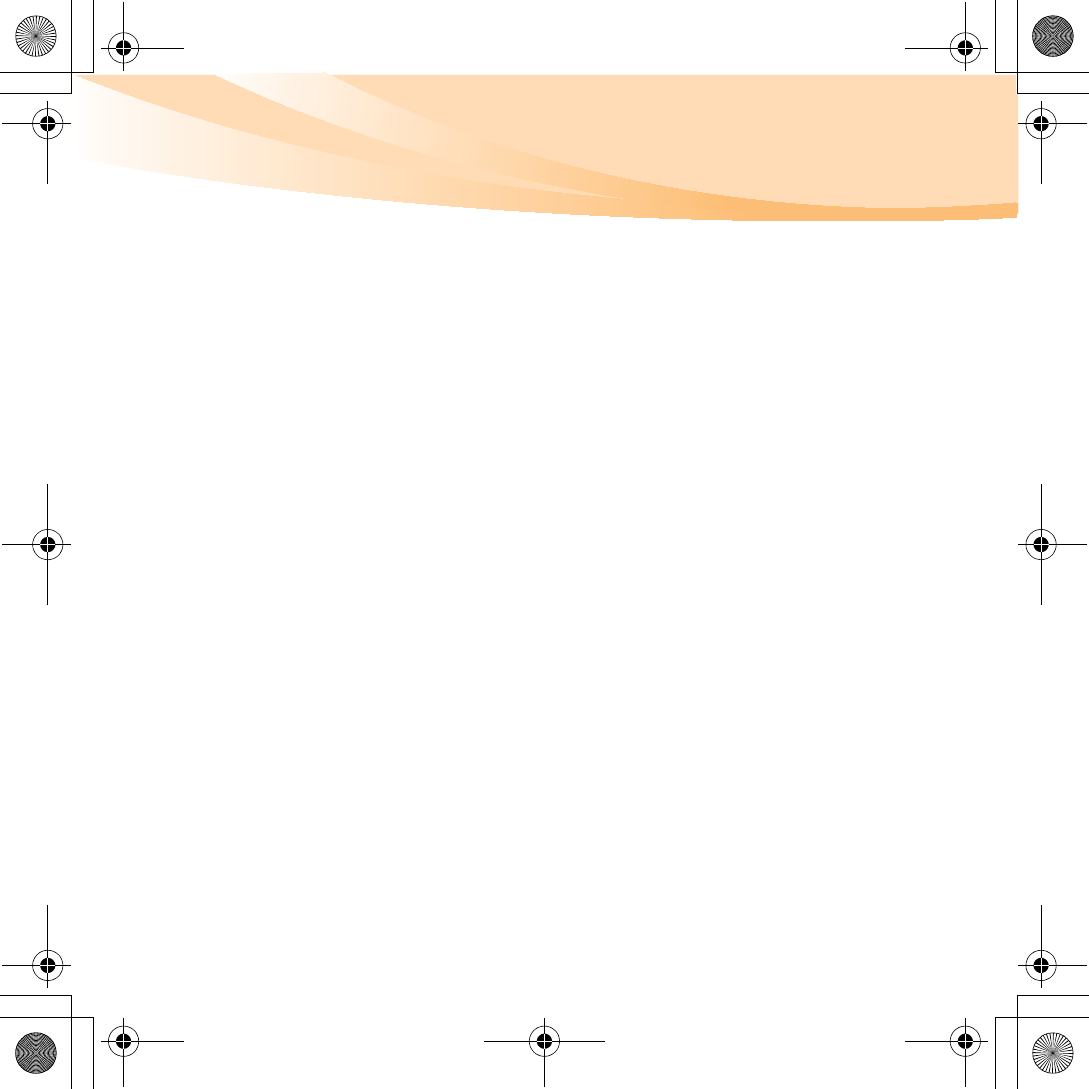
Chapter 5. Troubleshooting
39
When do I need to restore the system to the factory status?
You can use this feature when your system fails or you need to re-install
your operating system. This will restore your computer back to the initial
status when you first booted up your computer after receiving it from
the store. If there is critical data on your current partition, back it up
before you run this recovery feature.
S10-3 UserGuide V1.0_en.book Page 39 Tuesday, November 10, 2009 11:04 AM
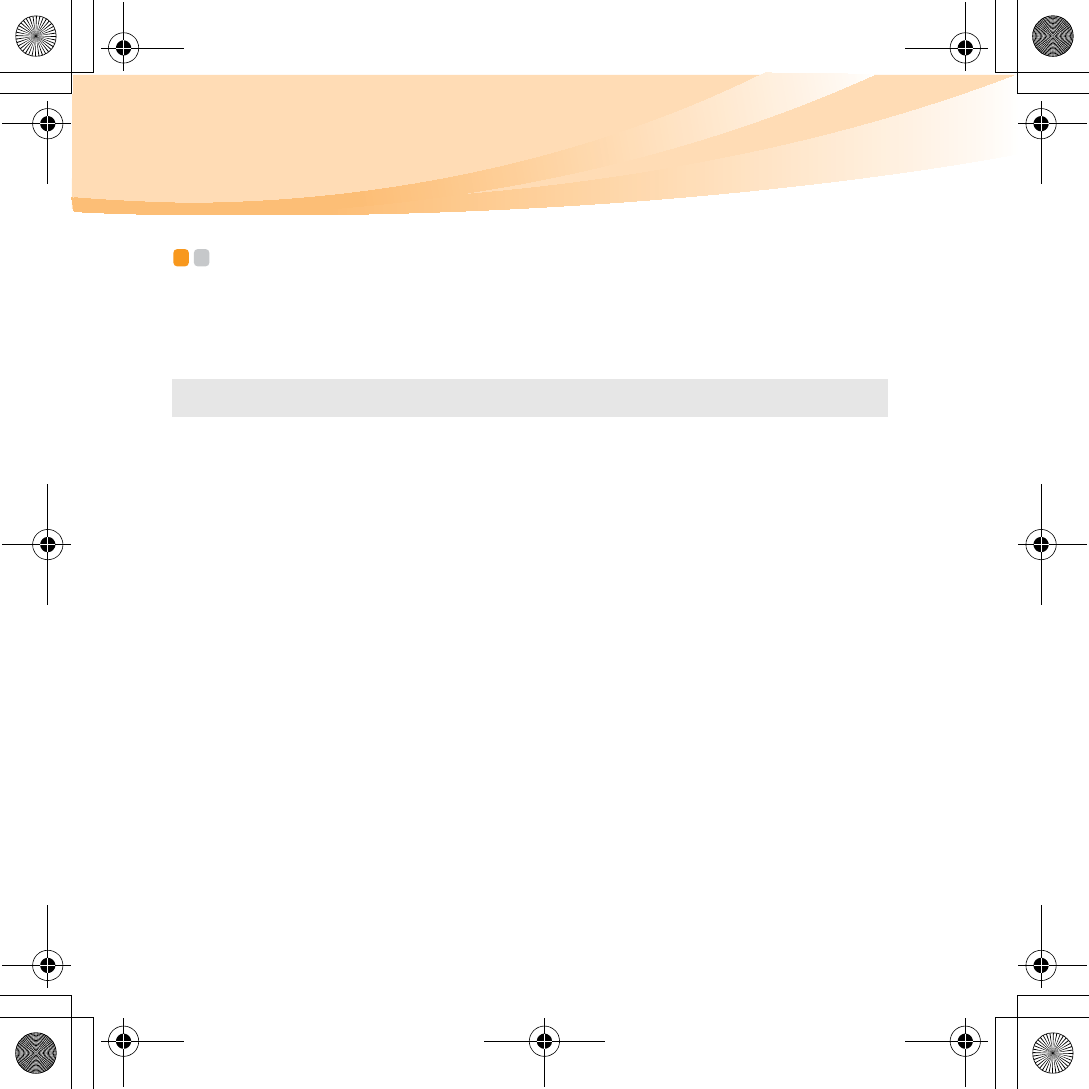
40
Chapter 5. Troubleshooting
Troubleshooting - - - - - - - - - - - - - - - - - - - - - - - - - - - - - - - - - - - - - - - - - - - - - - - - - - - - - - - - - - - - - - - - - - - - - - - - - - - -
If you do not find your problem here, see Chapter 2. The following section only
describes problems that might negate the need to refer to the more
comprehensive information in Chapter 2.
Display problems
When I turn on the compu-
ter, nothing appears on the
screen.
•If the screen is blank, make sure that:
- The battery is installed correctly.
- The AC adapter is connected to the computer and
the power cord is plugged into a working electrical
outlet.
- The computer power is on. (Press the power
button again for confirmation.)
- The memory is installed correctly.
•If these items are properly set, and the screen
remains blank, have the computer serviced.
When I turn on the
computer, only a white
cursor appears on a blank
screen.
•Restore backed-up files to your Windows
environment or the entire contents of your hard disk
to the original factory contents using OneKey
Recovery. If you still see only the cursor on the
screen, have the computer serviced.
S10-3 UserGuide V1.0_en.book Page 40 Tuesday, November 10, 2009 11:04 AM
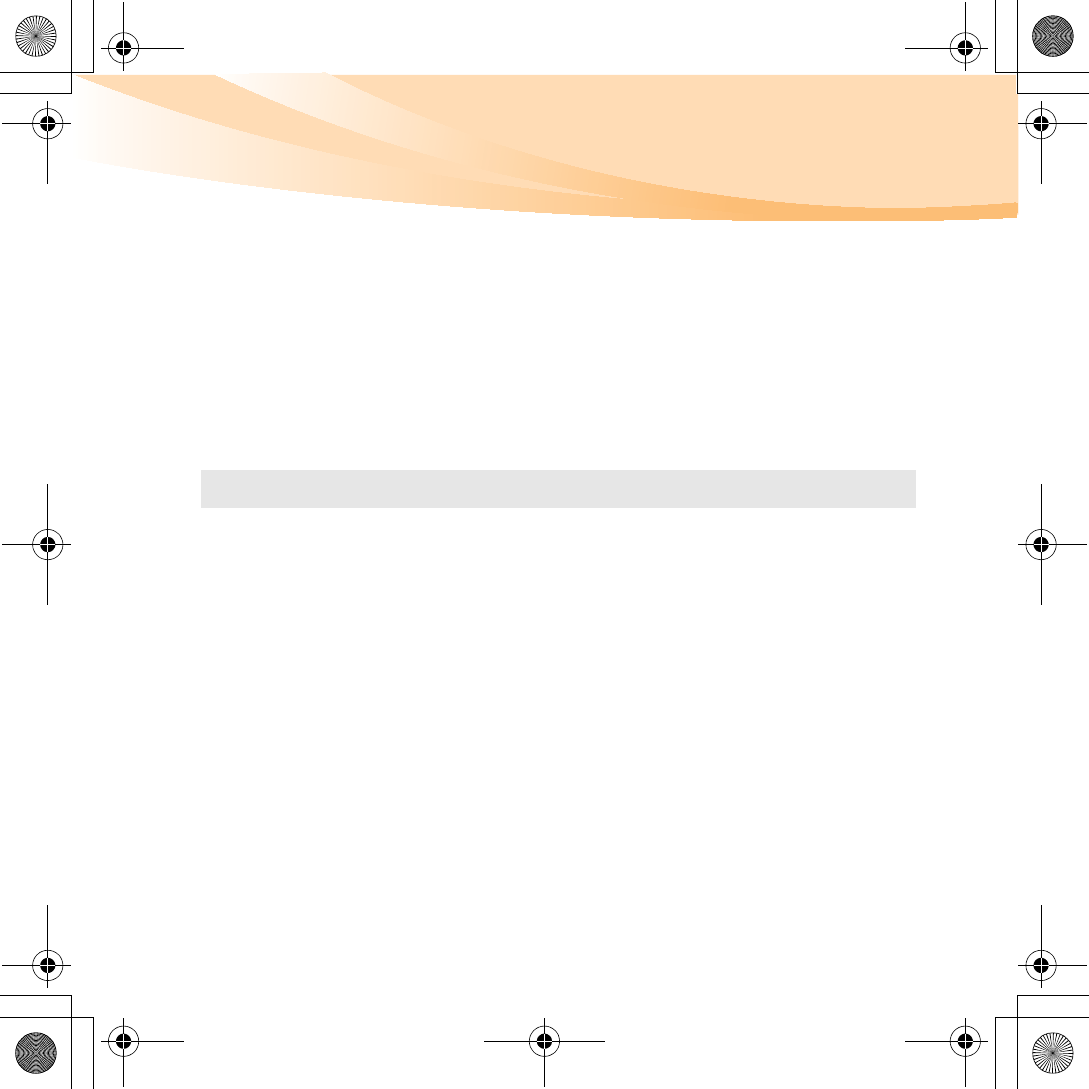
Chapter 5. Troubleshooting
41
My screen goes blank while
the computer is on.
•Your screen saver or power management may be
enabled. Do one of the following to exit from the
screen saver or to resume from sleep or hibernation
mode:
- Touch the touchpad.
- Press any key on the keyboard.
- Press the power button.
-Press Fn+F2 to confirm whether the LCD screen
has been turned off.
A Password problem
I forgot my password. •If you forget your user password, you must take
your computer to a Lenovo authorized servicer or a
marketing representative to have the password
changed.
•If you forget your HDD password, a Lenovo
authorized servicer cannot reset your password or
recover data from the hard disk. You must take your
computer to a Lenovo authorized servicer or a
marketing representative to have the hard disk drive
replaced. Proof of purchase is required, and a fee will
be charged for parts and service.
•If you forget your supervisor password, a Lenovo
authorized servicer cannot reset your password. You
must take your computer to a Lenovo authorized
servicer or a marketing representative to have the
system board replaced. Proof of purchase is
required, and a fee will be charged for parts and
service.
S10-3 UserGuide V1.0_en.book Page 41 Tuesday, November 10, 2009 11:04 AM
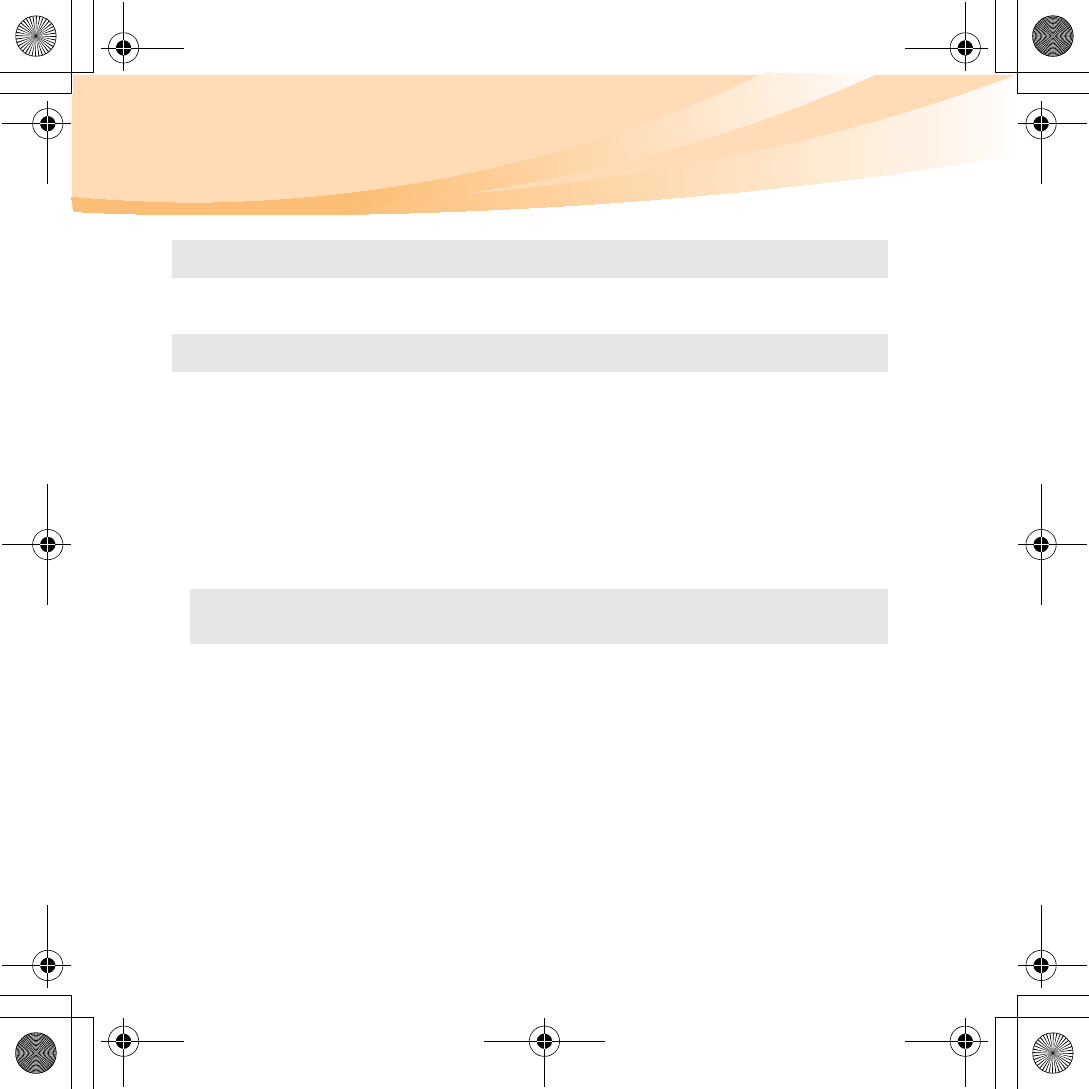
42
Chapter 5. Troubleshooting
Keyboard problems
A number appears when
you enter a letter.
•The numeric lock function is on. To disable it, press
Fn + Insert.
Sleep or hibernation problems
The computer enters sleep
mode unexpectedly.
•
If the processor overheats, the computer automatically
enters sleep mode to allow the computer to cool and to
protect the processor and other internal components.
Check the settings for sleep mode.
The computer enters sleep
mode immediately after
Power-on self-test (POST).
•Make sure that:
- The battery is charged.
- The operating temperature is within the acceptable
range. See “Appendix B. Use, and care
Information” on page 63.
Note: If the battery is charged and the temperature is within range, have the computer
serviced.
The critical low-battery error
message appears, and the
computer immediately turns
off.
•The battery power is getting low. Connect the AC
adapter to the computer, or replace the battery with
a fully charged one.
S10-3 UserGuide V1.0_en.book Page 42 Tuesday, November 10, 2009 11:04 AM
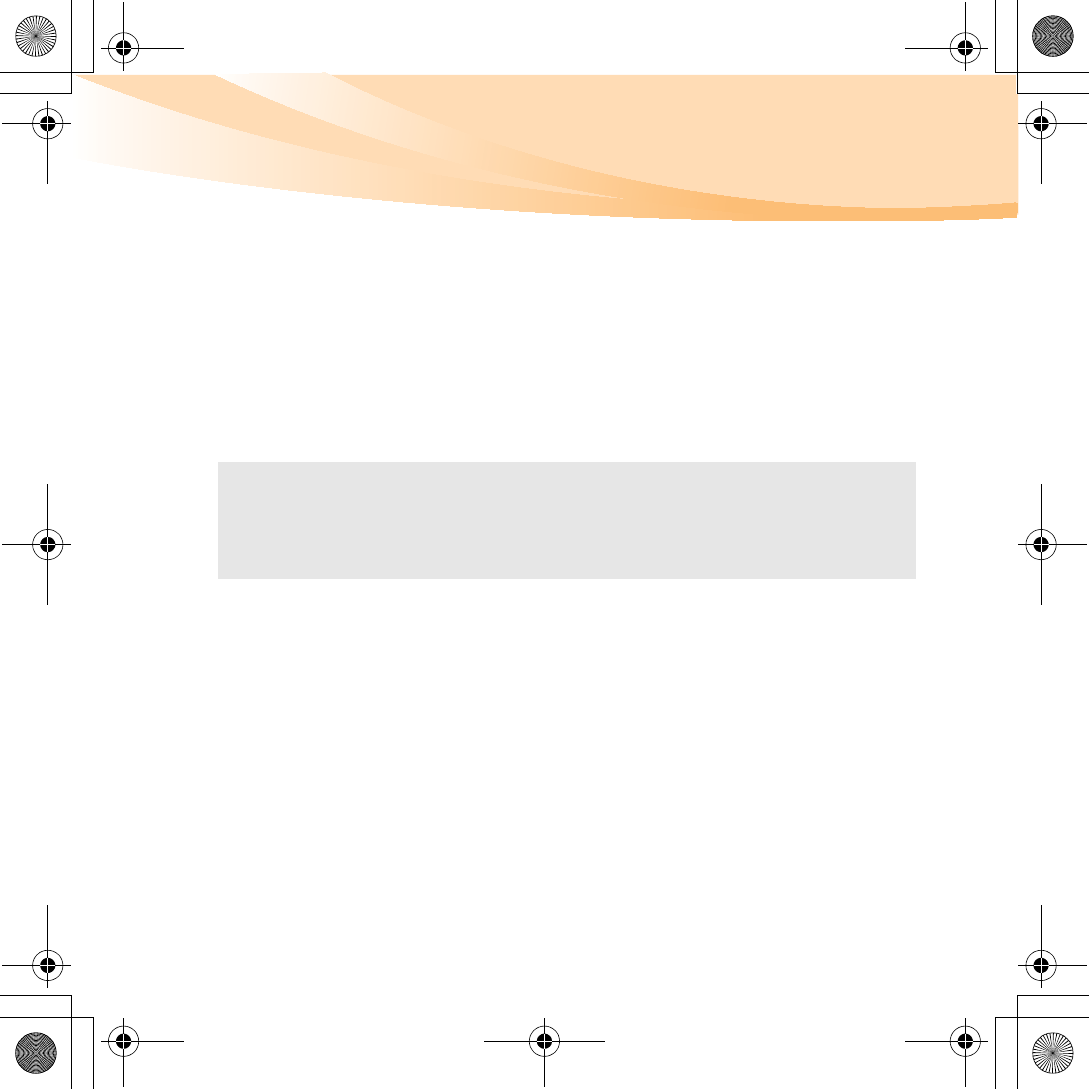
Chapter 5. Troubleshooting
43
The computer does not
return from sleep mode and
does not work.
•If the computer does not return from sleep mode, it
may have entered hibernation mode automatically
because the battery is depleted. Check the power
indicator.
•If your computer is in sleep mode connect the AC
adapter to the computer, then press any key or the
power button.
•If your computer is in hibernation mode or power-off
state. Connect the AC adapter to the computer, then
press the power button to resume operation.
Note:
If the system still does not return from sleep mode, your system has stopped
responding, and you cannot turn off the computer, reset the computer. However,
unsaved data may be lost. To reset the computer, press and hold the power button
for 4 seconds or more. If the computer is still not reset, remove the AC adapter and
the battery.
S10-3 UserGuide V1.0_en.book Page 43 Tuesday, November 10, 2009 11:04 AM
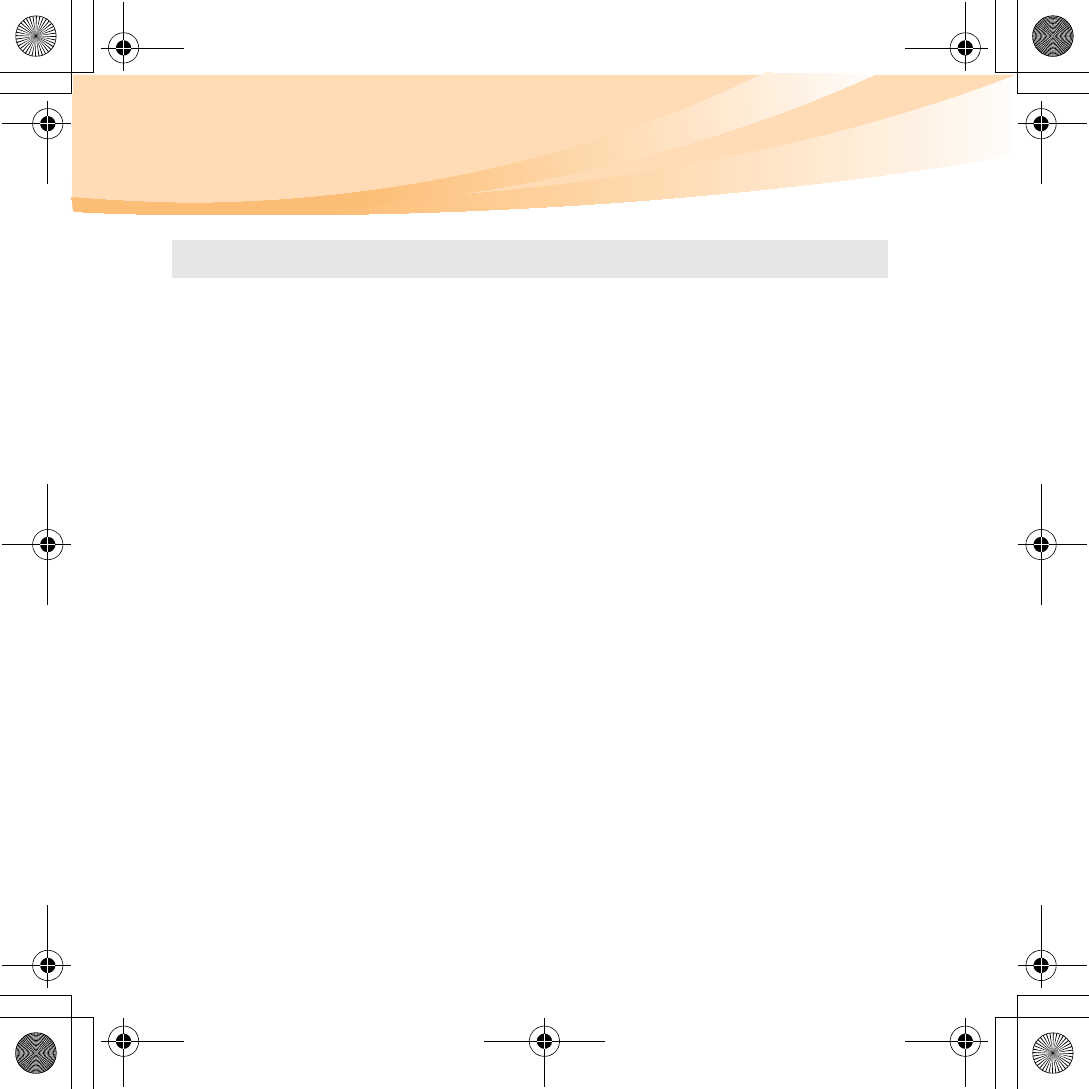
44
Chapter 5. Troubleshooting
Computer screen problems
The screen is blank. •Do the following:
- If you are using the AC adapter, or using the
battery, and the battery status indicator is on, press
Fn +↑to make the screen brighter.
- If the Power indicator is blinking, press the power
button to resume from the sleep mode.
- If the problem persists, follow the solution in the
following problem “The screen is unreadable or
distorted.”
The screen is unreadable or
distorted.
•Make sure that:
- The display device driver is installed correctly.
- The screen resolution and color quality are
correctly set.
- The monitor type is correct.
Incorrect characters appear
on the screen.
•Did you install the operating system or application
program correctly? If they are installed and
configured correctly, have the computer serviced.
S10-3 UserGuide V1.0_en.book Page 44 Tuesday, November 10, 2009 11:04 AM
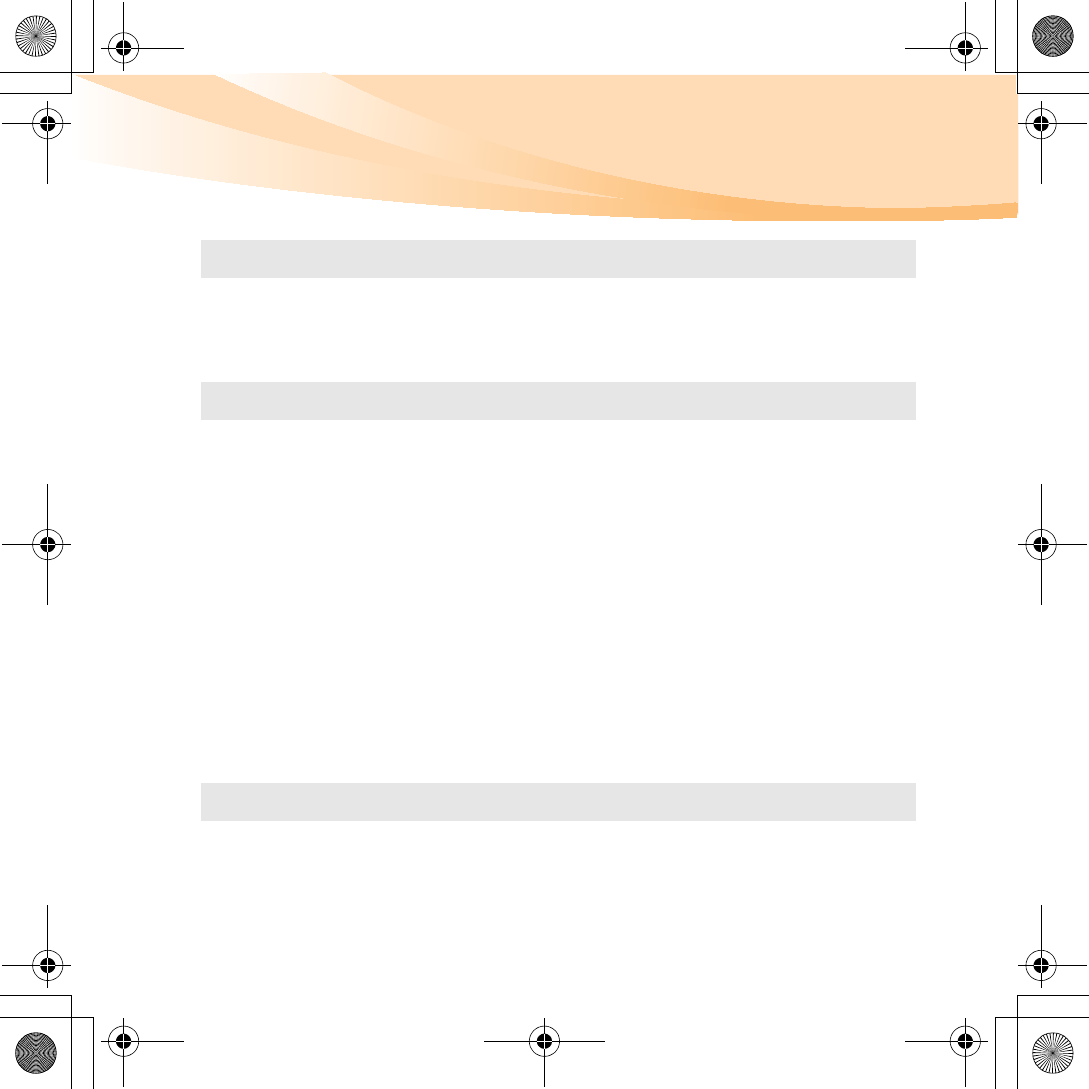
Chapter 5. Troubleshooting
45
Sound problems
No sound can be heard
from the speaker even
when the volume is turned
up.
•Make sure that:
- The Mute function is off.
- The headphone jack is not used.
- Speakers are selected as the playback device.
Battery problems
Your computer shuts down
before the battery status
indicator shows empty.
-or-
Your computer operates
after the battery status
indicator shows empty.
•Discharge and recharge the battery.
The operating time for a
fully charged battery is
short.
•For details, see “Handling the battery” in Chapter 2.
The computer does not
operate with a fully charged
battery.
•The surge protector in the battery might be active.
Turn off the computer for one minute to reset the
protector, then turn on the computer again.
The battery does not
charge.
•For details, see “Handling the battery” in Chapter 2.
A hard disk drive problem
The hard disk drive does
not work.
•In the Boot menu in BIOS Setup Utility, make sure
that the hard disk drive is included in the Boot order
correctly.
S10-3 UserGuide V1.0_en.book Page 45 Tuesday, November 10, 2009 11:04 AM
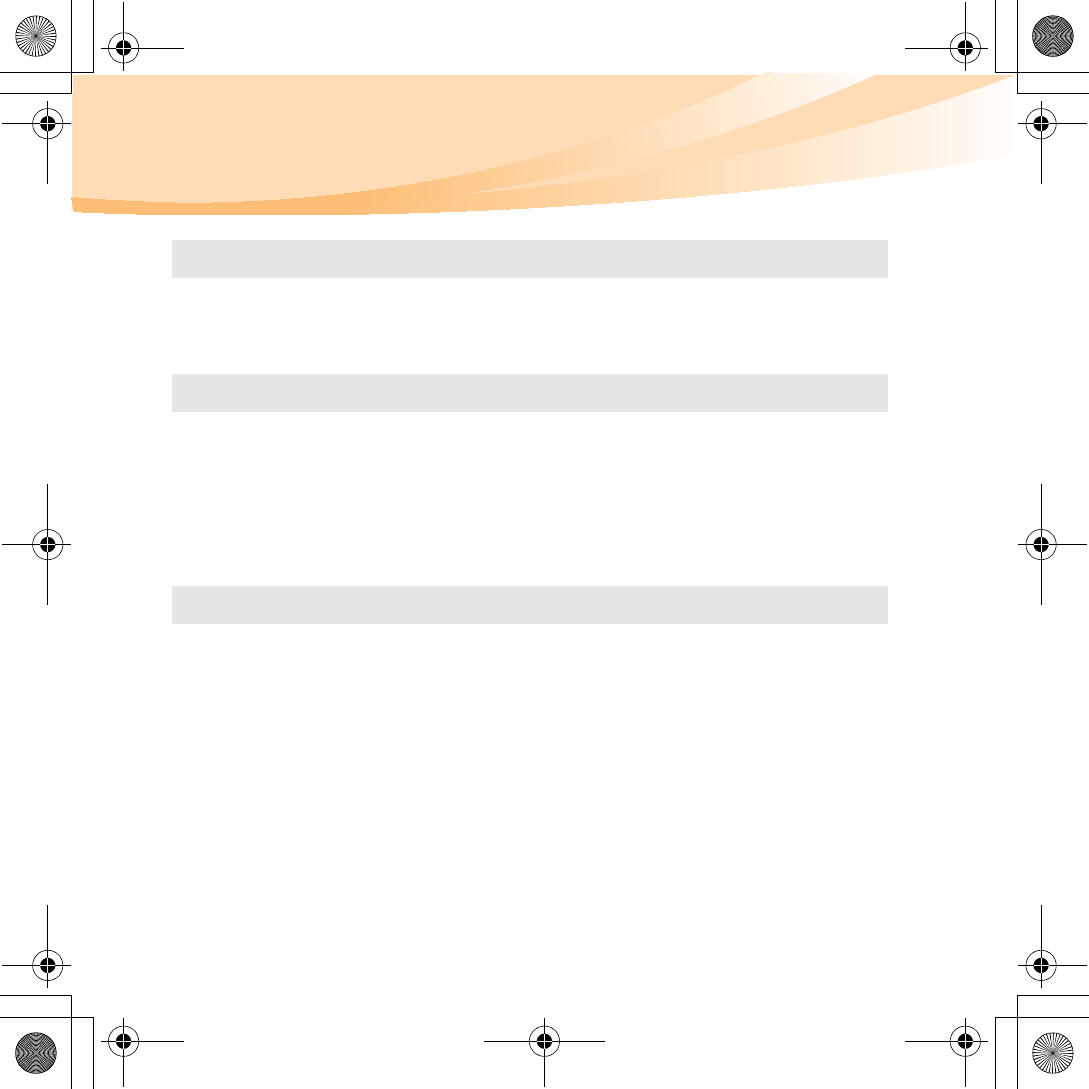
46
Chapter 5. Troubleshooting
A startup problem
The Microsoft® Windows
operating system does not
start.
•Use the OneKey Rescue system to help solve or
identify your problem. For details on the OneKey
Rescue system, see “Chapter 4. OneKey Rescue
system” on page 34.
OneKey Rescue system problems
Backup cannot be made. •You are not currently using a Windows operating
system.
•There is not enough space to store the backed up
data. You will need to free more hard disk space on
your system partition (C drive).
Fail to restore system
partition to factory default.
•The system partition, such as the partition size or the
drive capacity of C, has been modified.
Other problems
The computer does not
respond.
•
To turn off your computer, press and hold the power
button for 4 seconds or more. If the computer still does
not respond, remove the AC adapter and the battery.
•Your computer might lock when it enters sleep mode
during a communication operation. Disable the
sleep timer when you are working on the network.
S10-3 UserGuide V1.0_en.book Page 46 Tuesday, November 10, 2009 11:04 AM
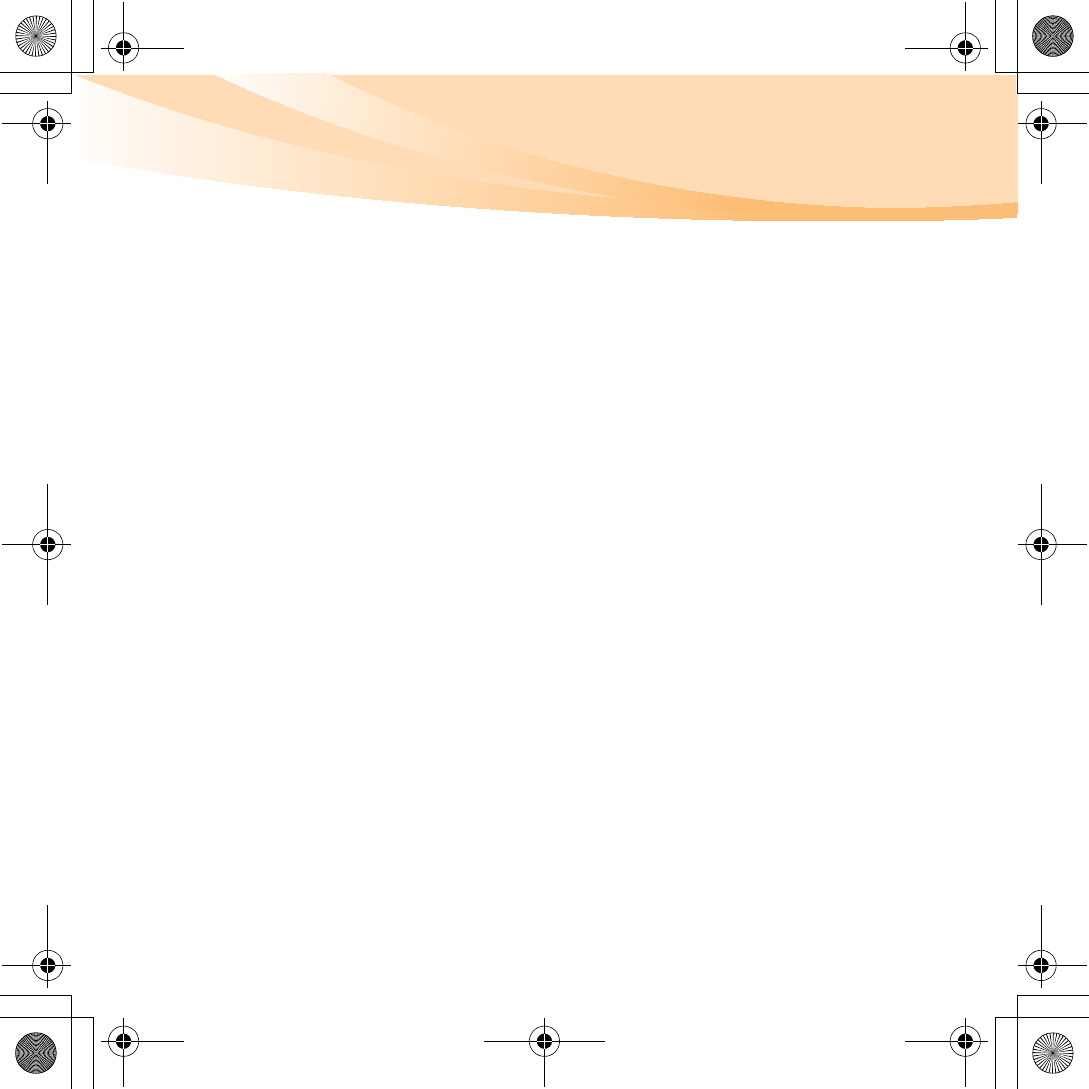
Chapter 5. Troubleshooting
47
The computer does not
start from the desired
device.
•
See the
Boot
menu of
BIOS Setup Utility
. Make sure
that
Boot order
in
BIOS Setup Utility
is set so that
the computer starts from the device you want.
•Also make sure that the device from which the
computer starts is enabled. In the Boot menu in
BIOS Setup Utility, make sure that the device is
included in the Boot order list.
The connected external
device does not work.
•Do not connect or disconnect any external device
cables other than USB while the computer power is
on; otherwise, you might damage your computer.
•When using a high power consumption external
devices such as an external USB optical disk drive,
use external device power adapter. Otherwise, the
device may not be recognized, or system shut down
may result.
S10-3 UserGuide V1.0_en.book Page 47 Tuesday, November 10, 2009 11:04 AM
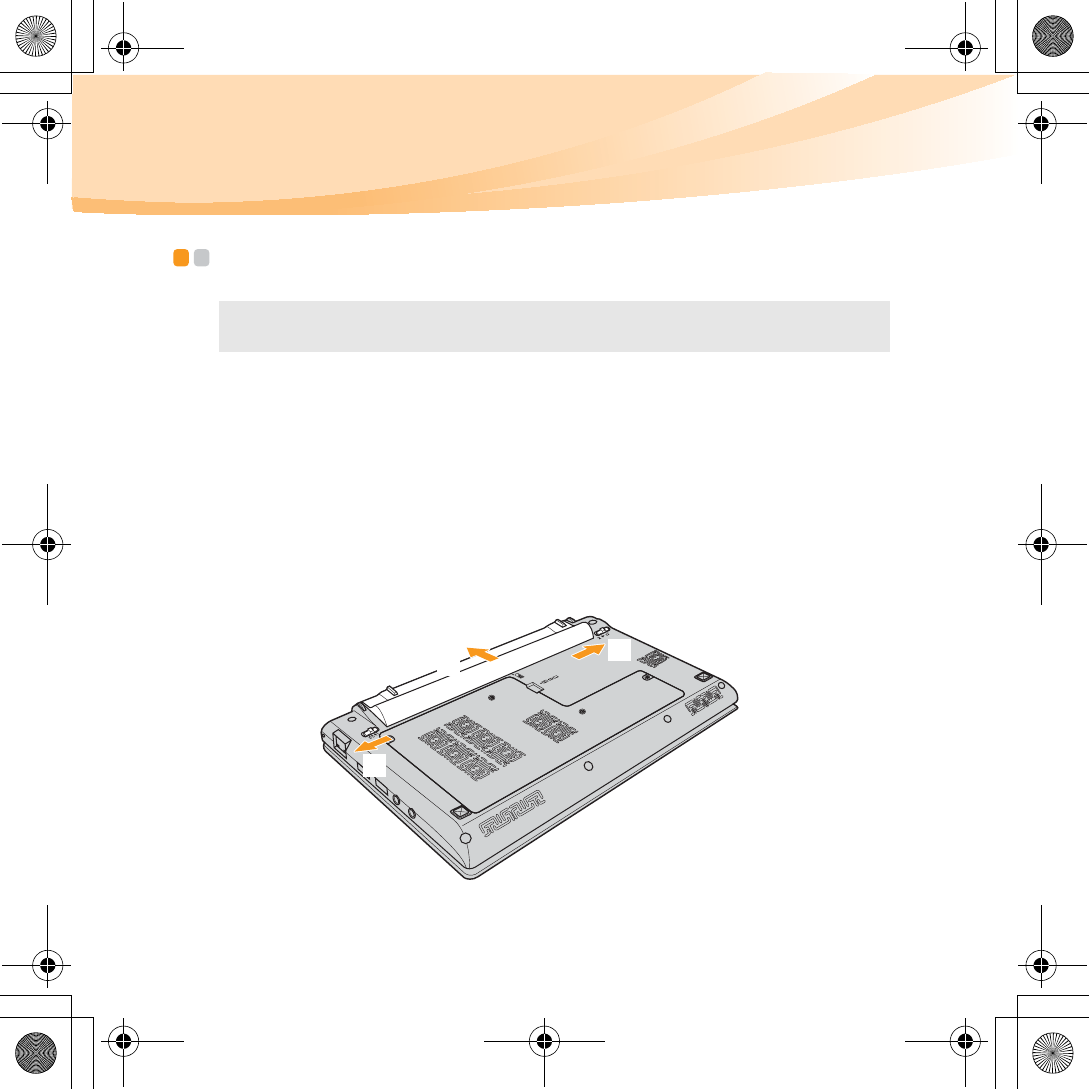
48
Chapter 6. Upgrading and replacing devices
Replacing the battery - - - - - - - - - - - - - - - - - - - - - - - - - - - - - - - - - - - - - - - - - - - - - - - - - - - - - - - - - - -
To replace the battery
1
Turn off the computer, or enter hibernation mode. Disconnect the AC
adapter and all cables from the computer.
2
Close the computer display, and turn the computer over.
3
Unlock the manual battery latch . Hold the spring-loaded battery
latch in the unlocked position , remove the battery pack in the
direction shown by the arrow .
Note: Use only the battery provided by Lenovo. Any other battery could ignite or
explode.
b
c
a
S10-3 UserGuide V1.0_en.book Page 48 Tuesday, November 10, 2009 11:04 AM
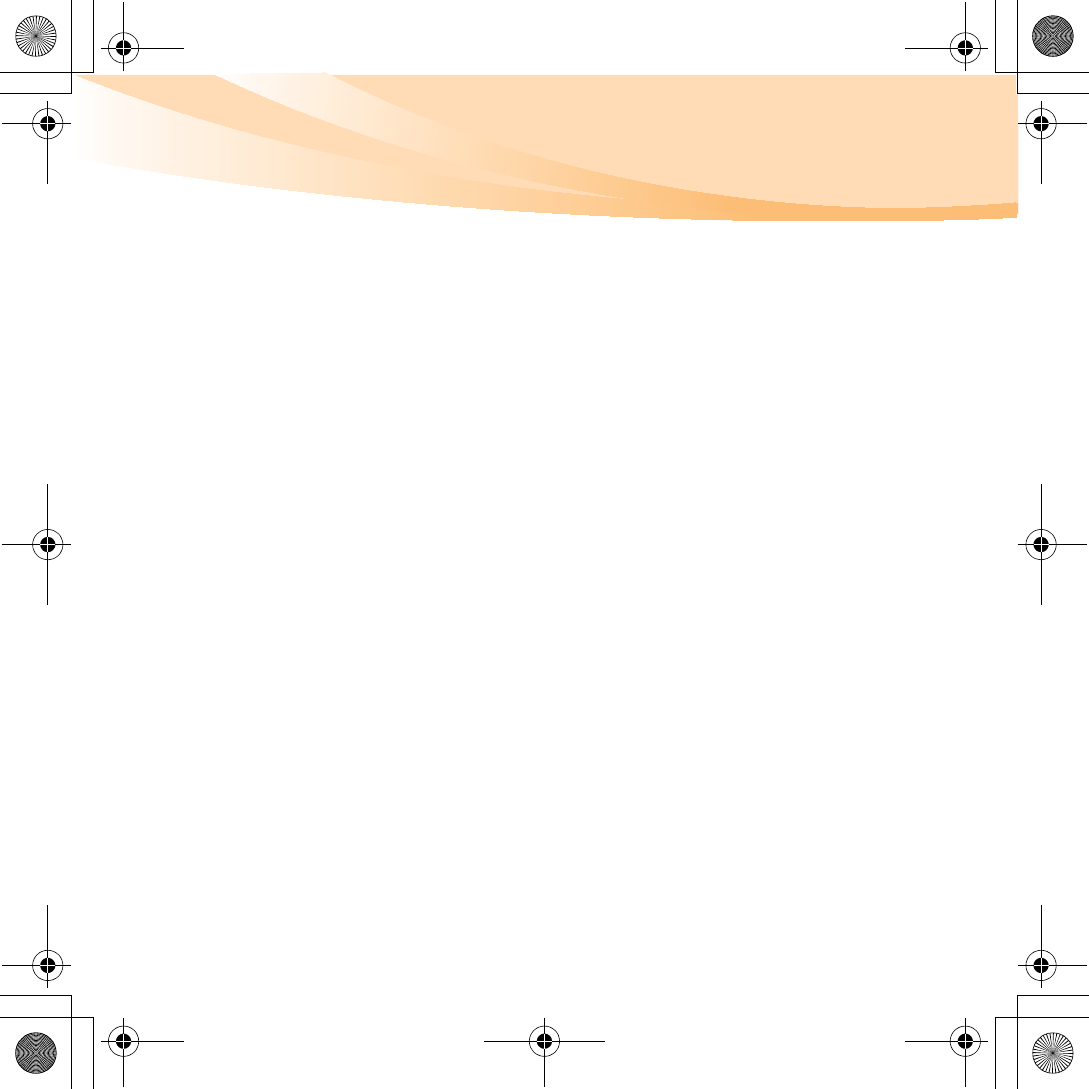
Chapter 6. Upgrading and replacing devices
49
4
Install a fully charged battery.
5
Slide the manual battery latch to the locked position.
6
Turn the computer over again. Connect the AC adapter and the cables
to the computer again.
S10-3 UserGuide V1.0_en.book Page 49 Tuesday, November 10, 2009 11:04 AM
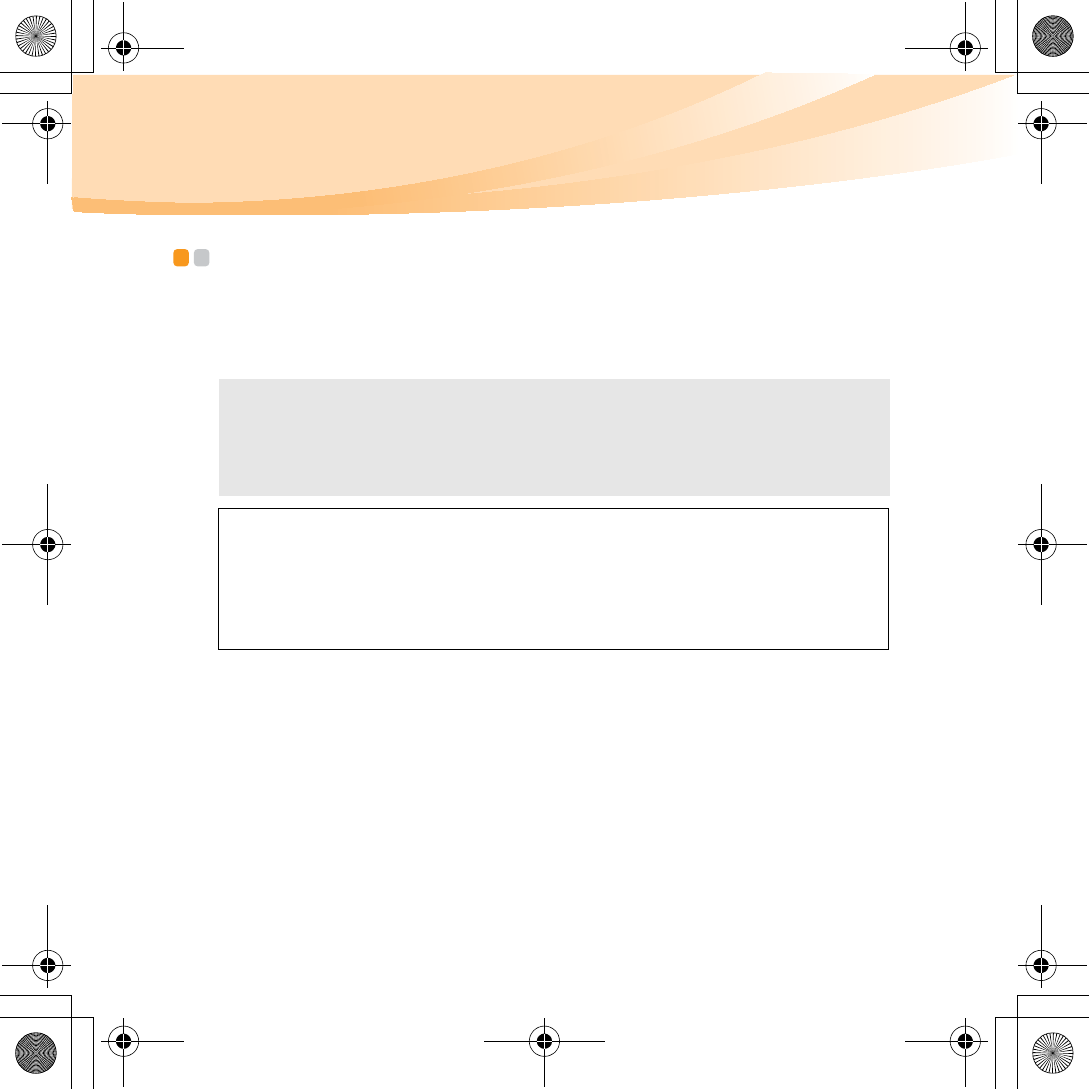
50
Chapter 6. Upgrading and replacing devices
Replacing the hard disk drive - - - - - - - - - - - - - - - - - - - - - - - - - - - - - - - - - - - - - - -
You can increase the storage capacity of your computer by replacing the
hard disk drive with one of greater capacity. You can purchase a new hard
disk drive from your reseller or Lenovo marketing representative.
The drive is very sensitive. Incorrect handling can cause damage and
permanent loss of data on the hard disk. Before removing the hard disk
drive, make a backup copy of all the information on the hard disk, and then
turn the computer off. Never remove the drive while the system is
operating, in sleep mode, or in hibernation mode.
Notes:
•Replace the hard disk drive only if you upgrade it or have it repaired. The
connectors and bay of the hard disk drive were not designed for frequent
changes, or drive swapping.
•The preinstalled softwares are not included on an optional hard disk drive.
Handling a hard disk drive
•Do not drop the drive or subject it to physical shocks. Put the drive on a
material, such as soft cloth, that absorbs the physical shock.
•Do not apply pressure to the cover of the drive.
•Do not touch the connector.
S10-3 UserGuide V1.0_en.book Page 50 Tuesday, November 10, 2009 11:04 AM
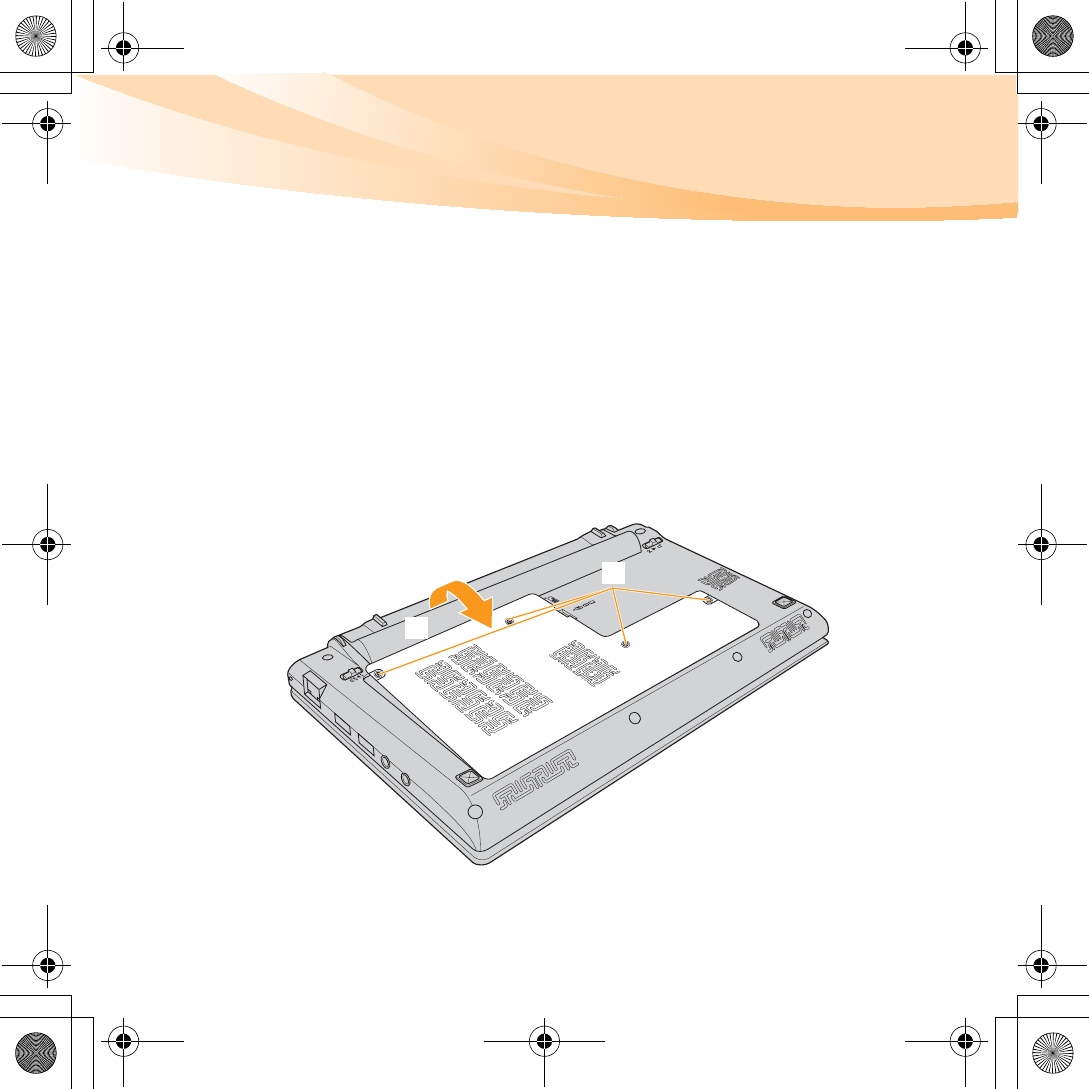
Chapter 6. Upgrading and replacing devices
51
To replace the hard disk drive, do the following:
1
Turn off the computer; then disconnect the AC adapter and all cables
from the computer.
2
Close the computer display, and then turn the computer over.
3
Remove the battery pack.
4
Remove the Hard disk/Memory/Mini PCI ExpressCard slot
compartment cover.
a. Loosen the screws that secure the compartment cover .
b. Remove the compartment cover .
b
a
S10-3 UserGuide V1.0_en.book Page 51 Tuesday, November 10, 2009 11:04 AM
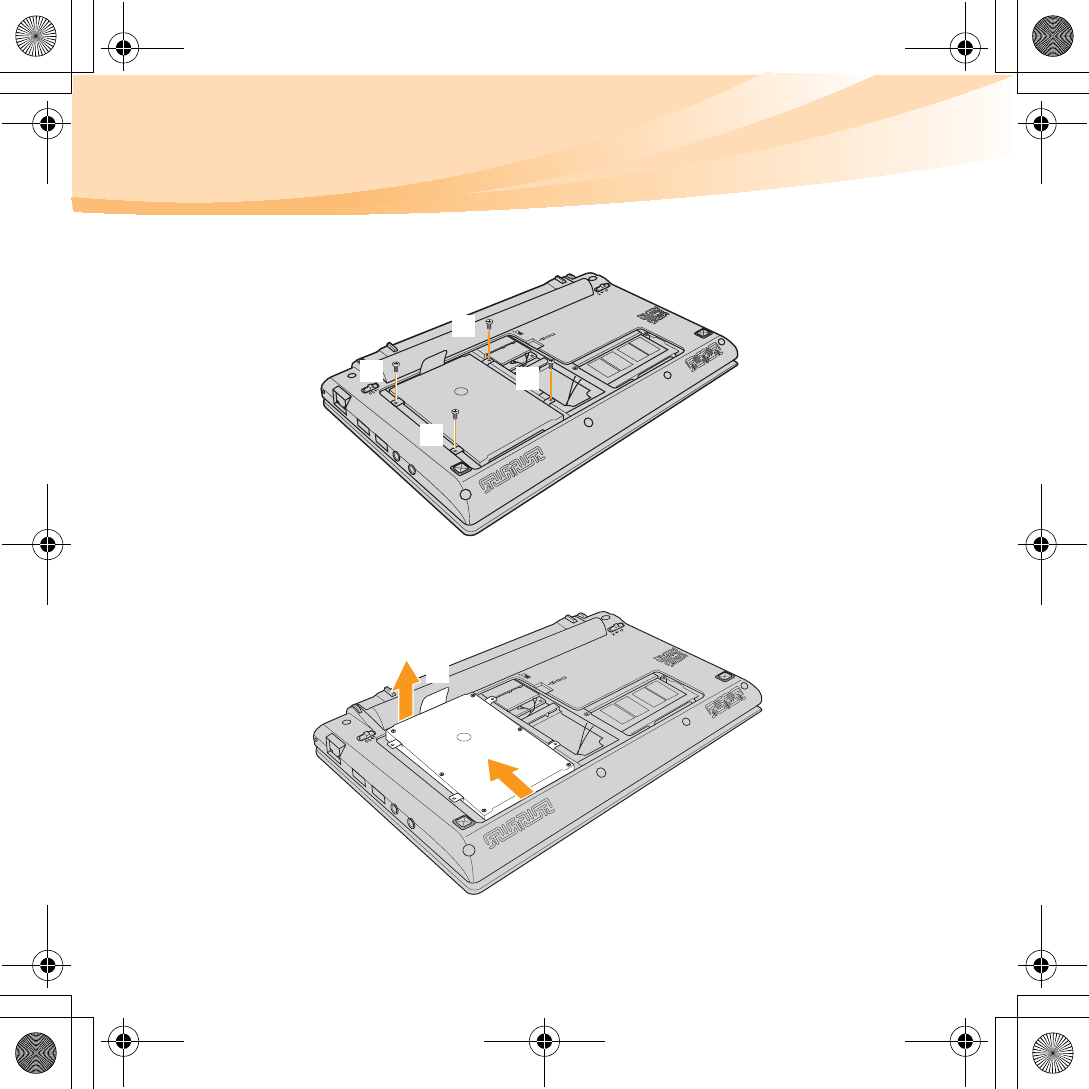
52
Chapter 6. Upgrading and replacing devices
5
Remove the screw that secures the hard disk.
6
Pull the tab in the direction shown by arrow , and take out the hard
disk drive secured in a metal frame .
c
c
c
c
d
e
S10-3 UserGuide V1.0_en.book Page 52 Tuesday, November 10, 2009 11:04 AM
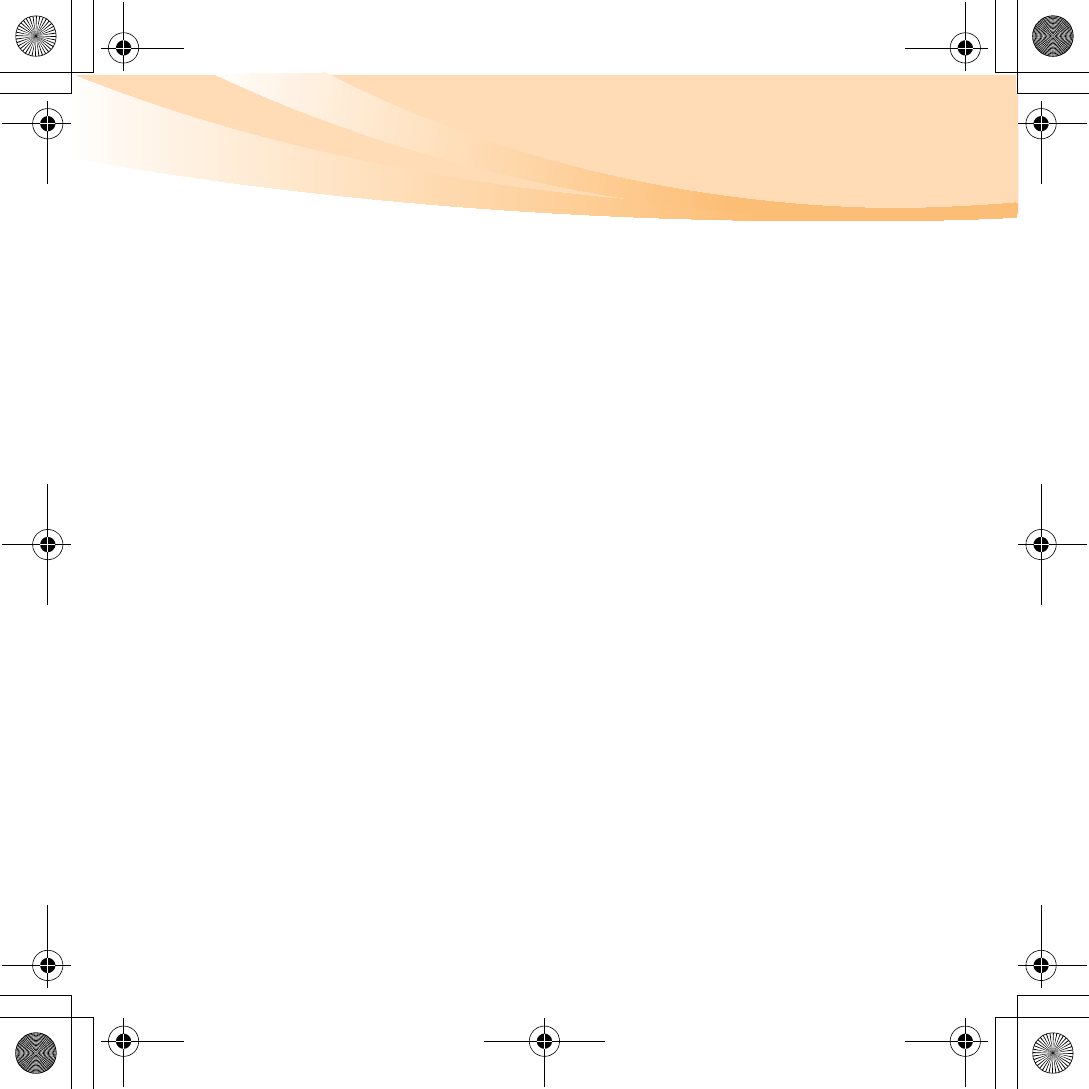
Chapter 6. Upgrading and replacing devices
53
7
Remove the screws and detach the metal frame from the hard disk
drive.
8
Attach the metal frame to a new hard disk drive; then tighten the
screws.
9
Put the hard disk drive gently into the hard disk drive bay with the tab
facing upwards and the connectors facing each other; then push it
firmly into space.
0
Reinstall the screw that secures the hard disk drive.
A
Reinstall the compartment cover.
B
Reinstall the screws.
C
Reinstall the battery pack.
D
Turn the computer over again. Connect the AC adapter and the cables
to the computer again.
S10-3 UserGuide V1.0_en.book Page 53 Tuesday, November 10, 2009 11:04 AM